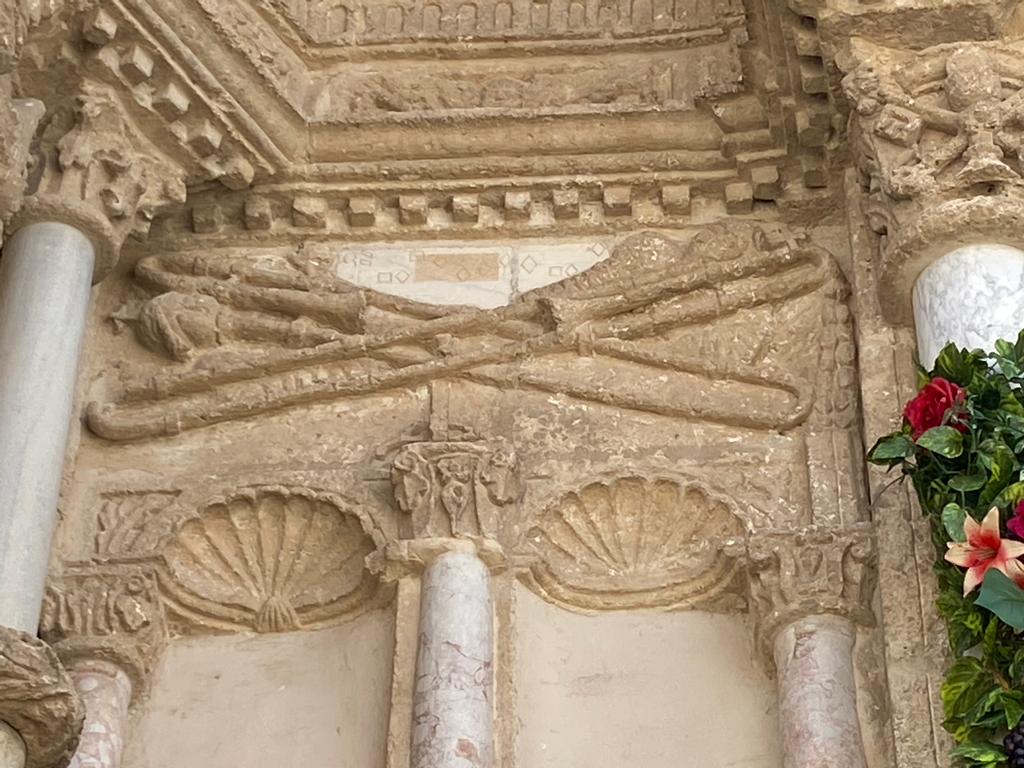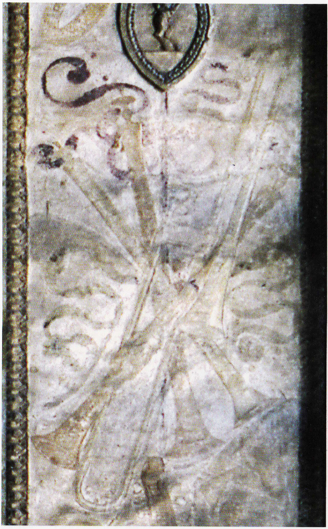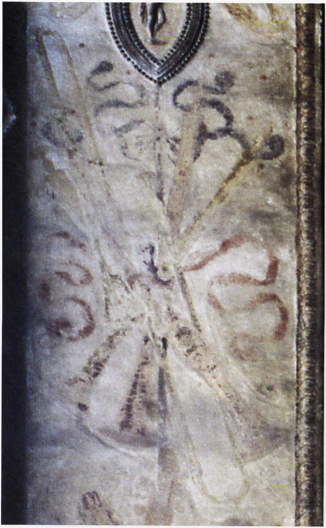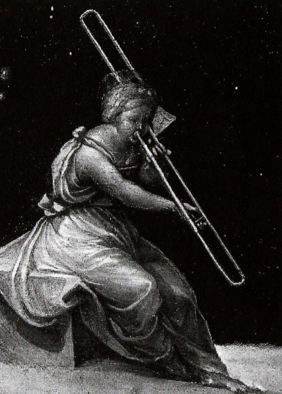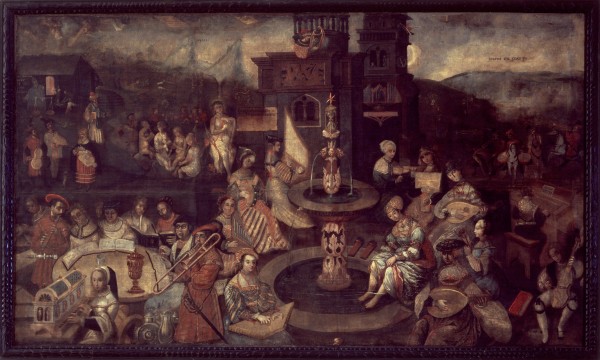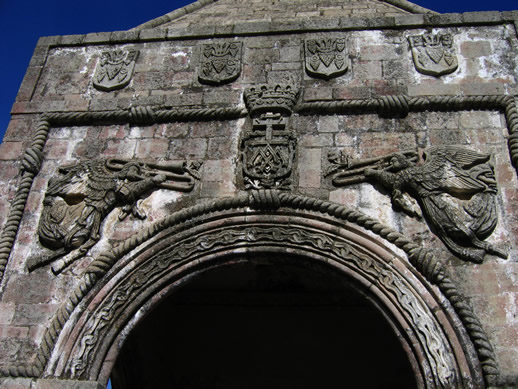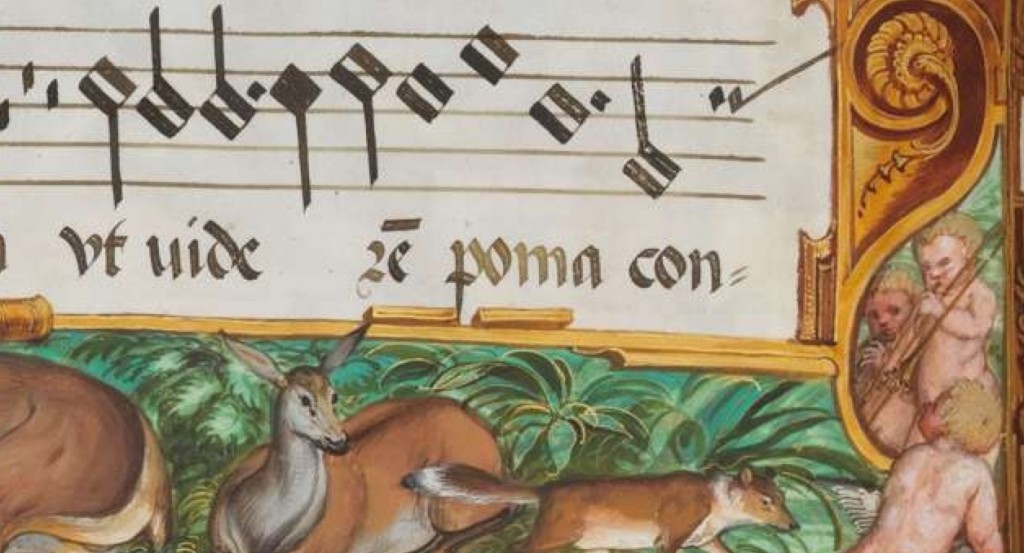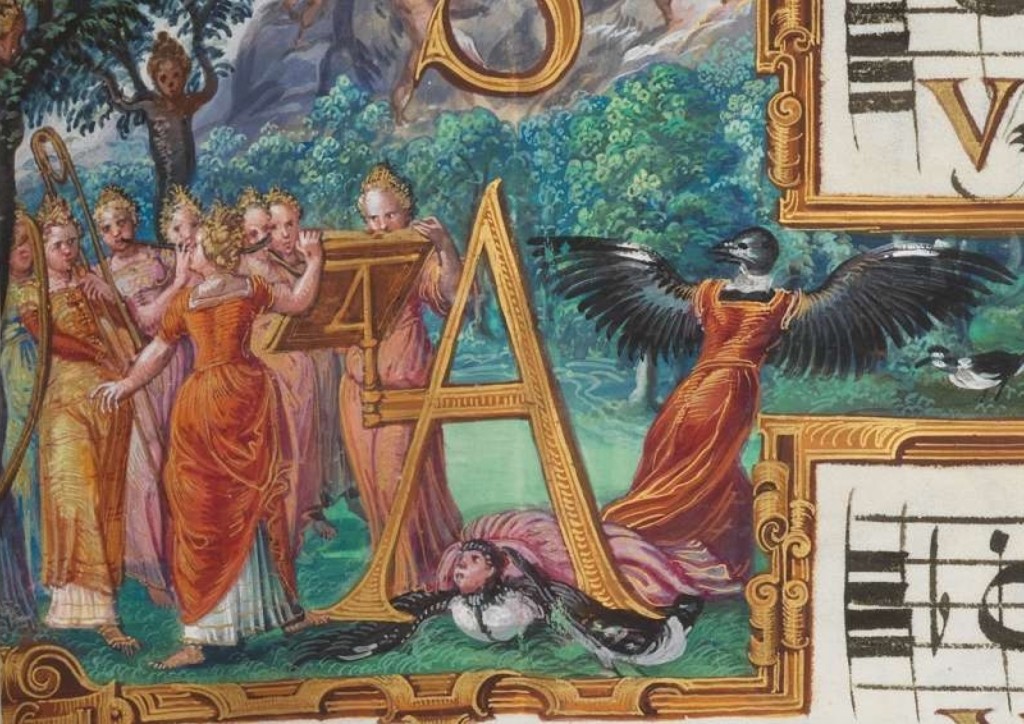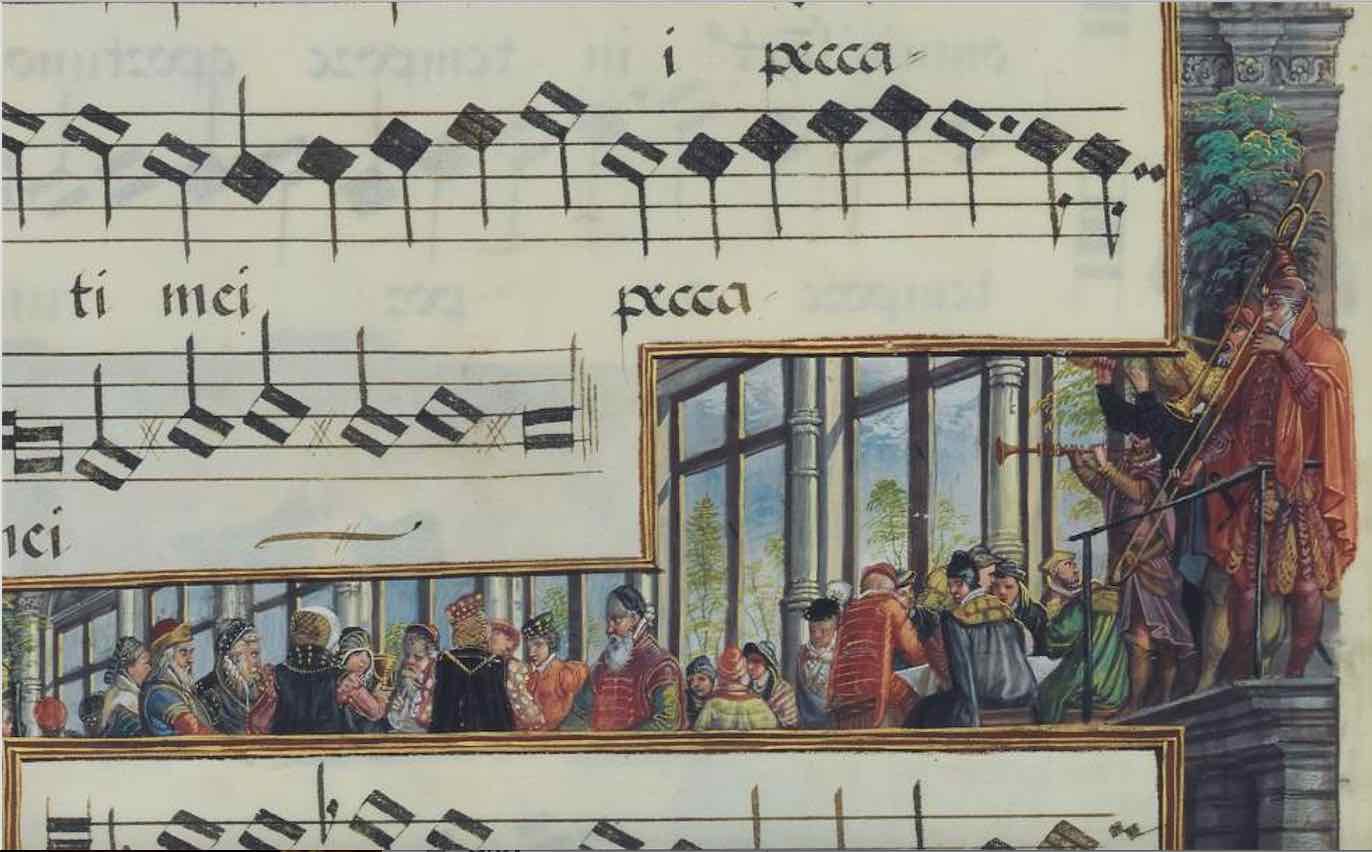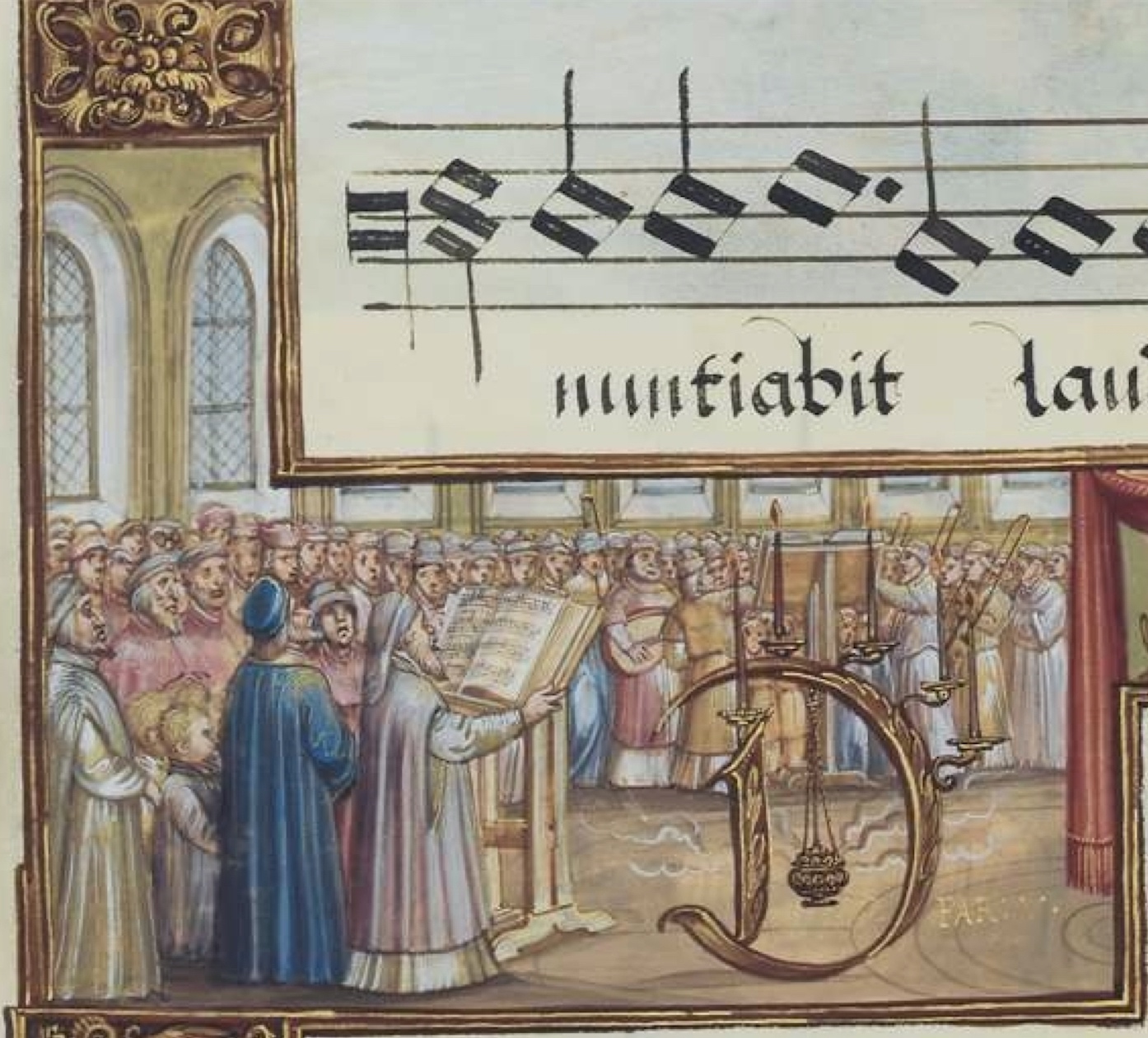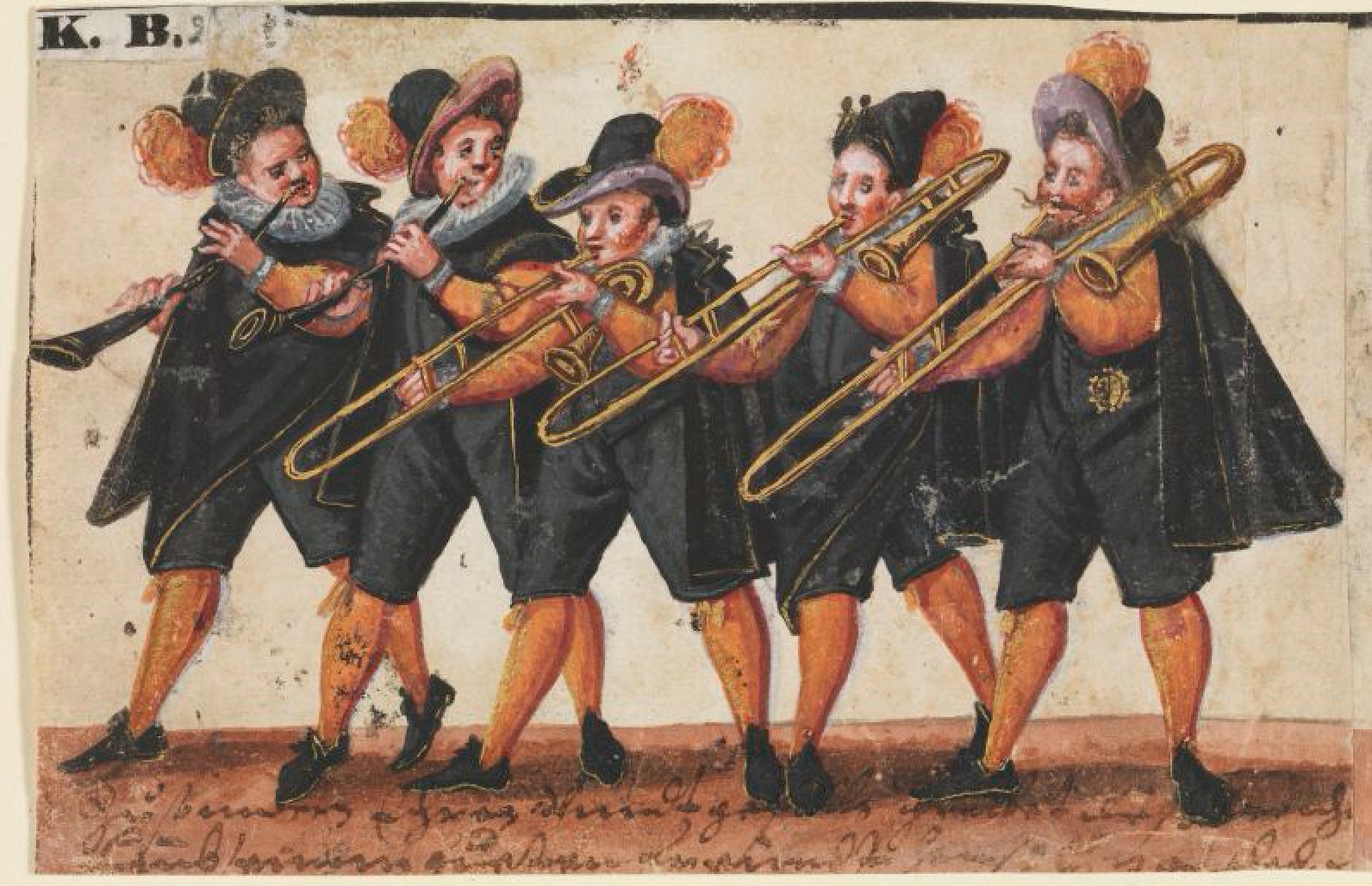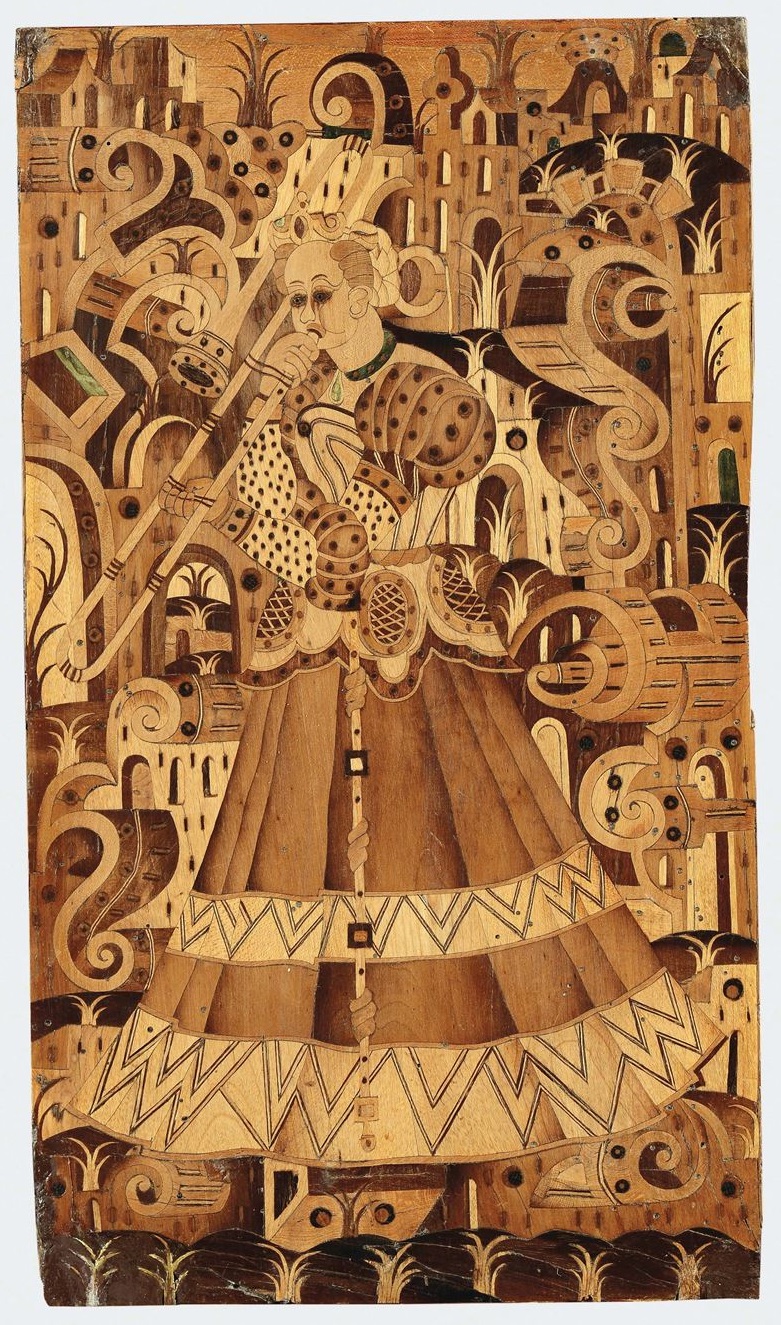A history of the trombone in timeline form. For sources see Trombone History Bibliography.
_______________
Early 16th century—Florence, Italy: Canto di lanzi che suonano, a carnival song by Giovambattista dell’Ottonaio, makes multiple references to trombone, with lyrics featuring extensive double entendre. Trombone and shawm (trombone and piffer) are closely linked as loud instruments (McGee, Information).
16th century—Venice, Italy: An oil painting from the Venetian School depicts a pastoral concert that includes trombone, cornett, cittern, clavichord, violin, and viol (see detail and full image below; public domain). Special thanks to David Van Edwards.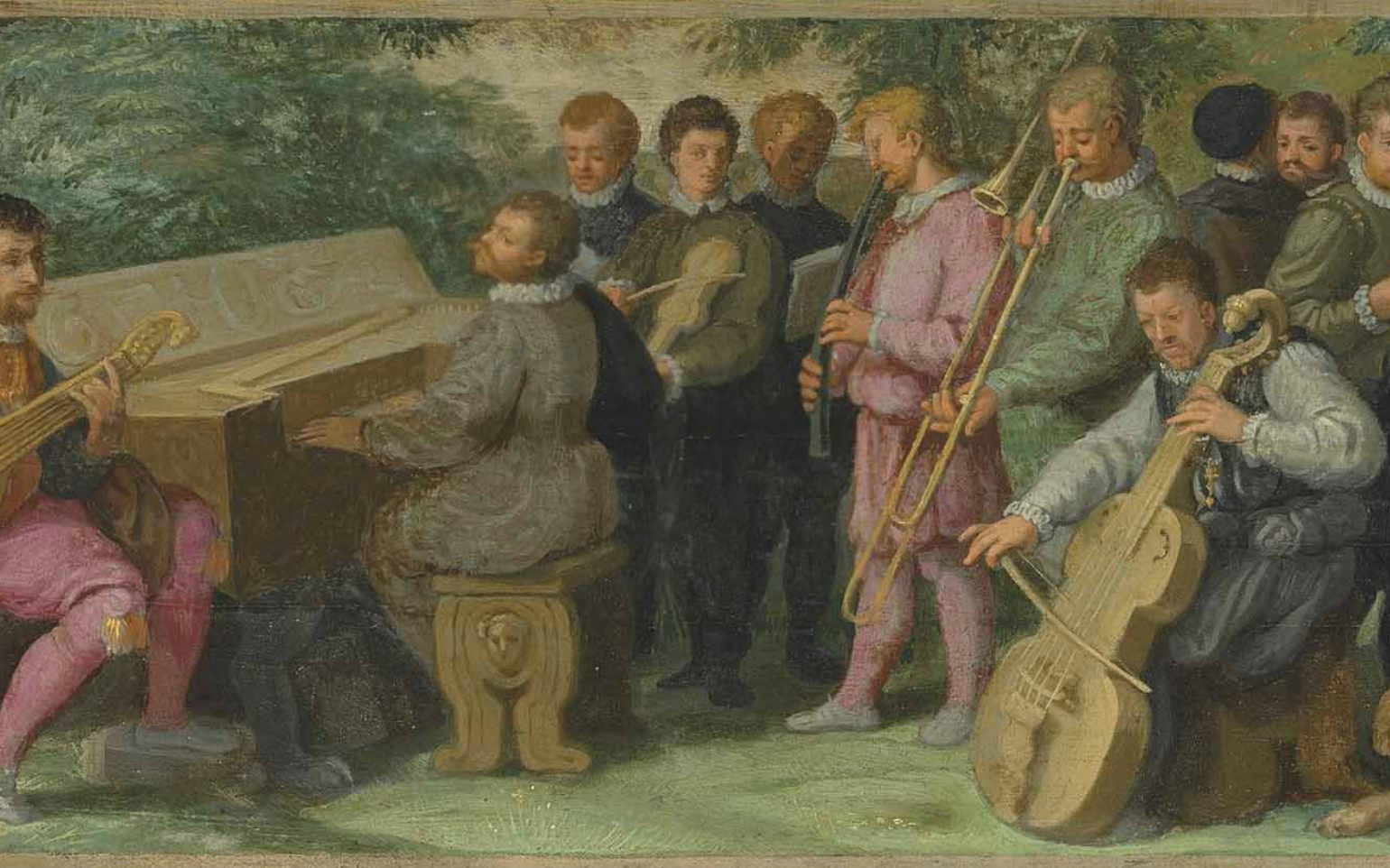
16th century—France: Maius, an anonymous 16th-century woodcut depicting an outdoor scene in France, includes an image of a trombone in the upper-left portion of the border (see below image; public domain) (Paris, Bibliotheque Nationale; Salmen, Gartenmusik 79).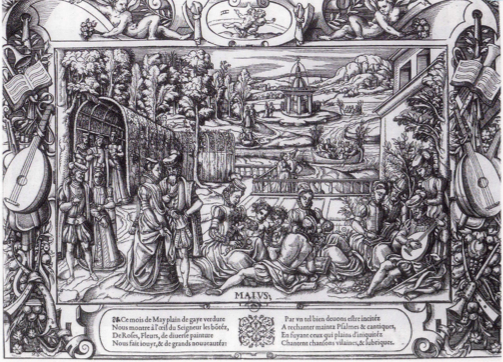
16th century—Poland: A sixteenth-century inventory includes “one large quart sackbut” and “Three small sackbuts” (Przybyszewska-Jarminska, Baroque part I, 65).
16th century—Veroli, Italy: A fresco in the ceiling of Basilica di Santa Maria Salome includes an angel-trombonist performing with cornetto and organ (see below image; special thanks to Paolo Fanciullacci).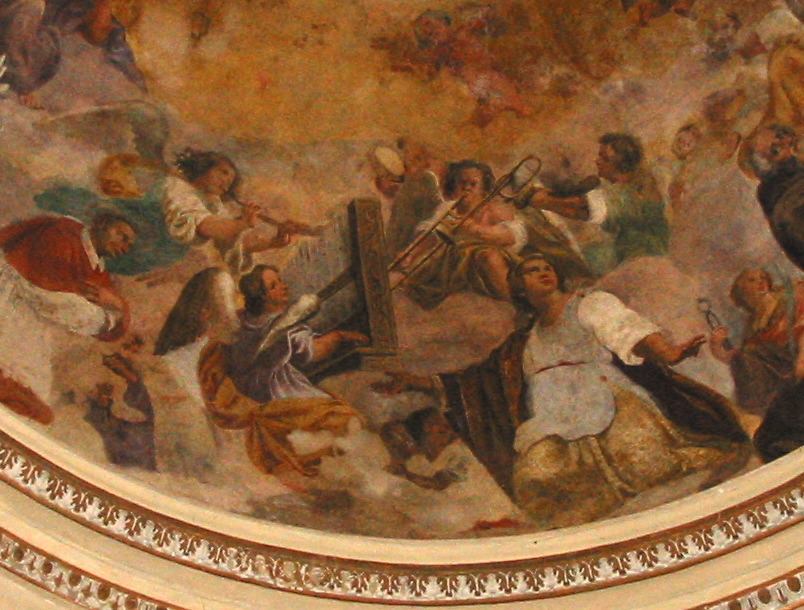
16th century—An anonymous print includes a trombone-playing cherub, or putto (see below image; public domain) (source: Beaux-arts de Paris).
16th century—Mexico: An anonymous painting in the church of San Esteban in Tizatlan, Tlaxcala, depicts a choir of angel musicians consisting of 3 shawms and a trombone facing, on the opposite archway, a choir of singers with guitar (see below image of shawms and trombone; click to expand; public domain) (Starner 110). A wider view of the image can be seen here or here (see upper-right).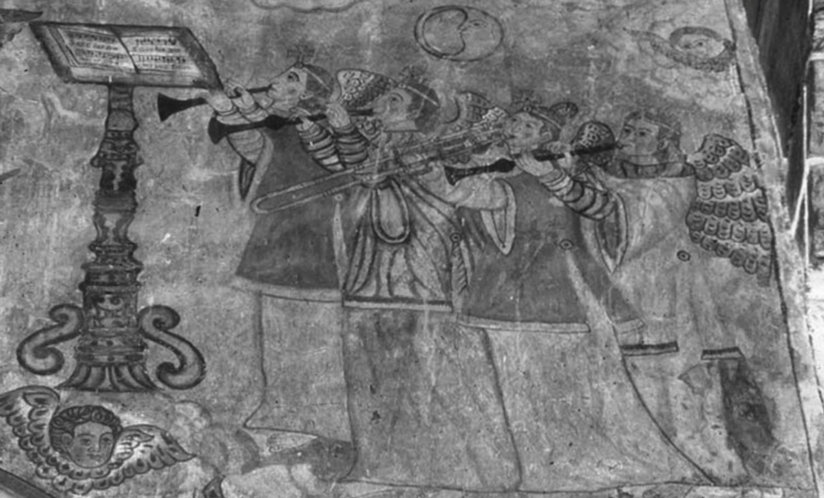
1500-1506—Bologna, Italy: Bolognese civic salary lists include payments 3 piffari, 2 trombones, 5 trumpets, a nakers player, and a harpist (Weiss, Bologna Q 18).
1501—Aalst, Belgium: The town wind band, originally employed as a group of town watchmen, includes “two playing shawms, and the third playing the trompette sacqueboutte.” The ensemble, apparently quite renown, appears frequently at festivals in other Belgian cities such as Dendermonde and Mechelen (Polk, Susato 85).
1501—Hans Nagel and Hans Broen, trombonists at the court of Henry VII, make a state visit to Philip the Fair (Bouckaert and Schreurs 104). Nagel and Broen are the first trombonists specifically named in payment records in England (Herbert, Sackbut 70).
1501-25—Portugal: Assumption of the Virgin (Assunção da Virgem), a painting attributed to Gregorio Lopes, includes an angel playing trombone (see upper-right of below image; public domain) (Museum da Musica, Lisbon).
1501-25—Portugal: Assumption of the Virgin (Assunção da Virgem), a painting attributed to Cristovão de Utreque, includes an angel playing trombone (see detail and full image below; public domain) (Museu Municipal Leonel Trindade).

1502—Mantua, Italy: A second trombone is added to the city’s pifferi (city wind band)(Kurtzman, Trombe).
1502—Brussels, Belgium: The regular instrumentation of the civic wind ensemble is 3 reed instruments (probably 2 shawms and a bombard), plus trombone (Polk, Instrumental).
1502—Louis XII of France travels to Milan, returning with 6 trombonists and shawmists, whom he employs at his court for 120 livres per year (Dobbins, Music 126; Cazeaux 240).
c. 1502-1506—Bologna, Italy: A collection of music later called Bologna Q 18 is compiled, probably for the use of Bologna’s civic wind band (Concerto Palatino), which includes 2 trombones at the time of this collection, or a group of aristocratic amateurs in Bologna capable of reading and playing the music. The original manuscript itself shows physical evidence of being well used. The collection contains more than 70 textless pieces, most of which are for 4 parts (although there are also 19 for 3 parts and 1 for 5 parts). Individual pieces have been attributed to Isaac, Josquin, Compere, and Tromboncino (Weiss, Introduction to Bologna Q 18, 5-12).
c. 1503—Siena, Italy: Bernardino Pinturicchio includes a depiction of a trombonist in his painting, Coronation of Pius III, a fresco decorating the exterior of the Piccolomini Library in the cathedral of Siena. The trombonist is part of a trio of wind players seen performing at center-right (see below detail and full image, below; public domain) (Jenkens 159; Cecchi 19). Documents have shown that trombone did, indeed, perform at this particular coronation (see below).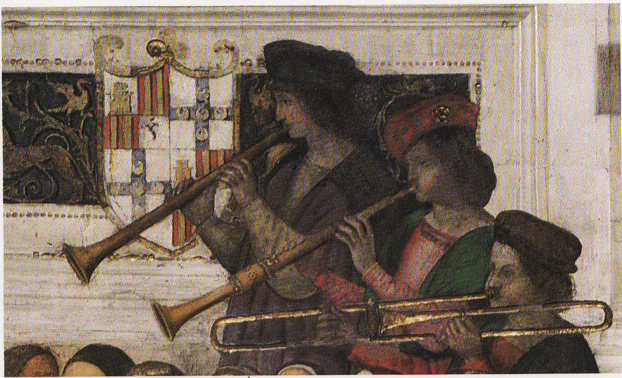

1503—Rome, Italy: At the coronation of Pope Pius III, the Te Deum is sung antiphonally, with responses accompanied by “one cornett and three contorted trumpets, which are commonly called trombones” (“tibia una et tribus tubis contortis quos trombones vulgo appellant”) (Herbert, Trombone 101).
1503—Nuremberg, Germany: Trombones are among the instruments likely performing for an annual carnival celebration (Schembartlauf). An account of the festivities reads, “There were also present all types of trombones [Posaunen], drums and other sounds, just as when a king, prince, or great potentate arrived on horseback.” (Historian Helen Green points out that, by posaunen, it is “indeterminable whether trumpets or trombones are intended here”) (Green, Defining).
1503—Brussels, Belgium: The town civic ensemble, which includes trombone, performs “from the balcony of the theater [vanden speelhuyse], between the acts [tusschen de pauseringe] of the annual play” (Polk, Instrumental).
1503—Innsbruck, Austria: At Maximilian’s chapel, “The sackbuts of the king [saqueboutes du roy] began the Gradual and played the Deo gratias and Ite missa est, and the singers of monseigneur [Philip] sang the Offertory” (Picker 224; Polk, Voices and Instruments). According to historian Keith Polk, the record of this event represents “one of the earliest specific references to participation actually within the liturgy” by a wind player (Polk, Susato 55).
1503/4—London, England: Among the musicians’ liveries for the funeral of Queen Elizabeth, wife of Henry VII, are those for a group of 5 Sackbusshes and shalmoyes (sackbuts and shawms) (De Lafontaine 2).
1503-1529—Spain: A painting by either Joan Gascó or Gabriel Guardia includes what appears to be a trombone-playing angel with a rear-facing instrument. The first detail below shows what is probably the bell, circled in red. The second shows the players in a wider detail so you can see what is behind and above the musicians, and the third image shows the full painting (public domain images) (Ballester; French National Library). This rear-facing or over-the-shoulder trombone is one of several examples from pre-1800, including 1503-1529, c. 1504, 1570, 1578, c. 1615, c. 1660-1670, 1689, 1732, and c. 1795. 
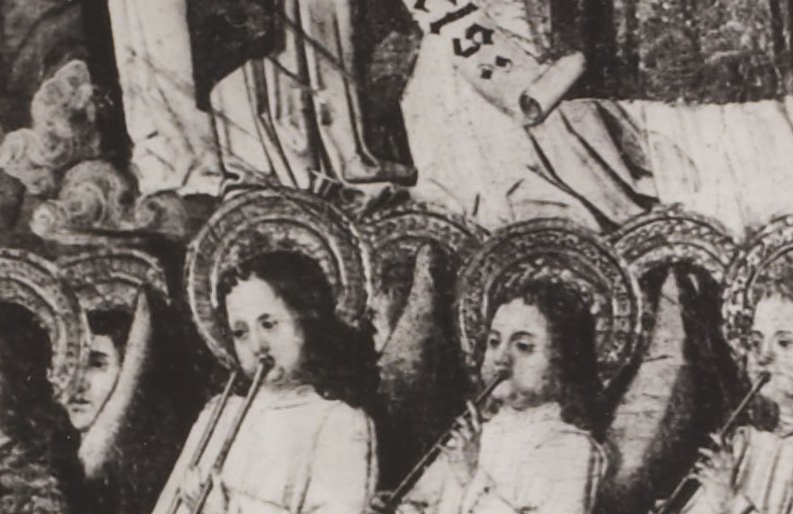

c. 1504—Perpignan, France: A painting on an organ shutter (since relocated to the wall opposite the organ) in the Perpignan Cathedral (Cathedral Basilica of Saint John the Baptist of Perpignan, or Basilique-Cathédrale de Saint-Jean-Baptiste de Perpignan) depicts musicians at the Feast of Herod, including a rear-facing or over-the-shoulder trombone. Although there are some improbable aspects of the trombone, including the shape of the slide and the general configuration of the tubing, it seems unlikely that the artist would have misjudged the actual direction of the bell (see below detail; public domain; special thanks to Jean-Jacques Herbin). The rear-facing or over-the-shoulder trombone is one of several examples from pre-1800, including 1503-1529, c. 1504, 1570, 1578, c. 1615, c. 1660-1670, 1689, 1732, and c. 1795. 
1504—London, England: The number of trombonists at the court of Henry VII drops from 5 to 4 (Bouckaert and Schreurs 104).
1504—Four players named as sacquebouttes travel with Philip to Spain (who is Duke of Burgundy before becoming king of Spain) (Banks, Segovia Codex).
1504—Bremen, Germany: On Ascension Day, the Bremen city musicians play trombones [Basunen], trumpets, crumhorns, shawms, and recorders at the city hall before a Te Deum is performed in the cathedral (Meyer, The Crumhorn, 117).
1505—Venice, Italy: In a letter written by Giovanni Alvise, a city musician, Alvise mentions a piece arranged for trombones alone, an arrangement for 4 trombones and 2 cornetti, and another for trombones and shawms (no specific composers or titles are given). The arrangement for trombones alone may constitute the earliest record of a pure trombone consort piece (Polk, German 73).
1505—Venice, Italy: The civic wind band consists of cornettos, recorders, shawms, and trombones (Polk, Innovation 211).
1505—Mantua, Italy: Records show that trombones and cornettos participate together in a performance (Kurtzman, Trombe).
1505—Spain: Ferdinand V, patron of Columbus, maintains 9 minstrels, including one identified as a player of sacabuche (Whitwell, Before 194).
1506—Naples, Italy: Royal chronicler Andrés Bernáles records the following about a procession of Ferdinand and his retinue into the city of Naples: “And they passed beneath a very richly decorated arch; and on this and all the others, as well as on the bridge, just as his Highness came through, the instruments played and made great rejoicing. These included four pairs of kettledrums and twenty-six s-shaped trumpets, with infinite number of other instruments, such as shawms and sackbuts [sacabuches] etc. They made such a din [estruendo] that if a bird happened to fly past, they made it fall from the sky into the crowd” (Knighton, Ferdinand).
1506—Brussels, Belgium: Trombonist Hans Nagel joins the court ensemble of Philip the Fair, duke of Burgundy (Polk, German 78).
1506-08—Siena, Italy: Palace inventories indicate ownership of a “silver trombone [trombone d’argento] that Girolamo Trombone has” (D’Accone, Civic Muse 586).
1507—Augsburg, Germany: Erhart Öglin publishes Melopoeae sive Harmoniae tetracenticae super xxii genera carminum by Petrus Tritonius, an Austrian humanist and composer. Among the musical content are two different woodcuts depicting what appear to be trombone players. In the first, what is apparently a trombone is included among a band of minstrels (the group of musicians on the left). In the second plate, in which the nine muses surround Apollo, Jupiter, Minerva, and Mercury, an instrument with two bells, representing either a trumpet or a trombone (or perhaps both), is being played by the muse Urania (see below 4 images; public domain).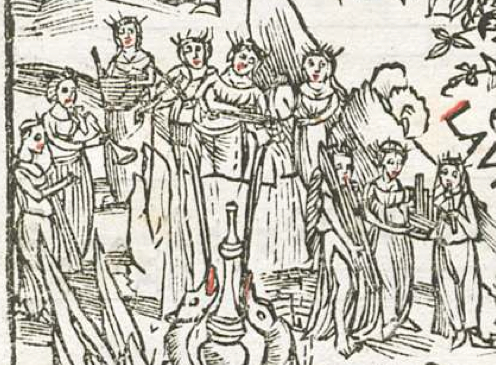
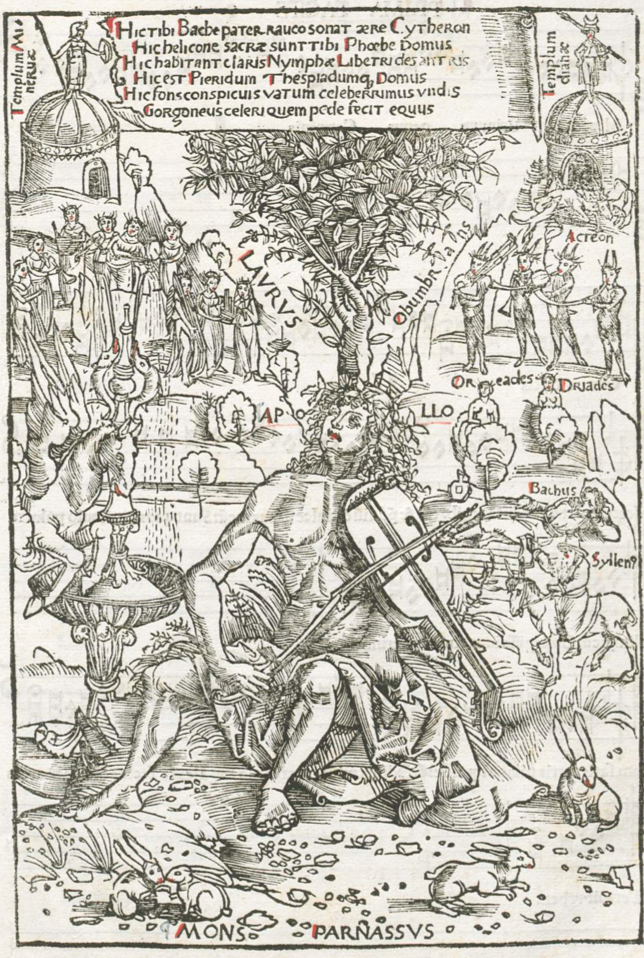
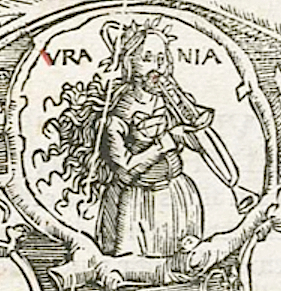
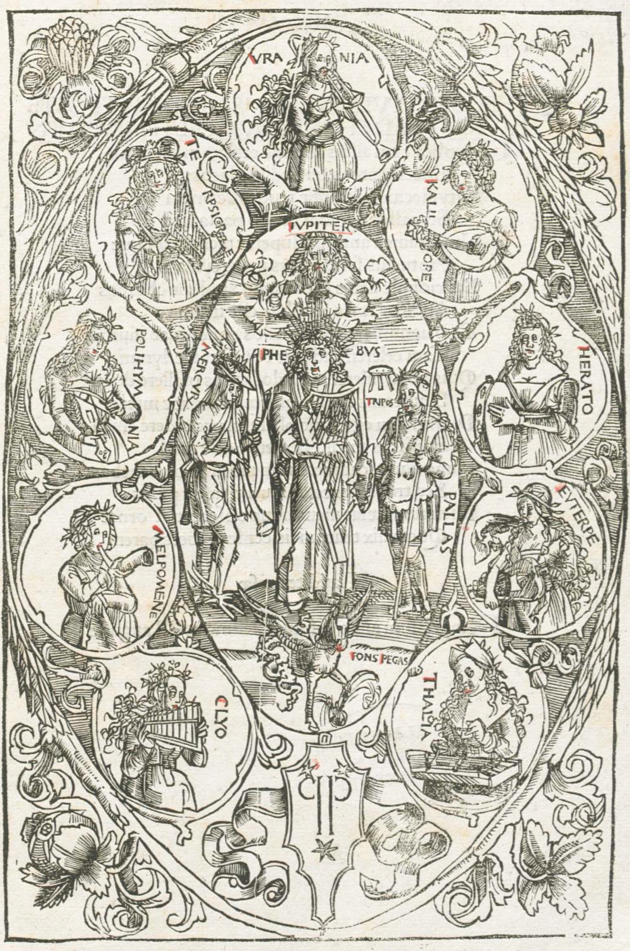
1507—Upon the Death of Philip the Fair, trombonist Hans Nagel is assigned to the court of Margaret of Austria, acting regent of the Low Countries (Polk, German 78).
1507—Utrecht, the Netherlands: The city retains 2 trombonists in its wind band, Claus Winckel and his uncle, Jan van den Winckel. The latter had previously been employed by Philip the Fair and later joins the court ensemble of Henry VIII (Polk, Susato 78).
1508—Bologna, Italy: A charter titled Provisio edita per Magnificos Dominos Antianos super eorum familia provides instruction for a 13-member instrumental ensemble that includes harp, nakers, six trumpets, three piffari, and two trombones (Weiss, Music Patronage).
1508—Gonesse, France: In what may constitute the earliest non-Italian visual depiction of the trombone (see also 1503-1529, above), a painted panel on the organ balcony at Abbey Eglise Saint-Pierre et Saint-Paul features an angel-trombonist. Other instruments depicted include viol, shawm, crumhorn, harp, lute, and organ (see detail and full image below; public domain). Click on full image for larger version (Fischer, Organology; Luri, Les Anges).
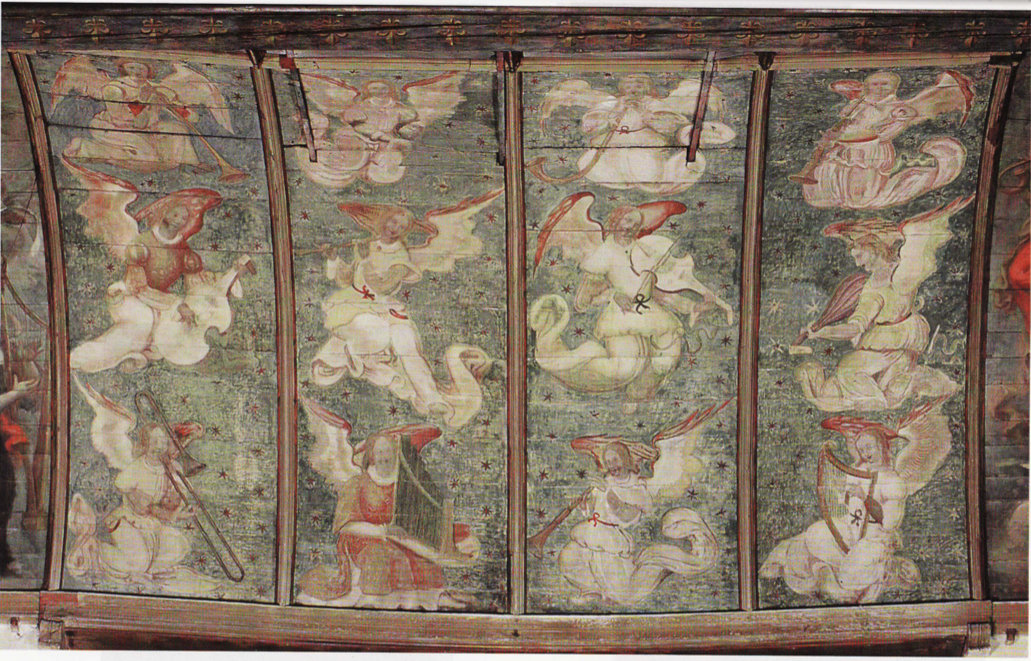
1509—Urbino, Italy: In Castiglione’s Book of the Courtier, one of the characters shares a joke involving a Brescian who visits Venice during the feast of the Assumption and sees a trombone for the first time. The country visitor mistakenly assumes the trombone tubing extends down the player’s throat as the trombone slide retracts (Cavallo, Joking Matters).
1509—Augsburg, Germany: A musician by the name of Caspar Egkern serves as trombonist. He later becomes a member of the viol ensemble of Maximilian I (Polk, German 71).
1509—London, England: The King’s Music includes 4 Seykebuds and Shalmeys (sackbuts and shawms). Another record, that same year, calls the instruments Sakbudds and shalmes of the Privee Chambre (De Lafontaine 3; Whitwell, Renaissance 15).
1509—London, England: 4 Sakbudds and shalmes (sackbuts and shawms) perform at the coronation of Henry VIII (Whitwell, Renaissance 15).
1509—London, England: The term sackbut (or a derivative) is mentioned for the first time in an English narrative source: Steven Hawes, Passetime of Pleasure, an epic about courtly life, where Sakbuttes are describes as part of the mynstralsy (Herbert, Susato 121).
1509—Brussels, Belgium: Though it is after the death of Philip the Fair, trombonists Hans Nagel and Jan van Winckel are paid for “having served continually before [Philip] in his chapel, singing and playing daily, in discant, of the hours and divine service” (Polk, Instrumental).
1509/10—Trombonist Hans Nagel is now called “Master Hans,” a token of exceptional performance abilities. He joins the civic ensemble in the service of Margaret of Austria in Mechelen, Belgium, where he continues to perform until 1518 (Polk, German 78).
c. 1510—Torrijos, Spain: Above the front door of the Colegiata del Santisimo Sacramento de Torrijos is a pair of trombones with slides crossed (see below image; public domain). Special thanks to Elies Hernandis Oltra.
c. 1510—Brescia, Italy: A plaster decoration in Santa Maria delle Grazie features what appears to be a trombone with somewhat elongated bell and an extra length of tubing, or tortil (see below image; public domain). Special thanks to Michele Magnabosco.
 1511—Basel, Switzerland: Sebastian Virdung’s Musica getutscht, the first printed treatise on Western musical instruments, includes a woodcut of a trombone, labeled Busaun, that closely resembles the earliest surviving trombones (tenor trombones by Erasmus Schnitzer and Jorg Neuschel) (see above image; public domain) (Virdung 108). Virdung also mentions the trombone in a Biblical context, translating the Latin phrase tubis ductilibus to zehenden Busaunen (slide trombone): “And then [in] Psalm 97: ‘Sing sacred songs to the Lord in the harp and in the sound of the psalm. Praise Him in the slide trombone [in den zehenden Busaunen] and in the sound of the trumpet [made] of horn’” (Virdung 98).
1511—Basel, Switzerland: Sebastian Virdung’s Musica getutscht, the first printed treatise on Western musical instruments, includes a woodcut of a trombone, labeled Busaun, that closely resembles the earliest surviving trombones (tenor trombones by Erasmus Schnitzer and Jorg Neuschel) (see above image; public domain) (Virdung 108). Virdung also mentions the trombone in a Biblical context, translating the Latin phrase tubis ductilibus to zehenden Busaunen (slide trombone): “And then [in] Psalm 97: ‘Sing sacred songs to the Lord in the harp and in the sound of the psalm. Praise Him in the slide trombone [in den zehenden Busaunen] and in the sound of the trumpet [made] of horn’” (Virdung 98).
1512—Venice, Italy: A trombonist who is a member of the Doge’s wind ensemble is identified as Ser Jheronimo trombon. This trombonist is possibly Jeronimo Bassano, patriarch of a long line of wind musicians in Italy and England (Lasocki, Bassanos).
1512-13—Mechelen, Belgium: Trombonist Jan van den Winckel joins the town wind ensemble, increasing the group’s size to 5 (Polk, Susato 67, 81).
1513—Spain: In the triumph to Victory commemorating the conquest of Navarre, “some well-composed songs” are performed on “seven ministriles altos, four sackbuts and three cheremias [shawms]” (Rincón 106).
1513—Trumpets, drummers, and sackbuts accompany Henry VIII to France (Marcuse 809).
c. 1514—Augsburg, Germany: A biography of Maximilian includes a woodcut by Hans Burgkmair, captioned “How the young Weisskunig learned to know music and string playing.” The woodcut depicts the young king, surrounded by musicians, music books, and musical instruments, including a trombone. The trombone rests on a pair of drums on the bottom-right (see below image; public domain) (Komma 81; Picker 233).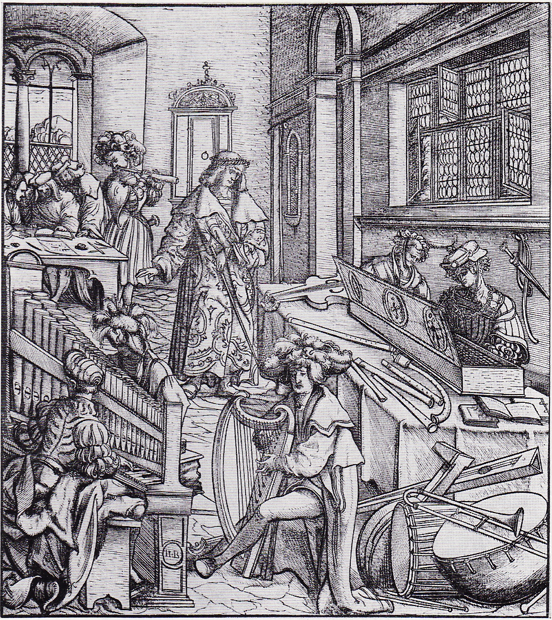
1514—Rome, Italy: Cardinal Giulio writes, “There arrived here [in Rome] the music of pipers and trombone players from Cesena, but I don’t believe it is of outstanding quality; I have the impression that one calls there [in Florence] good music the one that costs little, and it seems to me that his Excellency does not enjoy it as does the Pope” (Lowinsky, The Medici Codex 33).
1514—Florence, Italy: 2 trombone players are listed as part of the civic wind band (McGee, Service).
c. 1515—Lisbon, Portugal: Assumption of the Virgin, a painting that originally functions as the center panel of an altarpiece in Lisbon’s Convento da Madre de Deus, features numerous angel musicians, including a trombonist. The artist, referred to variously as Portuguese School, Mestre de 1515/Master of 1515, and Mestre de Madre de Deus/Master of Madre de Deus, may be Afonso Jorge (see detail and full image below; public domain) (Museu Nacional de Arte Antiga, Lisbon). Sources: de Oliveira Alves; Carter, Renaissance 345. Image sources: wikimedia; MatrizNet.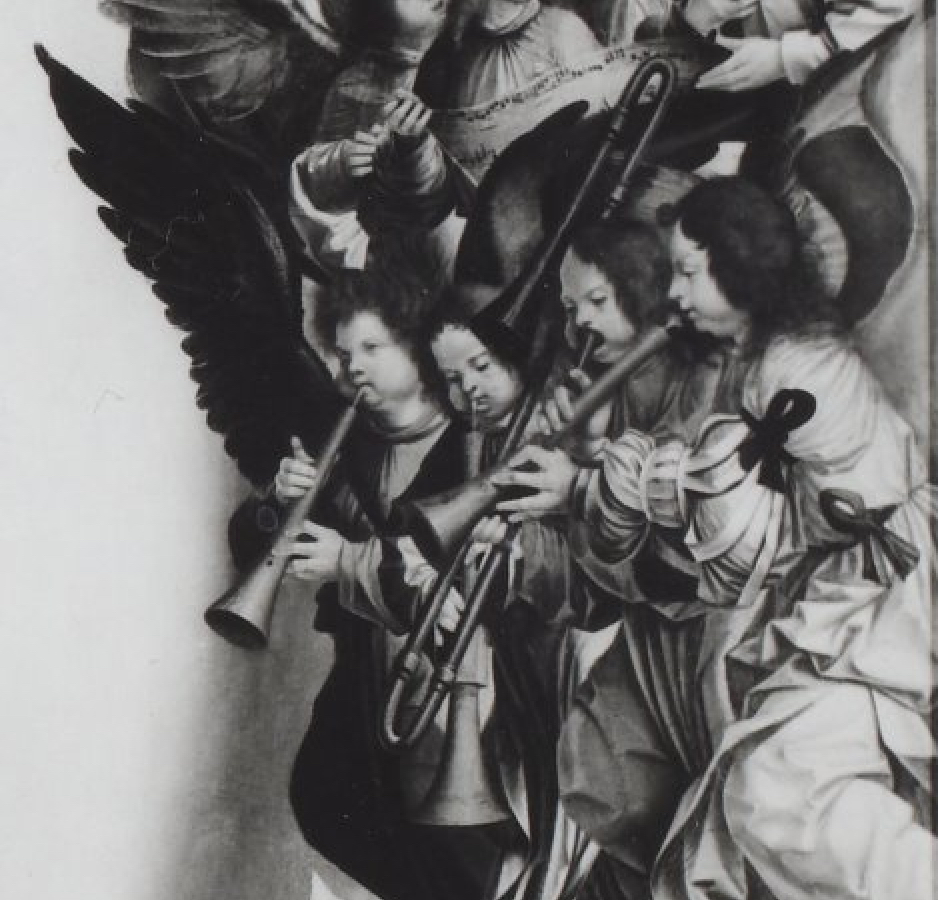
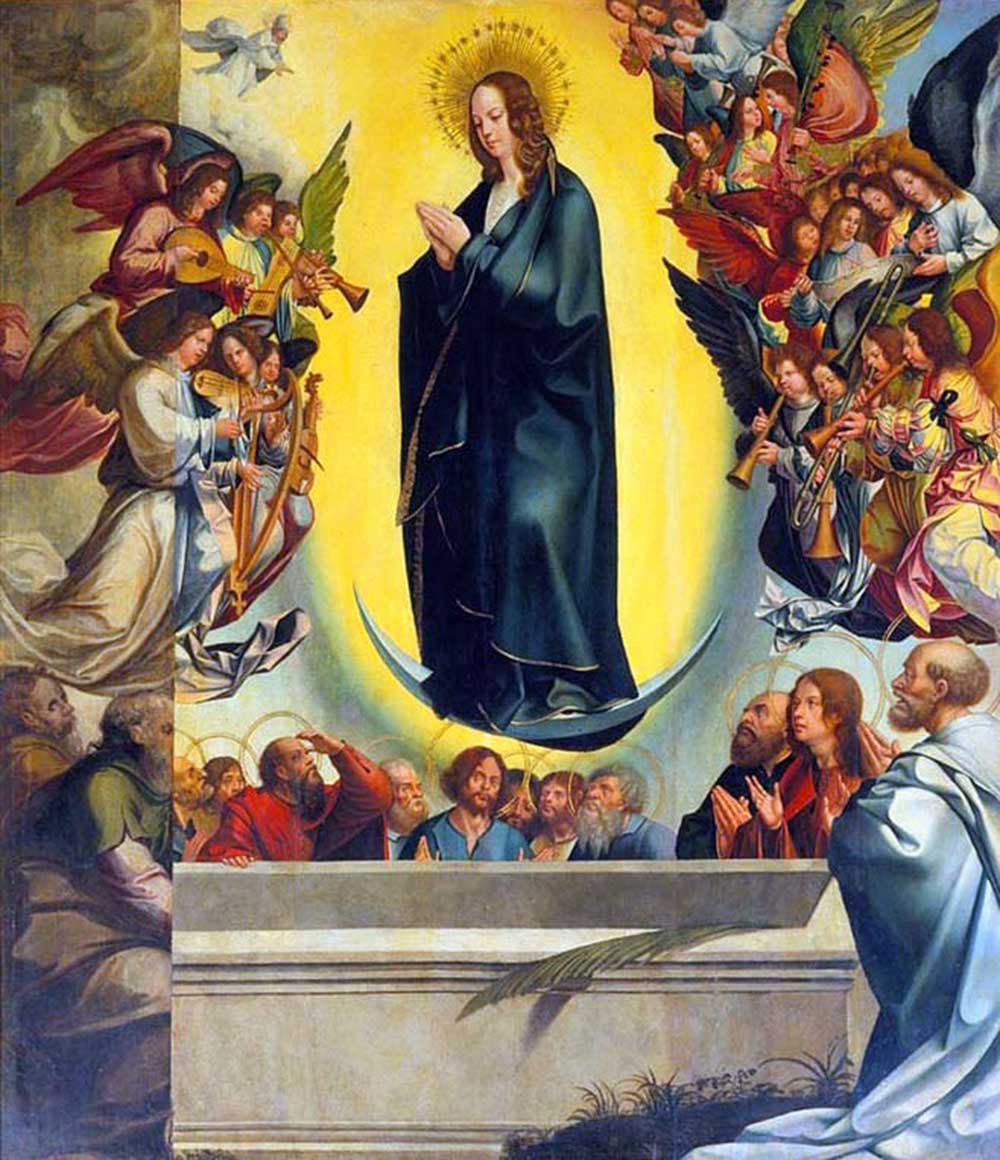
1515—Trombonist Hans Nagel, who, as a respected musician, has moved freely among nobility throughout Europe, is hired as a spy by King Henry VIII of England. Henry is particularly concerned about obtaining more information about Richard de la Pole, known as the White Rose. De la Pole, an exiled duke of Suffolk, lives in Metz, France, and apparently has remote claims to the throne. Hans Nagel agrees to make contact with de la Pole, which he apparently does in the following years. Nagel then apparently develops a close enough relationship with de la Pole that Henry expresses concern that Nagel has become a double agent. Henry calls Nagel back to England, but Nagel refuses to return without amnesty. In a letter of 1517, an Ambassador Tunstall claims to have discovered that Nagel is clearly acting as a double agent. Nagel never returns to England (Bouckaert and Schreurs 109).
1515—London, England: The Queen is entertained by a pageant, a moving stage that features numerous musicians, including sackbuts (Stevens, Music & Poetry 250).
1515—Venice, Italy: Wind players employed at St. Mark’s are required to be able to play multiple instruments, including trombone, shawm, recorder, and cornett (Glixon, Honoring God 131).
1515—France: At the coronation of King Francis, music is provided by a band of shawms and sackbuts (sacqueboutes) (Whitwell, Renaissance 66).
1515—Vienna, Austria: At the Congress of Vienna, hosted by Emperor Maximilian I, a fanfare is performed by 45 trombones, 45 trumpets, and 6 timpani (Whitwell, Before 1500 253).
1515-1547—France: Francis I reigns as king of France. His household musicians, particularly the group called musique de l’écurie, include violins, oboes, and trombones. Use of trombone in the ensemble continues into the 17th century (Heider 45).
1516—Freiburg, Germany: Hans Baldung’s painting, Coronation of the Virgin, the central panel of an altarpiece located in the Freiburg Cathedral, includes an angel-trombonist among a group of angels playing wind instruments. The trombone is in the upper left of the full image (see detail and full color image below; click to expand; public domain) (Burkhard pl. 2).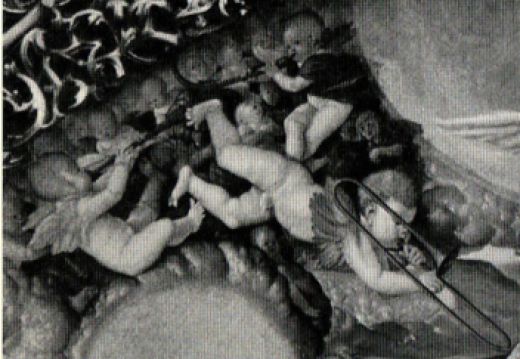
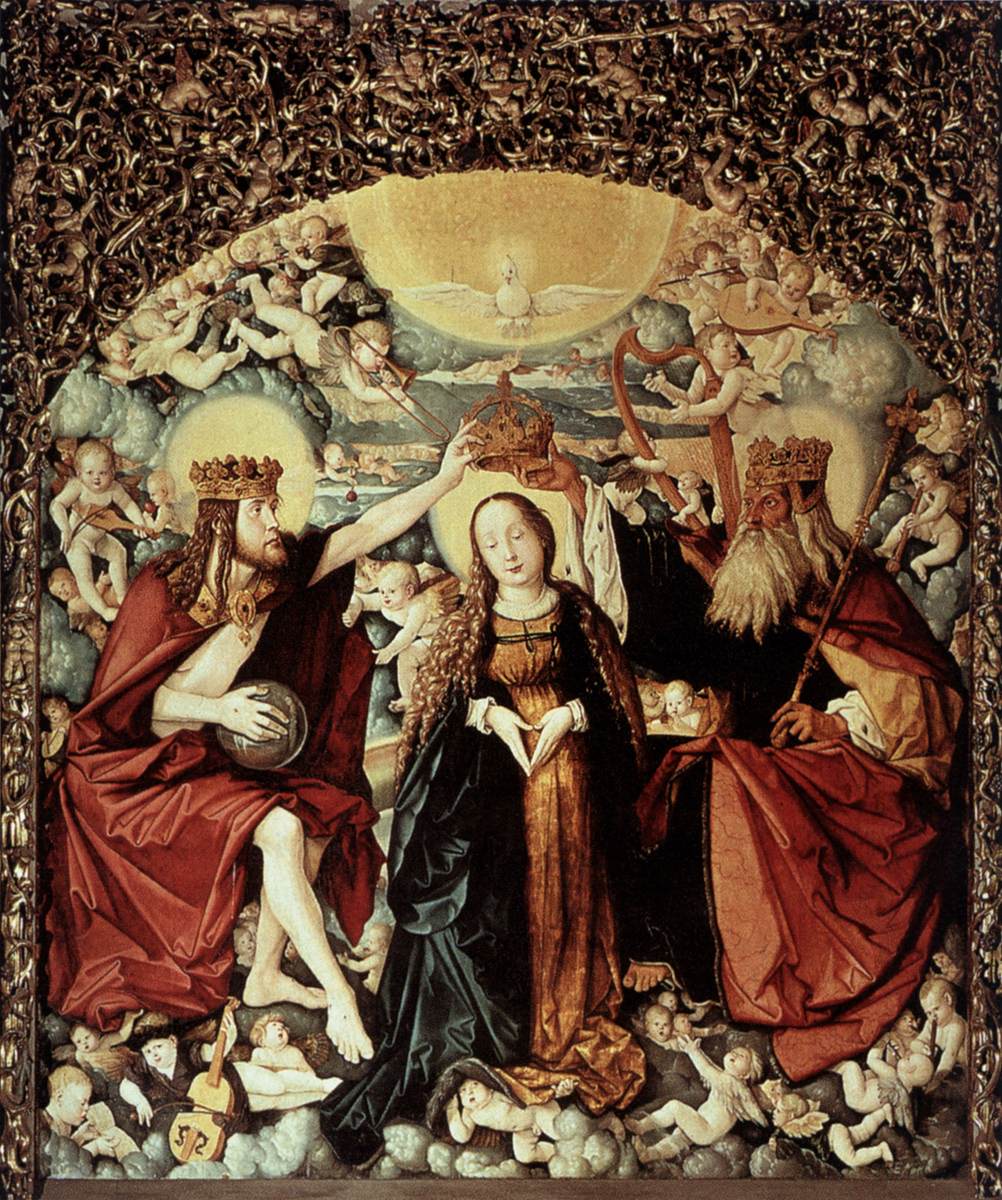
1516—London, England: Flemish trombonists are hired as performers for the court of Henry VIII (Kisby, Royal Minstrels).
1516—Mantua, Italy: A third trombone is added to city’s pifferi (city wind band) (Kurtzman, Trombe).
1517-1519—Rome, Italy: Two paintings by Giovanni da Udine on the colonnade of the Loggia of Raphael in the Vatican include trombone in a trophy (or decorative cluster) of musical instruments representing a shawm band (see below 2 images; public domain) (Myers, Instrument Trophies). The images are badly deteriorated but are also reproduced in the 18th century by Giovanni Volpato (see 18th century timeline).
1518—London, England: The King’s Musick includes 3 sackbut players: John van Herten, John van Vincle, and Nicholas Forcivall (Woodfill 296).
1518—Paris, France: The betrothal of Princess Mary, daughter of Henry VIII, to François, eldest son of François I, King of France, takes place in Greenwich, England, with a repeat performance in Paris. The festivities in France include a dance performed by a wind band that probably consists of 3 shawms and 2 trombones (“two brass which were bent back”). Specifically, the wind band “played a pavan in the Milanese manner, to whose rhythms, the King, together with a number of the nobles, danced twice, most elegantly.” Then, later, according to the same record, “The wind players again played a pavan in the Milanese style, with forty couples dancing continually. Nor was anyone allowed to dance unless they were masked” (Shaw). Frenchman Thoinot Arbeau mentions a similar dance, a pavan danced by nobility and accompanied by shawms and trombones, in his dance treatise of 1588 (see below).
1518—Berlin, Germany: At the Brandenburg court, wedding festivities of the Margrave Casimir of Brandenburg and Dorothea Pfalzgrafin bei Rhein include a band of trombones and cornetts (Whitwell, Renaissance 115).
1518—Nuremberg, Germany: The Stadtpfeifer, including trombonist Hans Neuschel, are allowed the special honor of standing, as part of the Schembartlauf carnival, upon the grand pageant wagon that is drawn through the streets to mark the end of the city’s carnival (Green, Defining).
1518—Florence, Italy: An intermedio is performed in the Palazzo Cedici for Lorenzo de’Medici and his new wife, Madeleine de la Tour d’Auvergne. Scoring calls for 4 trombones during the fifth act (Brown, Sixteenth-Century Instrumentation, 87).
1519—Trombonist Hans Nagel relocates to Antwerp, Belgium, where he performs with the city ensemble until his death c. 1532 (Polk, German 78)
1519—Bergen op Zoom, the Netherlands: A payment is made to “Christoffe the sackbut for playing bascontre on his instrument with the singers.” He is probably trombonist with the town wind band, a group of 4 players (Polk, Susato 85).
1519—Barcelona, Spain: Trombones are part of an ensemble that is apparently stationed near the cathedral door. The knights of the Order of the Goden Fleece enter the cathedral through the main door, whereupon “the minstrels and trombones [sacabutxos], the clarions and trumpets, began to sound” (Kreitlein, Minstrels in Spanish Churches).
c. 1520—Lisbon, Portugal: The Engagement of St. Ursula and Prince Etherius (sometimes also titled St. Ursula and Prince Etherius Making a Solemn Vow or St. Ursula Meeting with Prince Conan), a panel painting from the Master of Saint Auta Altarpiece, depicts a trombonist with a wind band performing from a loft or window. The painting, originally located in Convento da Madre de Deus, Lisbon, may represent the earliest visual depiction of a black trombonist (see detail and full image below; public domain) (Lisbon, Museu Nacional de Arte Antiga, Inv. No. 597) (Bowles, Musikleben 30-31).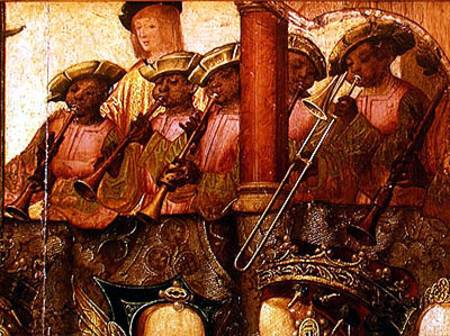

c. 1520—Nuremberg, Germany: A mural attributed to various artists, including Hans Holbein and Albrecht Dürer, depicts 2 trombonists as members of the town wind band playing from a balcony (see below image; public domain) (Hindley, 113; Lang, Pictorial History 17).
c. 1520—Rome, Italy: Polidoro da Caravaggio (the less-famous Caravaggio, sometimes known as Polidoro Caldara) paints Apollo with the Muses, which includes a depiction of one of the muses playing trombone (see 1st two images, below; public domain) (Fürst Liechtenstein Museum, Vienna, Inv. GE207). A second panel of the painting also depicts a trombone, this one leaning against an organ (see 3rd and 4th images, below; public domain). The panels are part of a chest or case. Both images are reproduced in Paul Schubring, Cassoni (Leipzig, 1915, Pl. 847 and 846). Click images to expand.
c. 1520-40—Castelo de Paiva, Portugal: Assumption of the Virgin (Assunção da Virgem), a painting by Mestres de Ferreirim at Igreja Nossa Senhora da Assuncao, Sardoura, depicts an angel-trombonist as part of a shawm band (see detail and full image below; public domain).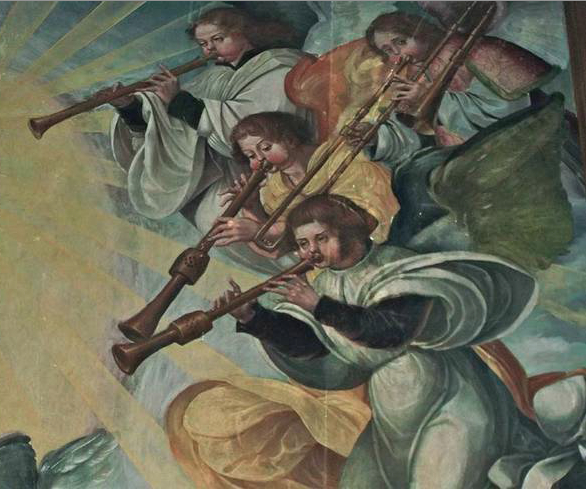
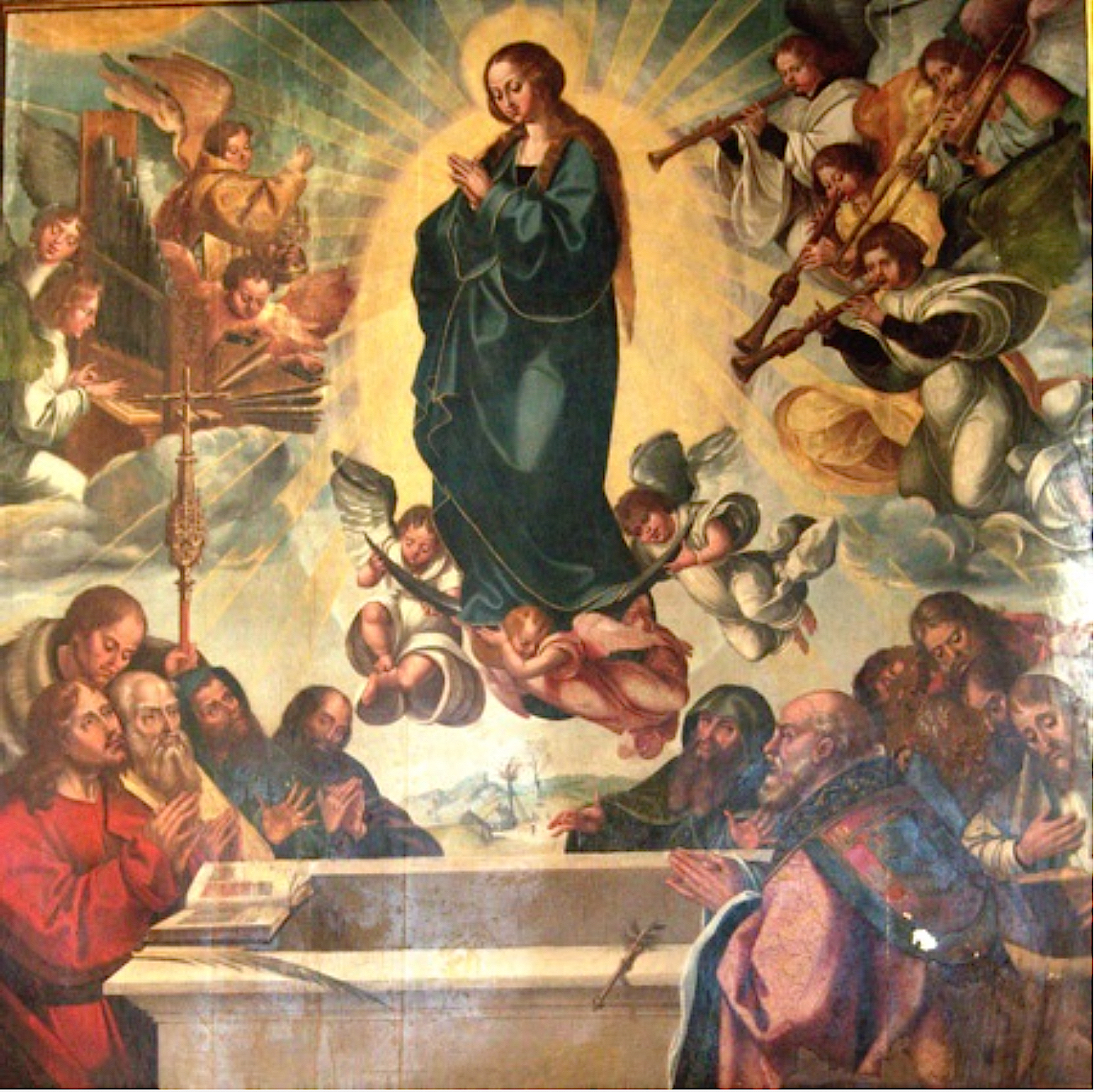
1520—Germany: Martin Luther, in a letter to John Lange (who had been entreating Luther to suppress a book he was publishing), mentions Lange’s use of trombone as a metaphor: “If my little book, that you, my father, name a trombone [posaune], is really so fierce, I leave you and others to judge” (Luther-Currie 55).
1520—Rome, Italy: Marcantonio Michiel, a Venetian patrician, records the following in his diary: “On 2 August the pope hosted a sumptuous luncheon and dinner for whichever cardinals wished to come, both all the cardinals, and many others. And after dinner he presented a musical concert, on which he spent 500 ducats, as follows. First some ten musicians, dressed in violet, performed a Bergamasque song, singing and playing in alternation with a lirone, two flutes, a lute and a clavicembalo. Then another group, dressed in yellow, performed a German song, singing and playing in alternation on trombones [tromboni] and cornetts. Then yet another group, dressed in pink, sang a Spanish song, playing it alternately on lironi. Then crumhorns. Then boys, who sang in the English manner. Then all the instrumentalists and singers sang and played together in twelve parts” (Blackburn, Music and Festivities).
1520—Rome, Italy: Marcantonio Michiel, a Venetian patrician, records the following in his diary: “On Sunday 24 June, the day of St. John….the pope hosted a dinner, also in the Castello, where there was a musical performance by eight voices, eight lironi, seven flutes and a trombone” (Blackburn, Music and Festivities).
1520—Rome, Italy: Records list 2 trombonists, Zacharia and Francesco, as musicians in the court of Pope Leo X (Blackburn, Music and Festivities).
1520—France: Just before the famous meeting of the Field of Cloth of Gold, Sir Richard Wingfield, English ambassador to France, reports the following to Cardinal Wolsey, chancellor for Henry VIII: “The King [Francis] was at mass today at the Jacobins, where high mass was sung by the bishop of Amiens. At the Kings offering, the chapel, with the hautbois [shawms] and sacbuts, sang and played together, ‘which was as melodious a noise as ever was heard’” (Herbert, Trombone 102; Stevens, Music & Poetry 313; Parrott, Grett and Solompne Singing).
1520—France: King Henry VIII of England meets with King Francis I of France at the Field of the Cloth of Gold. One observer describes music at the meeting: “Then up blewe the Trumpettes, Sagbuttes, Clarions, and all other Minstrelles on bothe sides, and the kynges descended doune towarde the bottome of the valley of Andern…and embrassed the twoo kynges eache other” (Stevens, Music & Poetry 238). At another point in the festivities, Francis’s cors de sabuttes (sackbuts) accompany a sung Mass (Herbert, Sackbut 79). At another point, trombones perform with other winds during a banquet (Russell 177). At yet another point in the celebrations, at nearby Guines (France), King Francis leads a dance accompanied by his own fifes and trombones (Russell 164).
1521—Before this date, a version of Sebastian Virdung’s Musica getutscht includes a title page that features a depiction of a trombone, along with several other instruments, in a decorative border (see bottom left of below image; public domain) (Kinsky 118).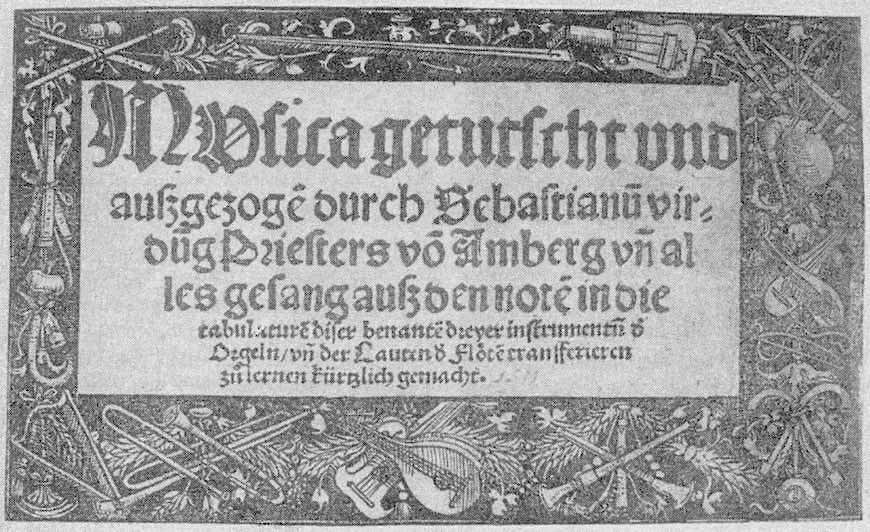
1521—London, England: At the declaration of Henry VIII as Defender of the Faith, “then was the Bull eftsones declared, and trumpettes blew, the shalmes and saggebuttes plaied in honour of the kynges newe style” (Herbert, Trombone 96).
1521—Bergamo, Italy: Lorenzo Lotto’s painting, Madonna and Saints, in Bergamo’s Santo Spirito, includes a depiction of an angel playing what is probably a trombone. The angel-trombonist is in the top-right of the painting (see detail and full image below; public domain) (Berenson, 51, pl. 119). Click on full image for larger version.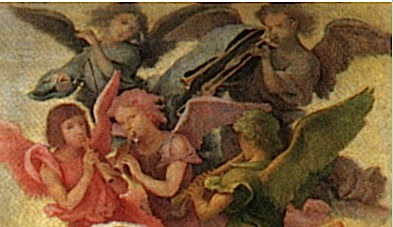

1521—Siena, Italy: Geronimo di Giovanni, the trombonist for the town wind band, passes on the post to his son Ansano Maria, a former trumpeter in Palace service (D’Accone, Civic Muse 566).
1521—Emperor Ferdinand I’s trombone consort performs in the palace of Margaret of Austria, Regent of the Low Countries (Whitwell, Renaissance 108).
1522—Schwerin, Germany: Court painter and architect Erhard Altdorfer paints the triptych, Story of Lazarus and Scenes from the Book of Job. Pictured in the far left panel is a small wind band with one or two trombones and cornett (see detail and full image below; public domain) (Łukaszewicz 112; National Museum, Wroclaw). Special thanks to Matthew Manchester.

1522—London, England: According to Edward Halle’s King Henry VIII, when Henry VIII entertains Emperor Charles V, “…they passed to the Conduite in Cornehill where the street was enclosed from side to side with ii gates to open and shitte, and over the gates wer arches with towers embattailed set with vanes and scutchions of the armes of the Emperor and the kyng, and over the arches were two towers, the one full of Trompettes and the other full of Shalmes and shagbuttes whiche played continually…” (Remnant, Illustrated 151).
1522—Greenwich, England: A Mass is celebrated at the Greenwich palace of Henry VIII to mark the reception of the papal bull conferring on the king the title of Fidei Defensor. After the Mass, the bull is read out and “trumpettes blew, the shalmes and saggebuttes plaied in honor of the kynges newe style” (Bowers 204).
c. 1522-23—Munich, Germany: Albrecht Altdorfer’s Mary and Child in Glory includes a depiction of an angel trombonist among several other angel musicians (see detail and full image below; public domain; Winzinger 45) (thanks to Stewart Carter and Herbert Myers for help identifying this painting).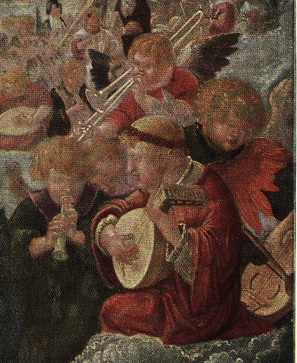
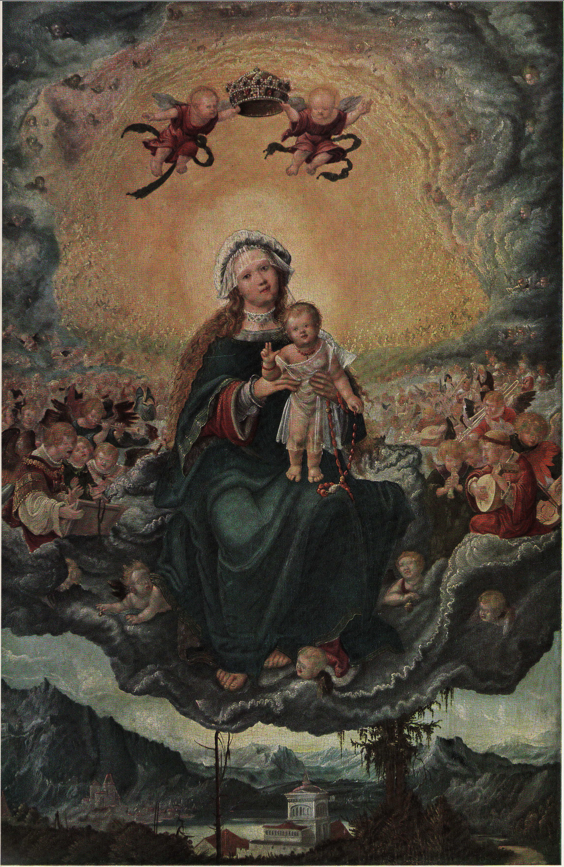
c. 1524—Rome, Italy: The famous artist-musician Benvenuto Cellini performs before Pope Clement VII with a small instrumental ensemble consisting of cornetto, shawm, and trombone. Cellini records the following in his autobiography: “It happened at this time that a certain Gianiacomo, a fifer [piffero] from Cesena and a most admirable musician who was in the Pope’s service, let me know through Lorenzo, a trombonist from Lucca [Lorenzo Trombone Lucchese] who today is in the service of our Duke, that if I wanted to I could help them by playing on my cornett that same day the soprano part of some beautiful motets they had chosen for the Pope’s celebration of Ferragosto. Although I was extremely anxious to complete that beautiful vase I had begun, since music is something marvelous in and of itself and since I was satisfying my old father’s wishes, I was happy to keep them company, and eight days before Ferragosto we spent two hours a day together practicing, so that on the first day of August we went to the Belvedere [the Pope’s gardens and courtyard], and while Pope Clement dined, we played these motets with such precision that the Pope had to admit he had never heard music played more delicately or harmoniously” (Cellini-Bondanella 35; Cellini 52). The word trombone in this passage is sometimes translated as trumpet (see Symonds, Hope, Bull); however, not only does the original Italian clearly indicate trombone (Lorenzo Trombone Lucchese), but the musician named, Lorenzo da Lucca, is a well-documented trombonist under Duke Cosimo I de’ Medici, the duke Cellini mentions (Kirkendale, Court Musicians in Florence). The Pope’s description in his praise of the performance is variously translated as exquisitely (Cellini-Bull), delicately (Cellini-Bondanella), sweetly (Cellini-Symonds), and charmingly (Cellini-Cust).
c. 1525—Basel, Switzerland: A woodcut by Hans Holbein the Younger depicts David’s Song of Thanksgiving, 1 Chronicles 16, with Asaph and his musical ensemble ministering before the Ark of the Covenant (Asaph was head of music for King David). The print belongs to a series of 91 woodcuts depicting Old Testament scenes. The brass player in the back-right, closest to the ark of the covenant, appears to be playing a trombone. The instrument’s slide extends past the bell and back bow of tubing extends past the shoulder. Also, the player’s grip is not fixing the instrument against the mouth in the manner of a slide trumpet, like the other players in the foreground (see detail and full image below; public domain).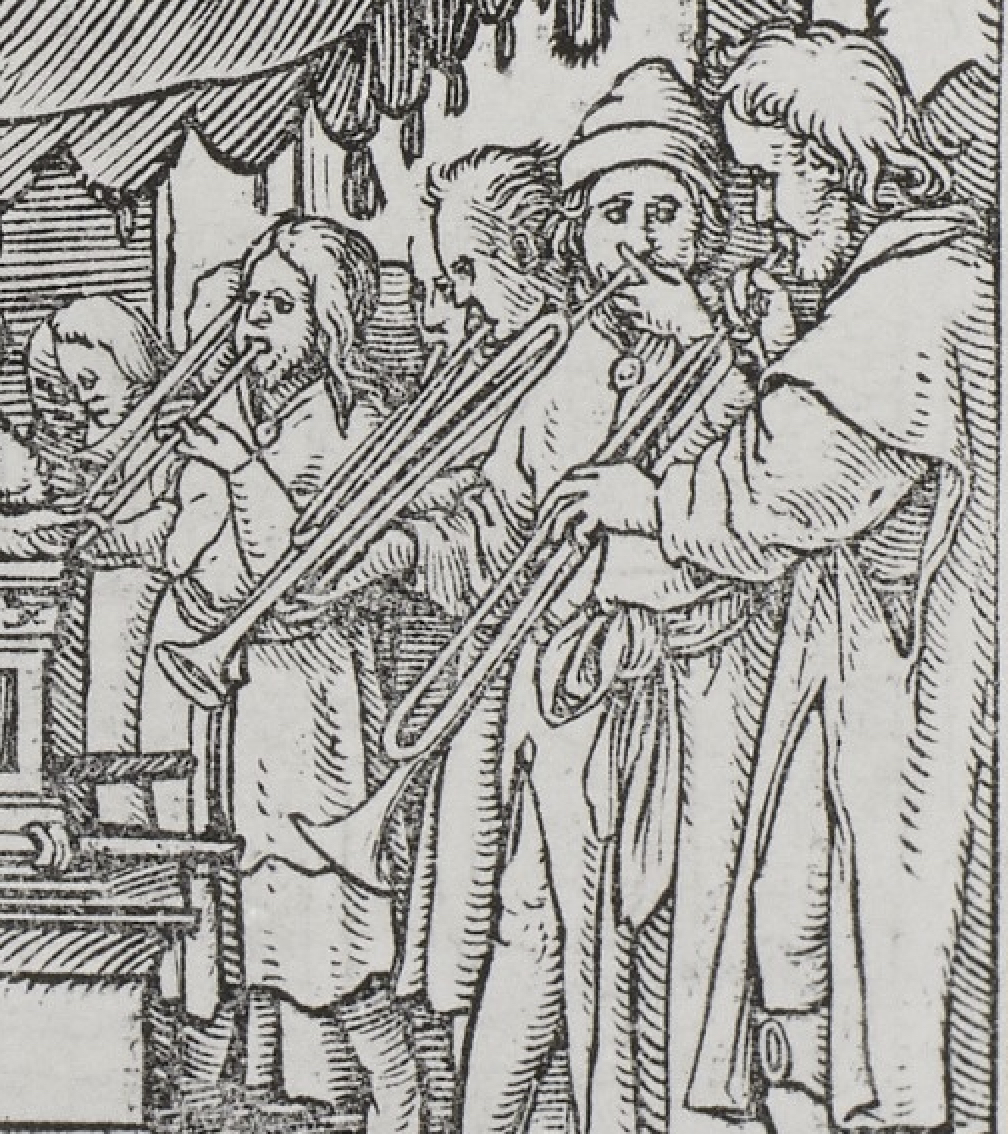
c. 1525—Setúbal, Portugal: An anonymous artist (possibly Jorge Afonso) paints Assunção da Virgem (Assumption of the Virgin) in the Church of Convento de Jesus. Among the angel-musicians depicted are 4 singers and 4 instrumentalists (3 shawms and a trombone) (see detail and full image below; public domain) (Markl 134; Gaio 251; Setúbal, Museu Municipal).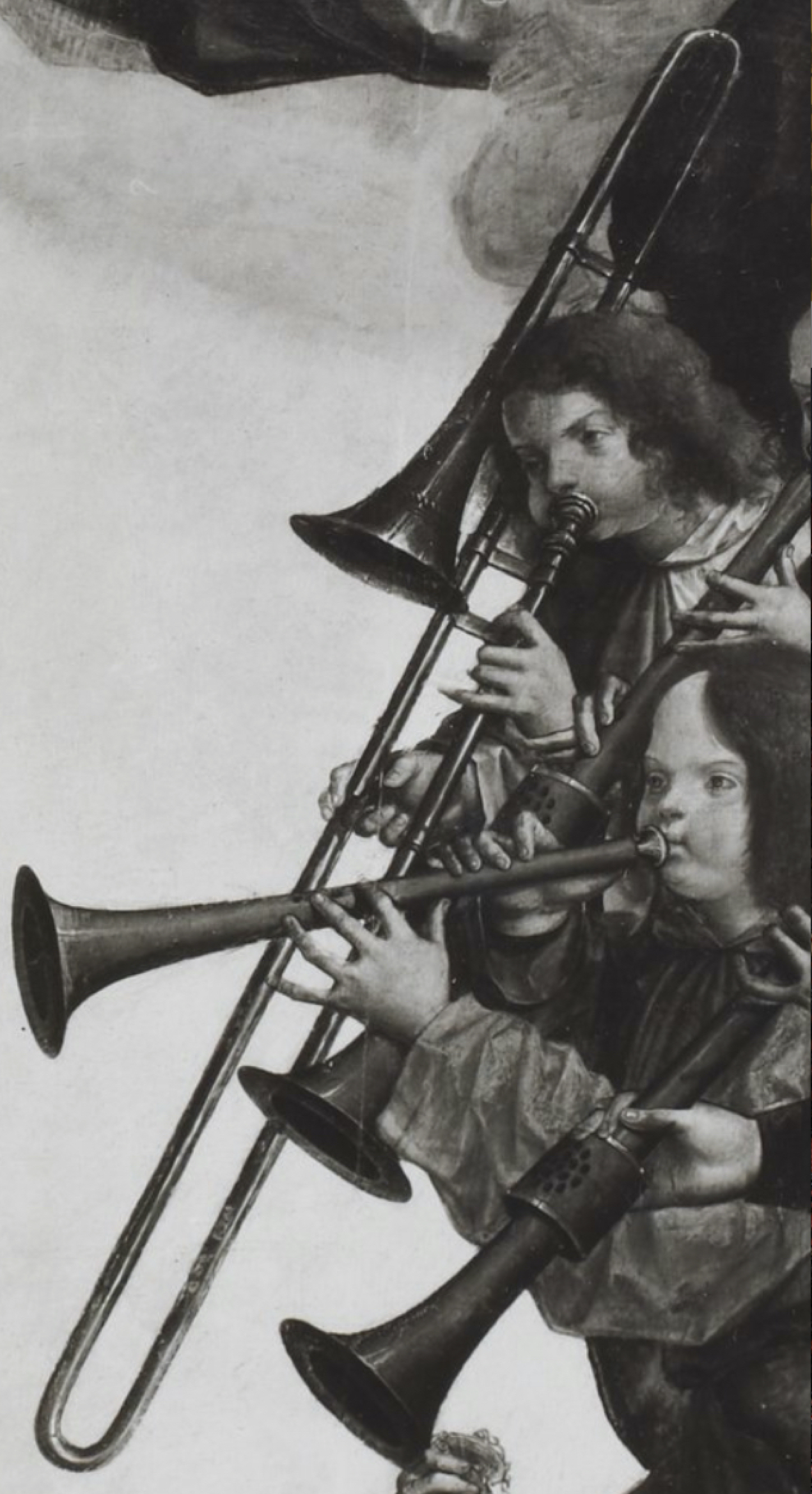
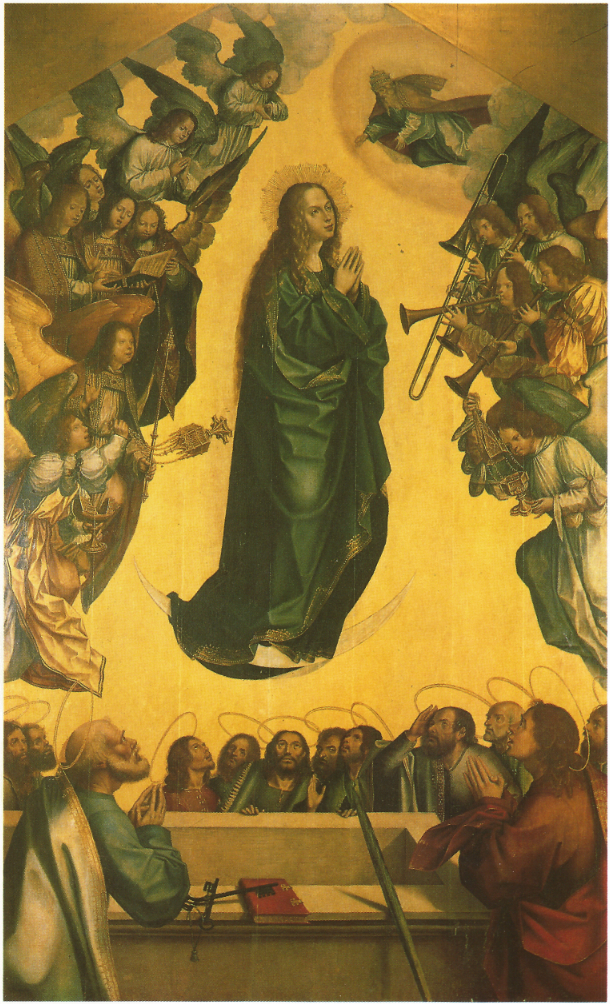
1525—London, England: Italian trombonists are added to the musicians of the court of Henry VIII (Kisby, Royal Minstrels).
1525—Rome, Italy: The pifferi (civic wind band) consists of 3 woodwind instruments (probably shawms) and a trombone (Kurtzman, Trombe).
1526— London, England: Sackbuts are added to the shawm band comprising the London Waits. Viols are added in 1561, recorders and cornetts in 1568 (Monson Elizabethan 327). The purchase record for the sackbut is made by a seemingly confused secretary, who has considerable difficulty writing down the name (possibly because it is a new and unfamiliar instrument): first, Hakbush or hakbussh, crossed out, then Sakbutte above the line, and finally an Instrument called a Sakbutte (Woodfill 35).
1526—In the famous series of woodcuts titled The Triumph of Maximilian, executed primarily by artist Hans Burgkmair, one image (Plates 25 and 26) depicts a wagon transporting the Emperor’s Hofkapelle (court band), with cornett, trombone, and a number of singers, all the performers reading from a large music desk. Maximilian’s instructions for the engraving are “Again depict a similar small low car with plough wheels, drawn by two bison; a boy shall drive them and bear the Kapellmeister’s verse. On the car should be the choir, and also cornett players and trombonists arranged in good order. Herr Jorg Slatkany (Bishop of Vienna) shall be Kapellmeister and his verse shall be as follows: How by the Emperor’s instructions he arranged the choral singing most delightfully….Stewdl shall be leader of the trombonists, Augustin of the cornett players, and their verse, borne by a boy on the car, shall read thus: How by the Emperor’s instructions they attuned the trombones and cornets in most joyous manner. (The cornets and trombones we placed So that the choral song they graced, For His Imperial Majesty Has often in such harmony Taken great pleasure, and rightly so, As we have had good cause to know).” See below image (Burgkmair, Triumph 5-6, plate 26; public domain). Click on picture for larger version.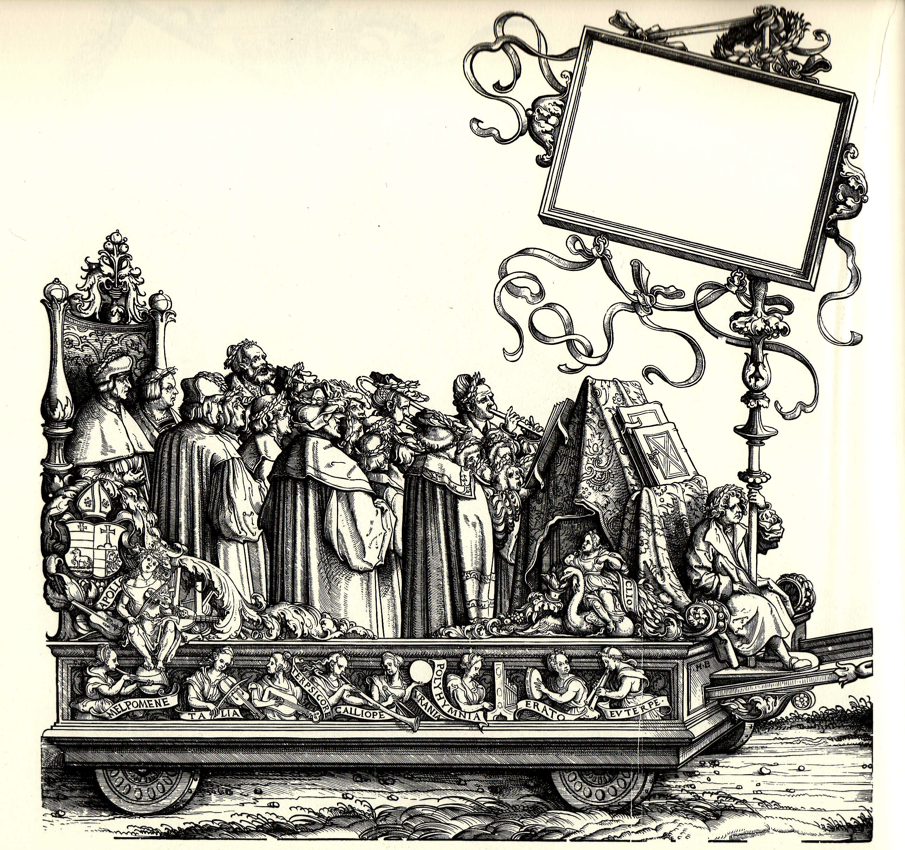
1526—In a series of woodcuts titled The Triumph of Maximilian (also cited above), another image (Plates 19 and 20) depicts Hans Neuschel, a famous trombonist and leader of the court wind band, playing in a wagon along with 2 shawms and 2 crumhorns. The caption for the engraving reads, “The trombone and the shawm adorn The joyous sound of curving horn, Each to the others well adjusted. Since His Majesty entrusted This musical command to me, I have performed quite frequently.” The instructions Maximilian had given for this engraving were: “Then depict a low car on small plough wheels, drawn by two buffalo; a boy shall drive them and bear the leader’s verse. On the car shall be five shawm players, trombonists and krummhorn players. And Neyschl (master trombonist) shall direct them, and his verse, borne by the boy, shall read: How to the Emperor’s joy and by his command he combined such diverse instruments in the merriest way.” See below image (Burgkmair, Triumph 4, plate 20; public domain image). Click on picture for larger version.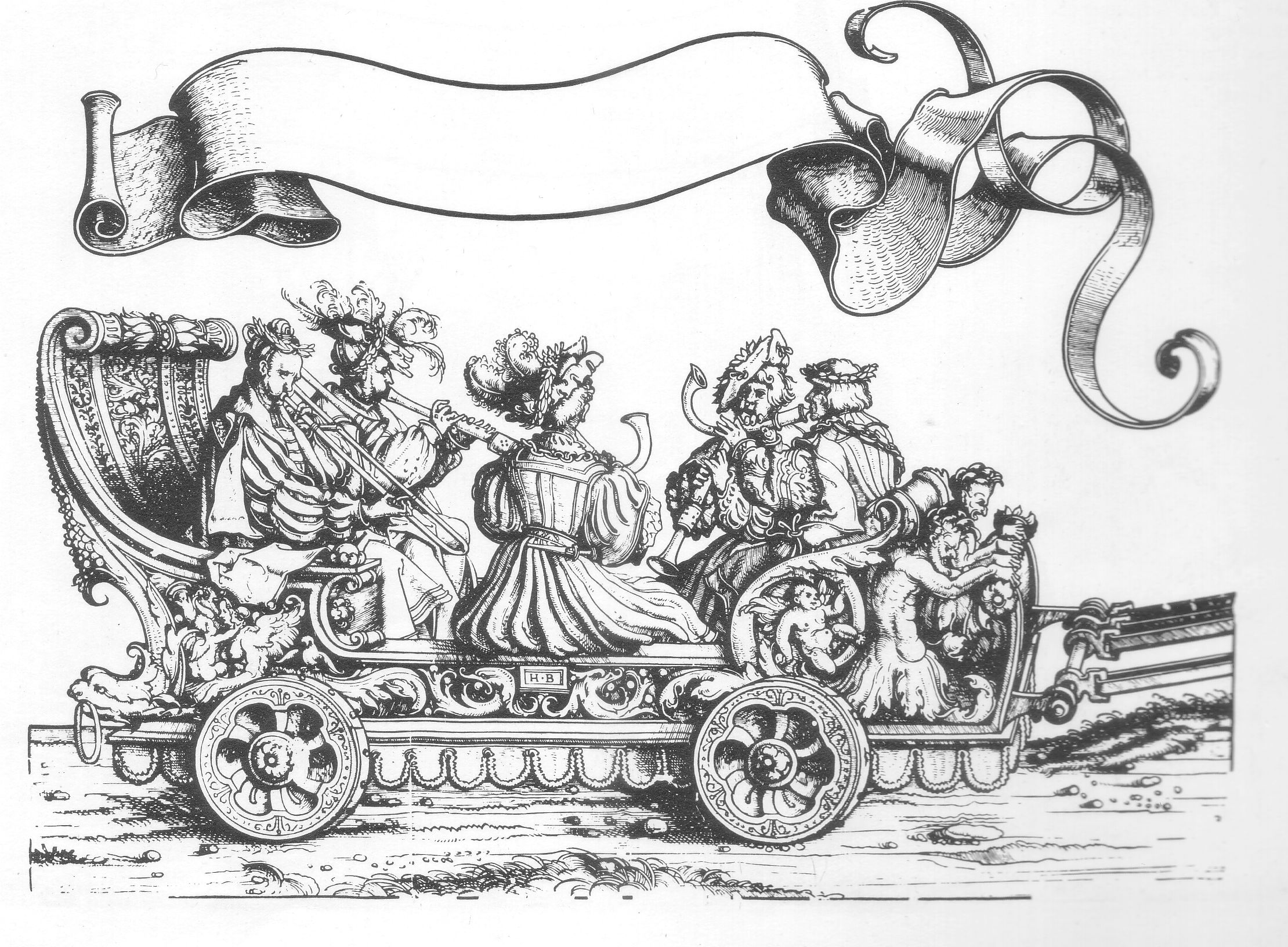
1526—In a series of woodcuts titled The Triumph of Maximilian (also cited in above 2 entries), 2 additional images (Plates 77 and 78) include trombones. The instructions for the engravings read, “After them shall come on horseback Burgundian fifers in the Burgundian colors with bombardons, shawms, and rauschpfeiffen. And they shall all be wearing laurel wreaths.” See below 2 images (Burgkmair, Triumph 9, plates 77-78; public domain images). Click on picture for larger version.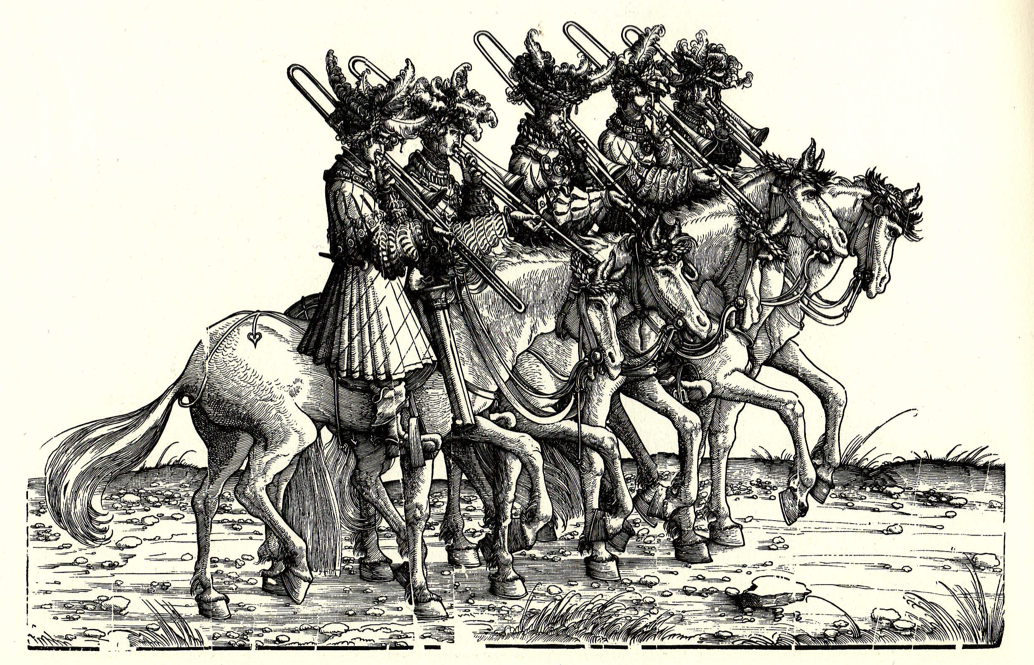
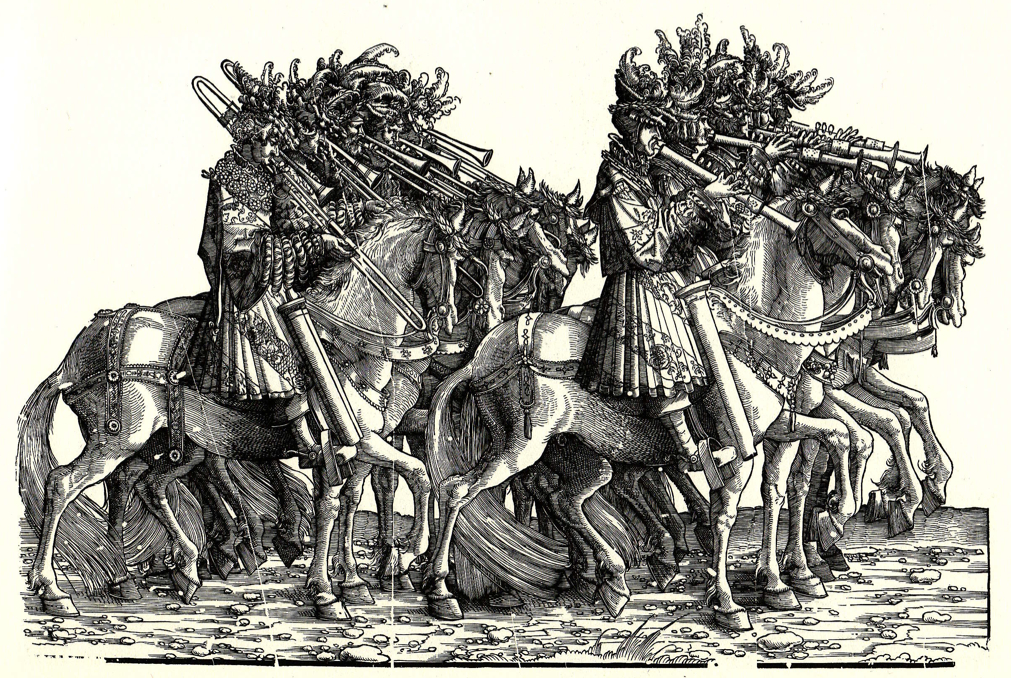
1526—Margaret of Austria, as regent, visits several towns in her realm. She hears shawms and trombones in Aalst, Antwerp, Bergen op Zoom, Bruges, Ghent, and Mechelen (Polk, Susato 95).
1526—Brussels, Belgium: Margaret of Austria visits Brussels, where she hears singers of the “great church of Brussels…and the players of shawms and sackbuts et pintetz d’allemaigne” who “played with the said singers in improvisation and also written music” (Polk, Susato 95).
1526—London, England: King Henry VIII maintains 10 full-time trombone players on his staff (Stevens, Music & Poetry302).
1526—Seville, Spain: Authorities decide to set up a permanent full-time instrumental ensemble, saying, “It would be very honorable in this holy church and in the praise of the divine worship to have on salary, for their own use, some loud minstrels [menestriles altos], trombones [sacabuches] and shawms [chirimias], to use in various of the most important feasts and the processions that the church makes…they determine and order that five loud minstrels be received into this church: three shawms (treble, tenor and contra) and two trombones [sacabuches], persons skilled in their art, to serve in this church…” This group constitutes the earliest known cathedral ensemble in Spain (Kreitner, Minstrels in Spanish Churches; original Spanish in Stevenson, La Musica 27).
1527—A basse contre and trombone are bought in Antwerp, Belgium for the Lille town band (Polk, Susato 92).
1527—George Cavendish, an English traveler in France, visits Amiens Cathedral, where he hears cornetts and sackbuts perform a Mass with the singers of the French Chapel Royal: “Mass was song solompnly by the kynges Chappell hauyng among theme Cornettes and Sakbuttes” (Cavendish 54, Bowers 204).
 1529—Wittenberg, Germany: Martin Agricola publishes Musica instrumentalis deudsch, a treatise on musical instruments. Most of the information, including that about trombone, is derived from Sebastian Virdung’s Musica getutscht (Basel, 1511). He includes a woodcut of a trombone, labeled Busaun, that is almost identical to Virdung’s print(see facing image; public domain). Agricola also admits that he has little understanding of the instrument (“I shall not say much about them at this time, for I do not yet possess the proper fundamentals”) (Agricola 16-17, 145).
1529—Wittenberg, Germany: Martin Agricola publishes Musica instrumentalis deudsch, a treatise on musical instruments. Most of the information, including that about trombone, is derived from Sebastian Virdung’s Musica getutscht (Basel, 1511). He includes a woodcut of a trombone, labeled Busaun, that is almost identical to Virdung’s print(see facing image; public domain). Agricola also admits that he has little understanding of the instrument (“I shall not say much about them at this time, for I do not yet possess the proper fundamentals”) (Agricola 16-17, 145).
1529—Cambria, France: According to Edmond Vander Straeten, King Francis’s 9-member wind band, which includes trombones (sacbottes), shawms, and cornetts, performs at the Conference of Cambrai (Shaw; Whitwell, Renaissance 67).
1529—Ferrara, Italy: Music is played at the court on 5 trombones and a cornett during the 5th course of a wedding banquet. Music during the 7th course includes a trombone (uno trombone), 2 dolzaine, one storta, and one cornetto grosso. During the 8th course, music is played on a trombone (uno trombone), 5 viols, one strumento di penna, a flauto grosso, a lira, and a flauto d’Alemana (Reese 546; Boydell, Crumhorn 37, 389). About the Cena di Pesce (Banquet of Fish), the records states, “And as this course was on the table, a dolzaina, a trombone [uno trombone], and a flute played…a dolzaina, a great bass viol, two cornamuse and a cittern” (Boydell, Cornamuse 389, 416).
1529—Oudenaarde, Belgium: Trombonist Gheerart van Weerbeke is appointed to the town wind band (Polk, Susato 88).
1529—France: At the court there are 8 players of shawm and sackbut (saqueboutes) (Whitwell 66).
1530s—London, England: Wages to trombone players comprise the greatest portion of expenditures for instrumentalists (Herbert, Sackbut 78).
c. 1530—France: Court instruments begin to be divided into 2 groups: the écurie (stable) and the chambre (chamber). Trombones are part of the écurie, along with violins, shawms, and flutes (Sternfeld 192). Musicians of this group enjoy special privileges: the right of commensaux (meal companions of the king), exemption from many taxes and obligations to church-wardens, exemption from quartering soldiers, gifts of food and clothing, and bonuses for special ceremonies (Whitwell, Baroque 26).
c. 1530—Augsburg, Germany: Hans Burgkmair (or his circle) paints a pair of images, Concert of Sacred Music and Concert of Secular Music, on wood panels. Concert of Sacred Music includes trombone and cornetto players performing with a group of singers in front of a large music stand (see below image; public domain).
c. 1530—France: A Mass composed by Perino is performed on organ, trombones, and cornetts (Whitwell, Renaissance 69).
c. 1530—Musical Angels, a detail from Assumption of the Virgin by Frei Carlos, a Flemish monk who worked in Portugal, depicts angels playing trombone, trumpet, shawm, and pipe (or recorder) (see detail and full image below; click on detail to expand; public domain) (Lisbon, National Museum of Ancient Art).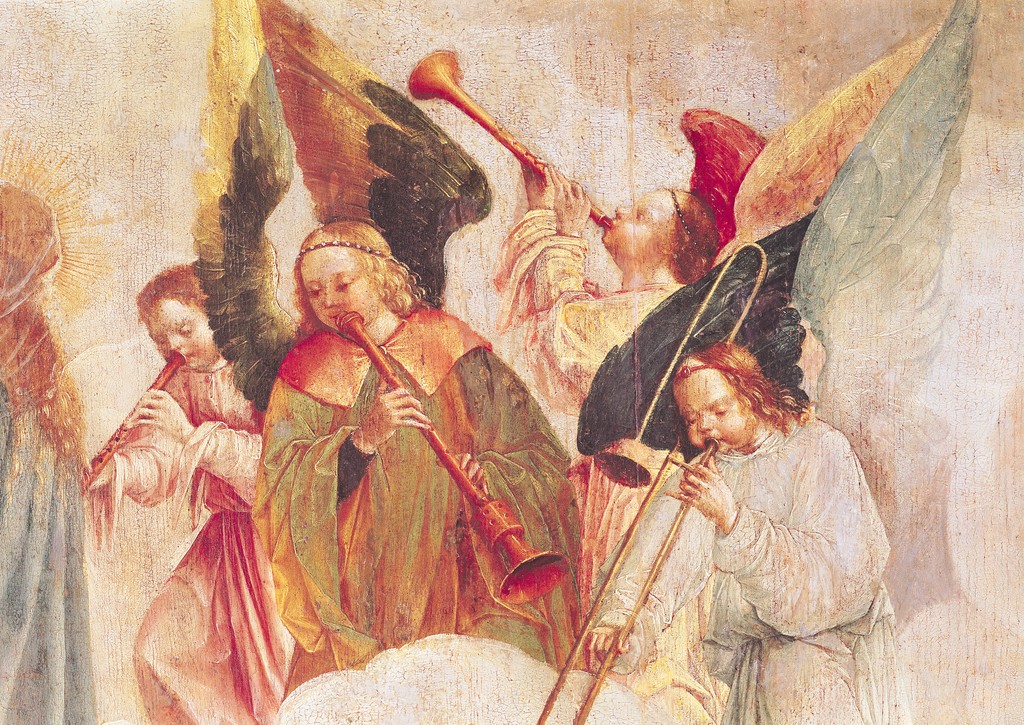
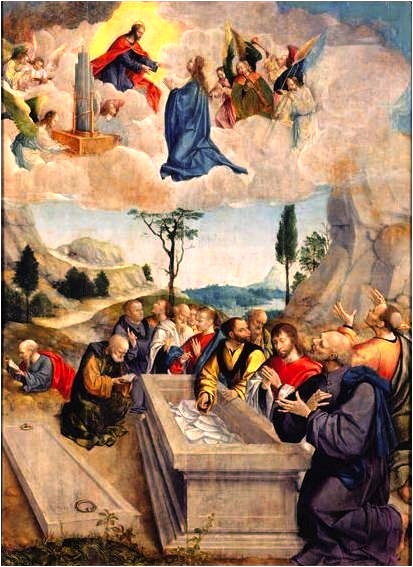
1530—Germany: Martin Luther, in a letter to Peter Weller, uses trombone in a metaphorical sense (see also 1520): “Our heroes at the Diet are running about helter-skelter….They enter the arena of conflict easily, then give us a truce during the day, and with the sound of the trombone proclaim victory in our ears…” (Luther-Currie 222).
1530—Antwerp, Belgium: Documentation on the stadsspeellieden indicates a 5-person band who played a variety of wind instruments, including shawms, trombones, trumpets, crumhorns, recorders, and flutes (Forney, Antwerp 362).
1530—Lyons, France: Trombones are among those participating in a procession celebrating the return of the sons of Francis I, following the Peace of Cambrai (Dobbins, Music 105).
1530-57—A series of works published by Pierre Attaignant, beginning with the Six Galliardes et six Pavanes, is probably intended for a wind band of trombones and shawms (Whitwell, Renaissance 70).
c. 1531—England: Trombonist Antonio Bassano arrives from Italy to serve in the English court. He is the first of a long family line—17 members in all—to serve as musicians in the English court. Of the 17, 7 were trombonists (Herbert, Trombone 76).
1531—Antwerp, Belgium: Tielman Susato becomes a member of the town wind band, where he plays trombone, field trumpet, crumhorn, flute, and recorder (Herbert 119; Polk, Archival Documents; Forney, Renaissance 117).
1531—Antwerp, Belgium: Tielman Susato plays trombone in Antwerp’s Church of Our Lady on 19 occasions (Forney, Renaissance 117).
1531—England: “Anthony the Sagbut” is paid 53s. 4d. for “his costes going to Southampton with the new sagbuttes” (Stevens, Music & Poetry 302).
1531—Toledo, Spain: The cathedral gives 20-year contracts to a trio of instrumentalists—tenor shawm, alto shawm, and trombone (sacabuche). Each of the 3 players is to choose an assistant as well (Kreitner, Minstrels in Spanish Churches).
1531-40—Brussels, Belgium: Records for the court of Mary of Hungary list 6 musicians under the heading Sackbut, shawm, trumpet/cornetto (Thompson, Mary of Hungary).
1532—Canterbury, England: 2 cornett players and 2 sackbut players are regularly employed at Canterbury Cathedral (Woodfill 149).
1532—Siena, Italy: Trombonist Benedetto di Domenico replaces Ansano Maria in the town wind band (D’Accone, Civic Muse 566).
1532—Antwerp, Belgium: A city record notes that Tielman Susato is in possession of a large number of instruments belonging to the city, including 2 trombones, flutes, shawms, several chests of crumhorns, and a field trumpet (Forney, New Insights 3; Forney, Renaissance 118).
1532—Antwerp, Belgium: Inventory records show that the city owns 3 trombones (Polk, Susato 74).
1533—France: The new queen, Eleanor of Austria, enters Lyons in a large procession that includes trombones (Dobbins, Music 107).
1533—England: At Anne Boleyn’s coronation celebration, an elaborate water procession on the river Thames includes a the Mayor’s barge, which carries “Shalmes, Shagbushes & divers other instruments, whiche continually made goodly armony” (Stevens, Music & Poetry 240; Whitwell, Renaissance 24).
1533—Seville, Spain: Church records for the Seville Cathedral link the trombone with the contralto part: “On this day the said Lords, called the previous day, submitted [the following] to the Lords Archdeacon De Niebla, Prior and Canon Zambrano, and Prebendary Diego Fernandez, so that they, along with the maestro de capilla, recognize the ability of Francisco de Flandes, chirimia tiple, and so recognizing it, award him the salary they deem appropriate, and also see if Andres de Deça can serve for the contralto, since he is a trombone player [sacabuche], and if it seems to them that he can serve well, that they receive him with the salary that seems appropriate” (Stevenson, La Musica 28-29).
1533—Barcelona, Spain: Emperor Charles V visits Barcelona and is serenaded by “players of loud and soft instruments, of shawms and sackbuts [sacabuches], dulcians and trumpets and drums and other players [minystriles]” (Boydell, Crumhorn 390).
1534—Germany: Martin Luther’s famous translation of the Bible into German is published. Luther translates the Greek words shophar and salpigx to Posaune (Ger., trombone). Many passages previously translated as trumpet are thus translated as trombone. For example, I Corinthians 15:52 reads, “…we shall all be changed, in a moment, in the twinkling of an eye, at the last trombone; for the trombone shall sound and the dead shall be raised incorruptible” (Guion, Trombone 151).
1534—England: Sir Thomas Elyot’s pseudo-medical tract recommends that “the entrayles which be undernethe the myddreffe, be exercised by blowynge, eyther by constraynte, or playenge on the Shaulmes, or Sackbottes, or other lyke instruments whyche doo require moche wynde” (Herbert, Trombone 77).
c. 1535—England: Henry VIII pays regular wages to 12 trombonists, all foreigners, at his court (Herbert, Susato 117, 123).
1535—Antwerp, Belgium: Trombone players are paid for playing in the mass and the Lof at Antwerp’s Church of Our Lady (Forney, Renaissance 117).
1535—Florence, Italy: According to Giorgio Vasari, Florentine artist and historian, at the ceremony for the installation of the garrison of a fortress in Florence, “The very earth seemed pleased with the Gloria that I heard intoned by the Most Reverend Bishop, who was answered by a multitude of trombones, cornetti, and voices, so that one inclined one’s head owing to the sweetness as when one grows sleepy around the fire. At the conclusion of the oration, the Veni, Sancte Spiritus was begun by harmonies of trombones…” (Cummings 148-49).
1535—Nuremberg, Germany: Albrecht Glockenton the Younger includes a trombonist in his picture Job, His Wife, and Two Musicians, a miniature from a prayer book of Duke William IV of Bararia (see below detail; public domain) (Denis, Saint Job pl. VI).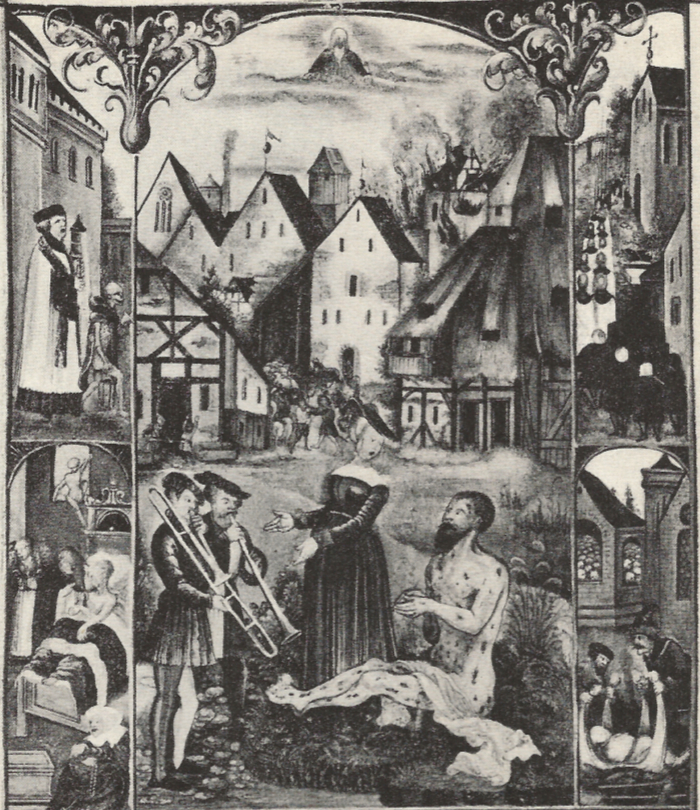
1535-37—Brescia, Italy: A salary and clothing petition is made from the city’s piffari, who “serve with shawms, trombones [tromboni], cornetts, and other instruments” (Hill, Emergence 357).
1536—Siena, Italy: According to a court festival book, upon the entry of Charles V, king of Spain, into Siena, music is performed by “organi, tromboni, & cornetti” (La felice entrata 005).
1536—Siena, Italy: A document implies that vacations for musicians are customary: Siena pifferi (including trombone) are granted 8 days’ vacation “so that they can enjoy the pleasure of the countryside in the usual way” (D’Accone, Civic Muse 548).
1536—England: At a water procession, “the Kinge passed throwe London Bridge, with his trumpets blowinge before him, and shalmes and sagbuttes, and dromslawed [drummers] playing also in barges going before him” (Herbert, Trombone 96).
1536—Brussels, Belgium: At the court of Mary of Hungary, Jehan Gossins, master of the children of the chapel, provides food and clothing to one Melcior Preighle, a young musician described as a player of sackbut and trumpet (Thompson, Mary of Hungary).
1537—Bologna, Italy: The shawms of the town wind band are replaced by 4 cornettos, while the lower parts are played by 4 trombones (Kurtzman, Trombe). The ensemble, called Concerto Palatino, labels the subset of the cornetts and trombones musici. The musici’s duties include 2 daily concerts from the balcony of the Palazzo Pubblico. On Sundays, feast days, and special occasions, they join the lute and harp in performing table music for the signori and their guests. The musici and trumpets also travel with civic leaders whenever they leave the palace on official business (Guion, Missing Link).
1537—England: Princess Mary’s privy purse accounts record that she is given a performance by sackbuts at a private residence (Woodfill 186; Whitwell, Renaissance 33).
1537—Königsberg, Germany: Records at the court of Duke Albert of Prussia indicate repairs done on trombones and other wind instruments: “Veit the trumpeter has received 4 Marks for trombones [pusaunen], Rauschpfeifen, and shawms sent to Danzig for repairs” (Boydell, Crumhorn 359).
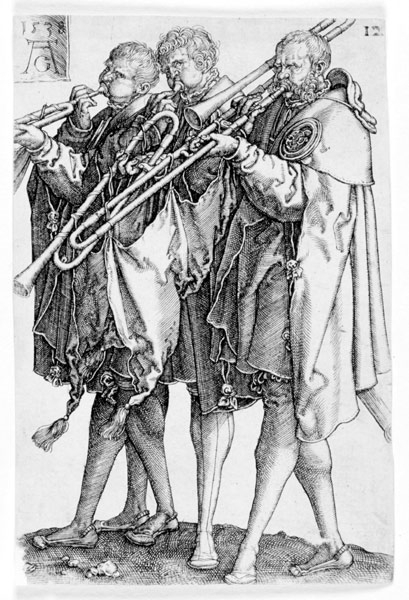 1538—Germany: Heinrich Aldegrever portrays a trio of trombone and 2 trumpets in a woodcut titled The Brass Players (Die Posaunisten) from the series The Great Wedding Dances (see facing image; public domain) (Duffin, Trompette des Menestrels).
1538—Germany: Heinrich Aldegrever portrays a trio of trombone and 2 trumpets in a woodcut titled The Brass Players (Die Posaunisten) from the series The Great Wedding Dances (see facing image; public domain) (Duffin, Trompette des Menestrels).
1538—Ghent, Belgium: Records show that the city purchases a silver trombone (Polk, Susato 79).
1538—Brussels, Belgium: The court of Mary of Hungary purchases 4 trombones (Thompson, Mary of Hungary).
1538—Ferrara, Italy: Chronicler at Ferrarese court reports that an intimate group “went to dine as usual with music by trombones, cornetts and other instruments.”
1538—Siena, Italy: The members of the civic wind band, including the trombonist, are upbraided for being derelict in their duties, particularly when they are supposed to be playing during lunch and dinner. The trombonist is singled out for his many absences. After noting that the group has been censured previously, the priors (city rulers) resolve that any musician who fails to appear at required times in the future will be fired immediately. Also, substitutes will no longer be allowed, and absences will only be excused in the case of illness, and then only in advance (D’Accone, Civic Muse 549).
1538—Bologna, Italy: The standard wind band is made up of 4 cornetts and 4 trombones (Dickey, The Cornett 56).
1539—Florence, Italy: “On the entrance of the most illustrious Duchess” at the wedding procession of Duke Cosimo I and Leonora of Toledo, Corteccia’s motet, a 8, Ingredere felicissimis auspiciis urbem tuam Helionora, is “sung over the archway of the great door of the Porta al Prato with 24 voices on one side and on the other 4 trombones and 4 cornetti” (Brown Sixteenth-Century Instrumentation, 88; Reese 366). The wedding festivities also include a madrigal performed by a female vocalist and 4 trombones; a contemporary account records, “This last act was closed by Night, dressed in a black silk veil with a blue-starred headdress, the moon above her forehead….She sang sweetly Ventien ’ almo riposo: ecco ch ’ io torno to the accompaniment of 4 trombones (Bowles, Musical Ensembles 25). In addition, at the wedding banquet in a courtyard of the Palazzo Medici, the 9 muses sing Francesco Corteccia’s motet, a 9, Sacro e santo Hymeneo. Although the muses are not described as playing instruments, they each hold one; a contemporary accound mentions, “The first [Thalia] was in a very blonde cloth, girded with a green olive branch…a trombone [trombone] in her right hand” (Brown, Sixteenth-Century Instrumentation 88; Bowles, Musical Ensembles 24; Boydell, Crumhorn 41).
1539—Germany: Martin Luther praises a church procession that includes trombones, harps, timpani, cymbals, and bells (Whitwell, Renaissance 238).
1539—England: Account books for Henry VIII show payments to both the old sagbutts and the new sagbutts (Stevens, Music & Poetry 301).
1539—England: The household records of Henry Manners, Earl of Rutland, show a payment to shawmes and shagboshes who performed for his entertainment (Woodfill 267).
1539—Florence, Italy: 4 trombones alone are used to accompany Night in the 5th intermedio to Il Comodo (Weaver, Sixteenth-Century Instrumentation).
c. 1540—Nuremberg, Germany: Instrument maker Jorg Neuschel receives an inquiry about making a trombone with a double slide (Gregory 94).
c. 1540—Gent, Belgium: The city wind band expands from 5 to 6 and includes 2 trombones (Polk, Susato 78).
1540—Southwest Germany: An anonymous oil painting entitled Der Castalische Brunn, originally the property of Basel physician Felix Platter (1536-1674), depicts a trombonist playing with an outdoor ensemble (see below detail and full image below; public domain) (Historisches Museum Basel, Inv. No. 1906.2901).
1540—Brussels, Belguim: The city wind band expands from 4 to 5 players, including 1 or 2 trombonists (Polk, Susato 82).
1540—England: The King’s Musick includes 7 sackbuts: Loyes de Jeronom, Anthony Mary Galiardello, Nicholas Andrewe, Anthony Symonde, Nicholas Forcivall, Pelegrine, Mark Anthony Petala (Woodfill 297).
1540—Rothenberg, Germany: 3 musicians from Nuremberg apply to become members of the town wind band, claiming they can play all of the following instruments: trombones (pusaunen), cornetts, flutes, schreyerpfeifen, pipe and tabour, crumhorns, shawms, recorders, string instruments, organ, and lutes. Their application is denied (Boydell, Crumhorn 44).
1540—Rothenberg, Germany: A musician applies successfully to become a member of the town wind band, describing himself as “being adept in and able to play string instruments, flutes and other woodwind instruments nowadays common, also shawms, trombones [pusaunen], crumhorns” (Boydell, Crumhorn 44).
1540-50—Italy: Concertino di gentiluomini, an oil painting by Girolamo Romanino (c. 1485-c. 1566), features 4 trombones and a cornetto (see below image; public domain) (Galleria Michelangelo, Bergamo).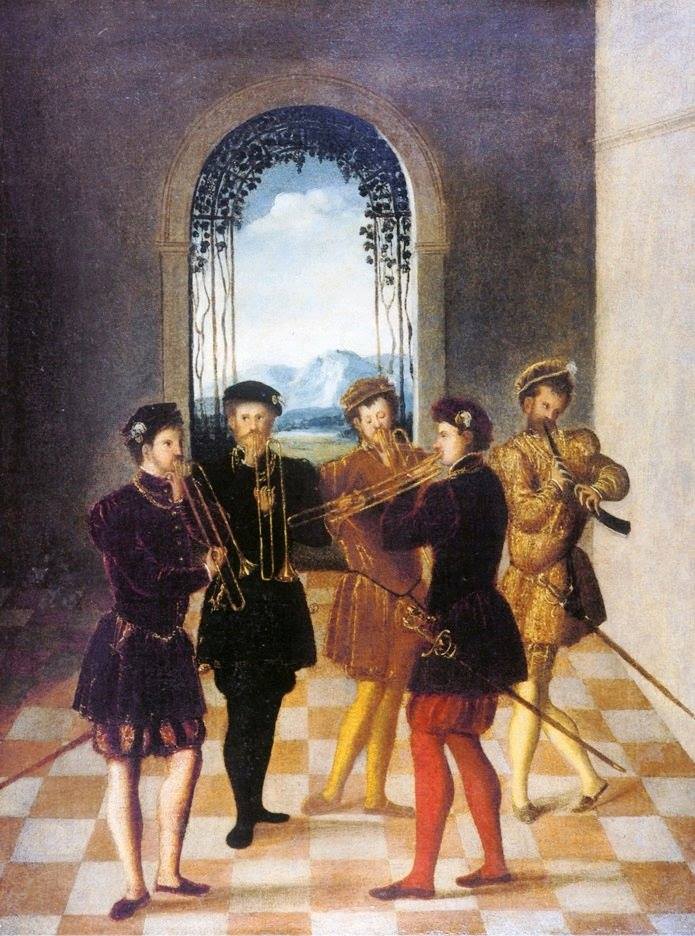
1541—Paul Kugelmann, court trumpeter in Königsberg, writes “Laudate Dominum,” a vocal canon accompanied by 4 trombones and 4 cornetts (Whitwell, Catalog Before 1500 78).
1541—Königsberg, Prussia (now Kaliningrad, Russia) and Nuremberg, Germany: In an interesting exchange with prominent brass instrument maker George Neuschel of Nuremberg, Duke Albrecht orders, among other supplies, “4 tenor trombone mouthpieces” and “1 crook of a fourth for the quart-trombone.” Neuschel, in turn, attempts to sell Duke Albrecht numerous additional instruments and parts, including “1 silver trombone with a crook of a fourth, for use with voices and instruments” and “5 trombones, which are tuned together and from which a tenor trombone may be made into a bass or an alto” (Downey, From the Rim 8). This exchange highlights several items of historical importance, including the use of crooks on trombones, specific mention of the trombone’s “use with voices and instruments,” the flexibility in which “a tenor trombone may be made into a bass or an alto,” the making of silver trombones, and the evident employment of trombones by Duke Albrecht.
1541—Copenhagen, Denmark: A set of partbooks at the Danish court contains music specified for 3 crumhorns and trombone, 4 crumhorns, and 4 cornetts and 4 trombones (Dart, Interpretation 145; Boydell, Crumhorn 216).
1541—Ghent, Belgium: Records show that the city purchases 2 silver sackeboeten (trombones) (Polk, Susato 79). The town wind band consists of 2 trombones, 2 discant shawms, and 2 tenor shawms (Whitwell, Renaissance 176).
1541—Ile-Barbe, France: A priest named Philibert Girinet describes Ascension Day festivities that include the blare of instruments, including trombones, which accompany a fireworks display (Dobbins, Commercial 203).
1542—Antwerp, Belgium: Tielman Susato is paid for providing the city with 2 additional trombones, “one a tenor, the other a bass, bought for the civic musicians to be used in processions and in the church with the singers during high feasts” (Polk, Susato 195). Inventory records from 1532 show that the city already owns 3 trombones (Polk, Susato 73).
1542—Ghent, Belgium: Cornelis Van Winckle, a “shawmist who plays the sackbut,” is hired for the town wind band (Whitwell, Renaissance 176).
1542-46—Siena, Italy: Ansano Maria di Geronimo, also a Palace musician, serves as cathedral trombonist (D’Accone, Civic Muse 729).
1543—Florence, Italy: Musicians appointed by Cosimo I to serve at the Florentine court include an esteemed group of trombonists: Mattio di Giovanni, Lorenzo da Lucca, Niccolaio, and Bartolomeo di Luigi. Bartolomeo and Lorenzo da Lucca were highly-respected musicians who were deemed worthy to judge an applicant for an organ post at the Florentine baptistry (Kirkendale, Court Musicians in Florence 61-63). Piero da Ricasoli, discussing instrumental virtuosi in Cosimo Bartoli’s Ragionamenti accademici, later lists 3 specific trombonists–2 of them, Bartolomeo di Luigi and Lorenzo da Lucca, coming from the above set of players. Ricasoli comments specifically that Lorenzo da Lucca “has in his playing a certain grace and lightness [grazia et una leggiadria] with a manner so pleasing as to make me dumbstruck” (Haar, Cosimo Bartoli). Lorenzo da Lucca had also played an active role in a political revolt in Lucca (Kirkendale, Court Musicians in Florence 61) and is presumably the same trombonist who had performed with Benvenuto Cellini for the pope c. 1524 (see above).
1543—Bruges, Belgium: The city purchases a new trombone for the civic wind band (Polk, Susato 77).
1543—Siena, Italy: An additional trombonist, probably Ansano Maria di Geronimo, is added to the town wind band (D’Accone, Civic Muse 566).
1543—England: Records of Princess Mary’s New Year’s gifts include The new Sagbutts (Whitwell, Renaissance 33).
1544—A musician from Braçov, Romania travels to Poland to buy “1 trombone (posaune), 1 great bass pommer, 1 alto shawm, 1 Korner, 1 cornett” (Boydell, Crumhorn 124).
1544—Florence, Italy: An open letter signed “Pasquino Patritio Romano” includes the following mention of trombone improvisation as an argument for improvisation in song: “Do you not play the trombone by ear? Do you not create upon four notes of a cantus firmus, via fantasy, an endless sea of notes?” [Non sonate voi con la pratica dell’orecchio il Trombone? Non fate voi in su quattro Note di Canto fermo, con la fantasia un Mar di Note senza fondo?] (Nosow, The Debate on Song).
c. 1545—Germany: Hans Sebald Beham’s print, Le banquet d’Hérode, includes what is probably a trombone—and possibly a pair of trombones (see detail and full image below; public domain) (French National Library).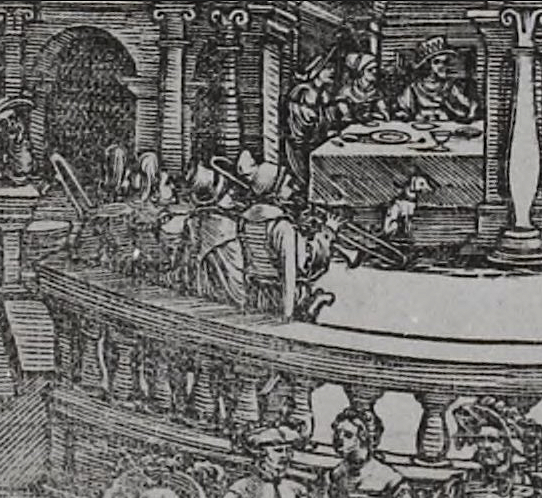
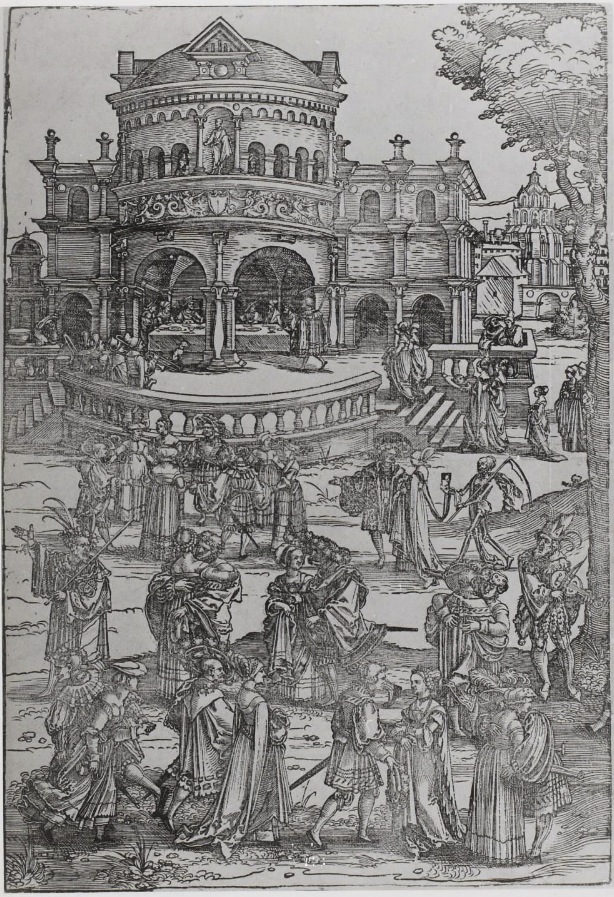
c. 1545—Italy: Giorgio Vasari, the famous Florentine artist and historian, paints a fresco of a quintet of wind musicians. The ensemble, comprising 4 cornetts and a trombone, plays from a window or balcony. The player’s grip of the trombone is somewhat unorthodox and the player is also holding the instrument left-handed. The bell is partially obscured by the player’s head (see below image, click picture for larger version; public domain) (source: wikimedia commons; Stewart Gardner Museum).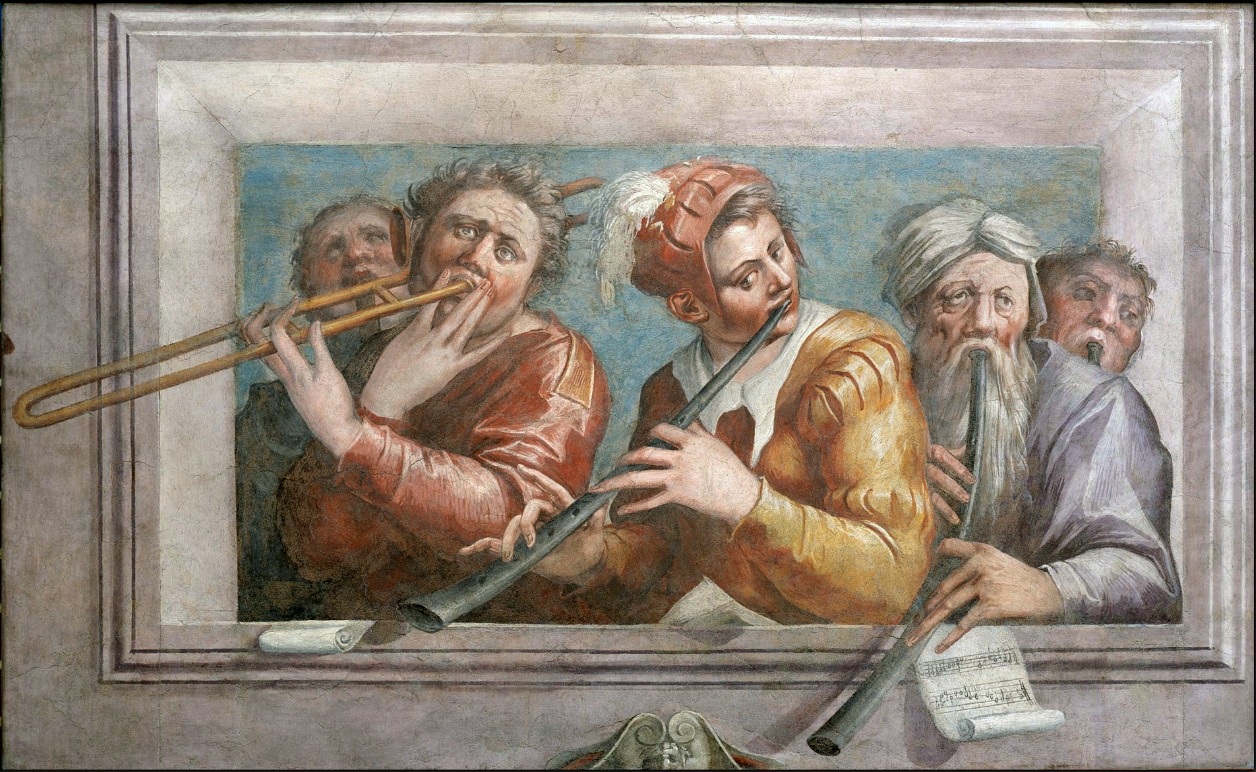
c. 1545—Nuremberg, Germany: An anonymous depiction of a dance, Fastnachtstanz von Metzgern im Jahre 1519 (Carnival Dance of the Butchers in the Year 1519), portrays a trombone as a member of a wind instrument trio providing music for a Nuremberg carnival dance (see detail and full image below; click full image for larger version; public domain) (Salmen, Musikleben im 16 78-79).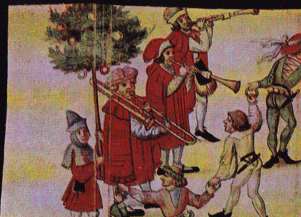
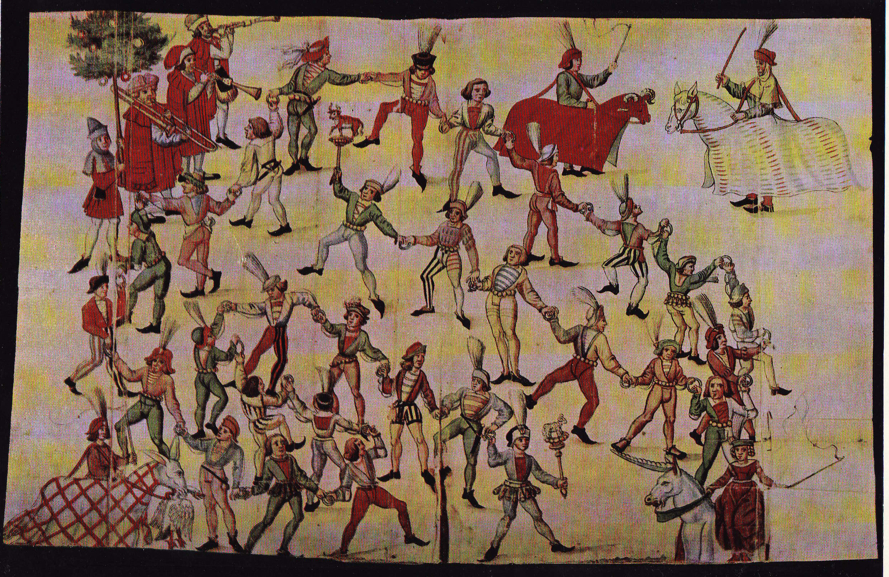
1545—In his description of Le dixiesme livre, a collection of music, Susato reviews the contents: “…containing various chansons for your practice, in which you use instruments that we most often use in the noble and excellent art of music: in war, one uses trumpets, sackbuts [bucines], and German pipes…” (Forney, New Insights 16).
1545—England: The king purchases 5 bass trombones and a tenor trombone (5 grosse busonen and a Myttel busone) from Neuschel, a famous brass maker in Nuremberg, Germany (Herbert, Sackbut 71).
1546—Brussels, Belgium: Philip, who travels to Brussels to visit his ailing father, is greeted into the city with music by cornetts and trombones (Bowles, Musical Ensembles 34).
1546—Antwerp, Belgium: A woodcut in Tielman Susato’s first printed mass book, Liber primus missarum, depicts a religious service with singers and a trombone player. According to one historian, the trombonist can be identified as Susato himself, “…by the robe or tabard he wears reflecting his membership in the city band and by the similarity of this musician to a woodcut showing Susato presenting his first music book…to Mary of Hungary” (Forney, New Insights 3; Forney, New Documents 22-24; Forney, Renaissance 120).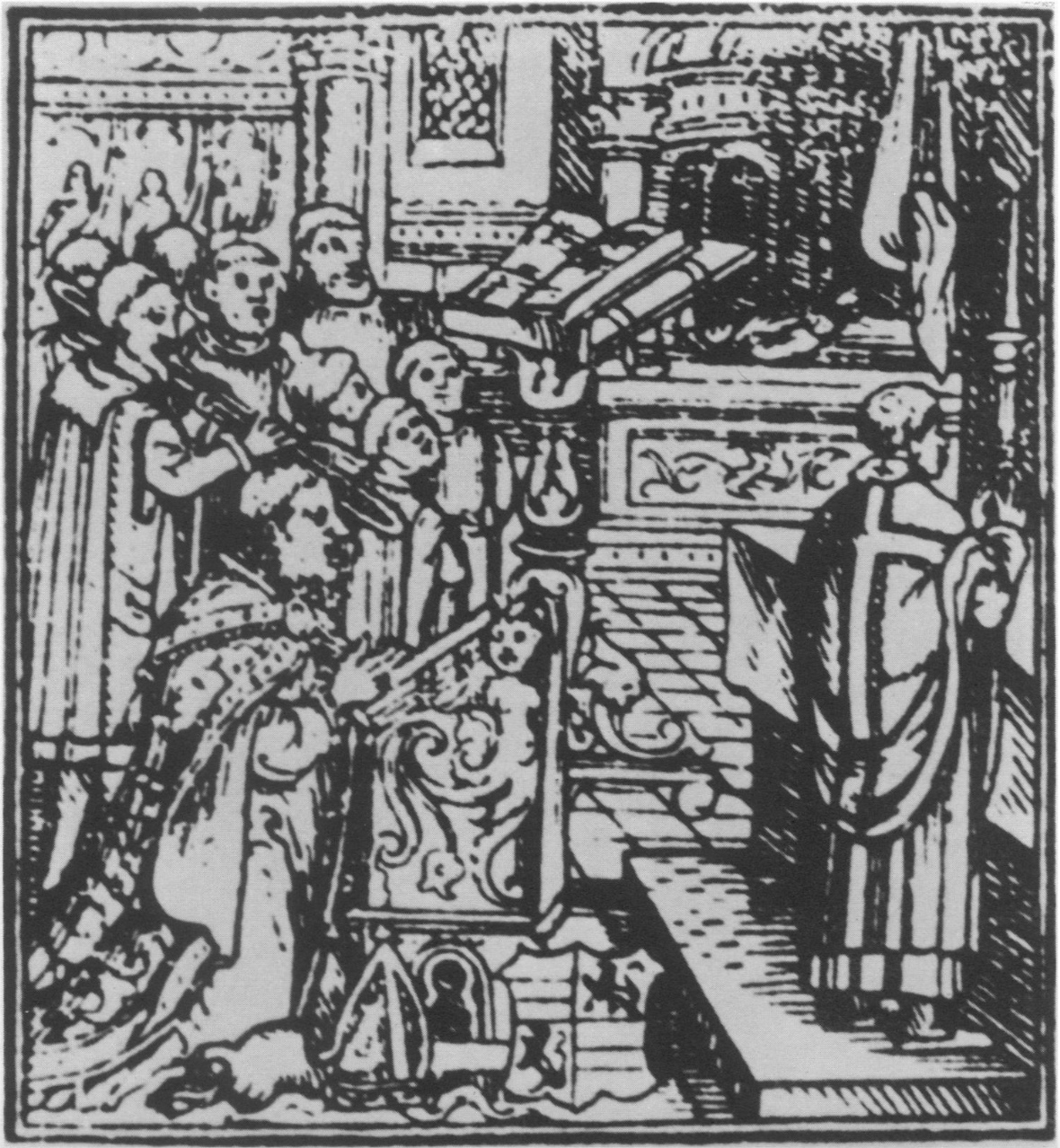
1546—Büdingen, Germany: A fresco by Erhard Sanssdorffer in the castle Grafenschloss depicts numerous musicians, grouped in 2 main ensembles. A trombone is included in the grouping on the right, along with a small bellows-keyboard instrument and what is probably a cornetto or a shawm (see below image; click to expand; public domain) (Salmen, Musikleben im 16 4).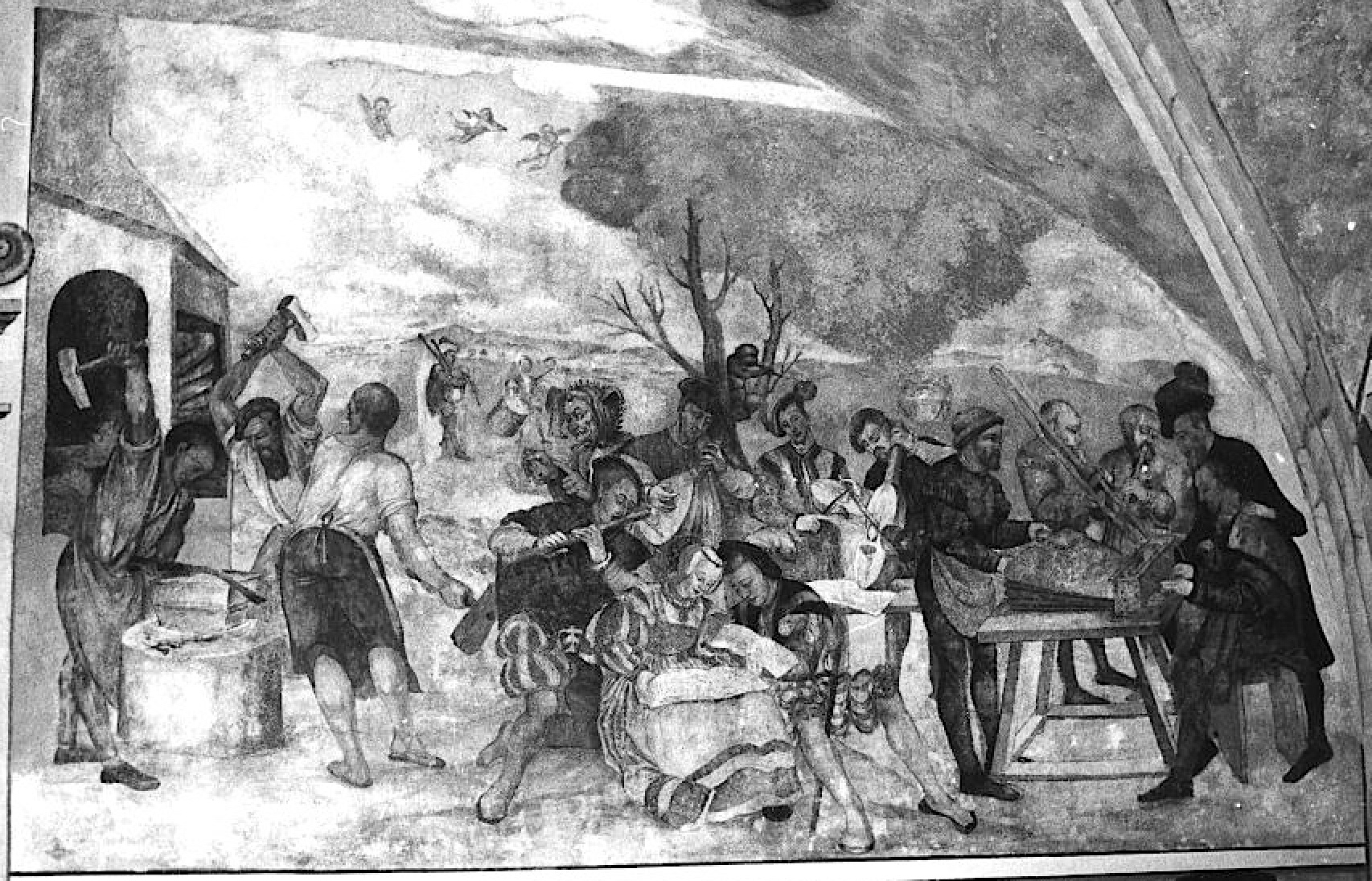
1546—Valencia, Spain: Household accounts show that Duke Ferdinand of Calabria maintains a music chapel that includes trombone and reed players (McMurry; Nelson).
1546—Rome, Italy: Trombone is mentioned on 2 occasions in archives of the Cappella Giulia (Herbert, Trombone 101).
1546—Brescia and Piacenza, Italy: A letter from Vincenzo Parabosco in Brescia to Alessandro Viustino in Piacenza, discussing recruitment of a musical ensemble, offers a glimpse into performance practice: “And I explained everything that Your Lordship wrote concerning how His Excellency our Lord Duke of Piacenza would like to know what kinds of instruments they play and how much they would want for their salary and how many persons make up their company. The first of them that was asked, messer Giovanni Pietro Rizetti, replied to me that they were six in number and that if they came to serve His Excellency they would serve him with these kinds of consorts [Concerti], I say excellently. First [a consort] of trumpets of all the kinds that can be played, then for actual music [a consort of] six trombones [tromboni], then [a consort] of six shawms, then [a consort] of six cornetts, then [a consort] of six crumhorns, then [a consort] of six recorders, then [a consort] of six German-style pipes, then [a consort] of six viole da braccio, then instead of naming other consorts, perhaps Your Excellency would enjoy more than all the others—because it is something unusual and so new that I believe that it will please you exceedingly—the union of those above said instruments, of one type or another, accompanied in various ways by vocal music. All of them are excellent at playing from music and in improvising upon the book of the cantor” (Hill, Emergence 358).
1546—Sienna, Italy: The priors (city rulers), “exasperated by his habitual and unexplained absences,” replace trombonist Ansano Maria di Geronimo with another trombonist named Tulio (D’Accone, Civic Muse 546).
1546-51—Siena, Italy: Ascanio d’Andrea di Lazaro Marri is supernumerary trombonist (a performer not a permanent member of the ensemble) with the Palace wind band. He becomes a regular member of the band in 1551 and the leader of Palace musicians by at least 1566 (D’Accone, Civic Muse 780).
1546-47—Rome, Italy: In the extensive records of St. Peter’s cathedral, a note of payment to an instrumentalist other than the organist appears only 3 times between 1513 and 1578; 2 of the 3 are to a trombonist in 1546 and 1547 (the 3rd is to a cornettist in 1564) (Korrick, Instrumental Music in the Early 16th-Century Mass).
1547—England: Music at the funeral of King Henry VIII includes a consort of 4 Shackebuttes (Bray 269; Whitwell, Renaissance 27).
1547—England: The King’s Musick includes the following trombonists: Robert May, Pelegrine, Marke Anthony Petala, Nicholas Andrewe, Anthony Symonde, and Anthony Mary (Woodfill 298).
1547—France: A band of 6 shawms and trombones performs at the funeral of King Francis (Whitwell, Renaissance 66).
1547—France: King Henry II visits Lyons. One of the pieces composed to celebrate the visit is Piero Manucci’s “Io che del Bronzo fui,” an intermedio sung by 4 voices and accompanied by 3 crumhorns and a sackbut (Whitwell, Renaissance 76).
1547-61—England: Inventories of Cambridge University Musicians list a shacke butte, held by university wait Benet Pryme (c. 1546-57) (Payne 304).
1548—Germany: A tapestry depicting a wedding dance features an ensemble of 2 trumpets and a trombone playing from a balcony (see below image; public domain) (Schlossmuseum, Berlin [now lost]; Führer lurch das Schlossmuseum, pl. 30).
1548—In a description of the intermedio La Calandvia for Bernardo Dovizi, mention is made of a work by Piero Manucci. The piece, L’eta mi Chiamo Aarato e venga a 5, calls for 5 voices, 2 cornetts, and 3 trombones (Collver 188).
1548—Brescia, Italy: The Tola brothers and 3 fellow musicians, who claim to play shawms, trombones [Tromboni], cornetts, fifes, recorders, dulcians, and violins, make a petition before the city government and are subsequently adopted as the Brescia civic wind band (piffari) (Hill, Emergence 338, 361).
1548—Brescia, Italy: A trombonist is among the piffari who petition for a raise, their rationale being that, in their words, “this liberality will cause these petitioners to close their ears to many foreign lords, who try continuously, by various means and with offers of very honorable salaries, to have them at their courts” (Hill, Emergence 361, 363).
1548—Siena, Italy: Giovanfrancesco di Benedetto de’ Vedi becomes trombonist with the Palace wind band. In 1558 he is granted permission to play in the cathedral. In 1562, having overstayed a leave, he is condemned to serve 6 months without salary. In 1565 he is sued for not sharing gratuities. In 1565 he is imprisoned. In 1570 he sues another player for not sharing gratuities. In 1588 he is granted a leave (D’Accone, Civic Muse 786).
1548-49—Siena, Italy: Clothing records for Assumption Day performances indicate that 3 of the 7 members of the Palace wind band are trombonists (D’Accone, Civic Muse 570).
1549—Munich, Germany: Outdoor Feast, a painting by Hans Mielich (Müelich), court painter for Duke Albrecht V, depicts an outdoor wedding banquet. The music ensemble includes 2 trombone players, one of whom may be emptying water from his instrument and/or holding multiple instruments. The painting also shows, in a different area, a dance band consisting of 2 trombones and another instrument (probably a shawm) (see detail and full image below; public domain image) (Kenton plate 14; Buchner plate 95). Special thanks to Tassos Dimitriadis.

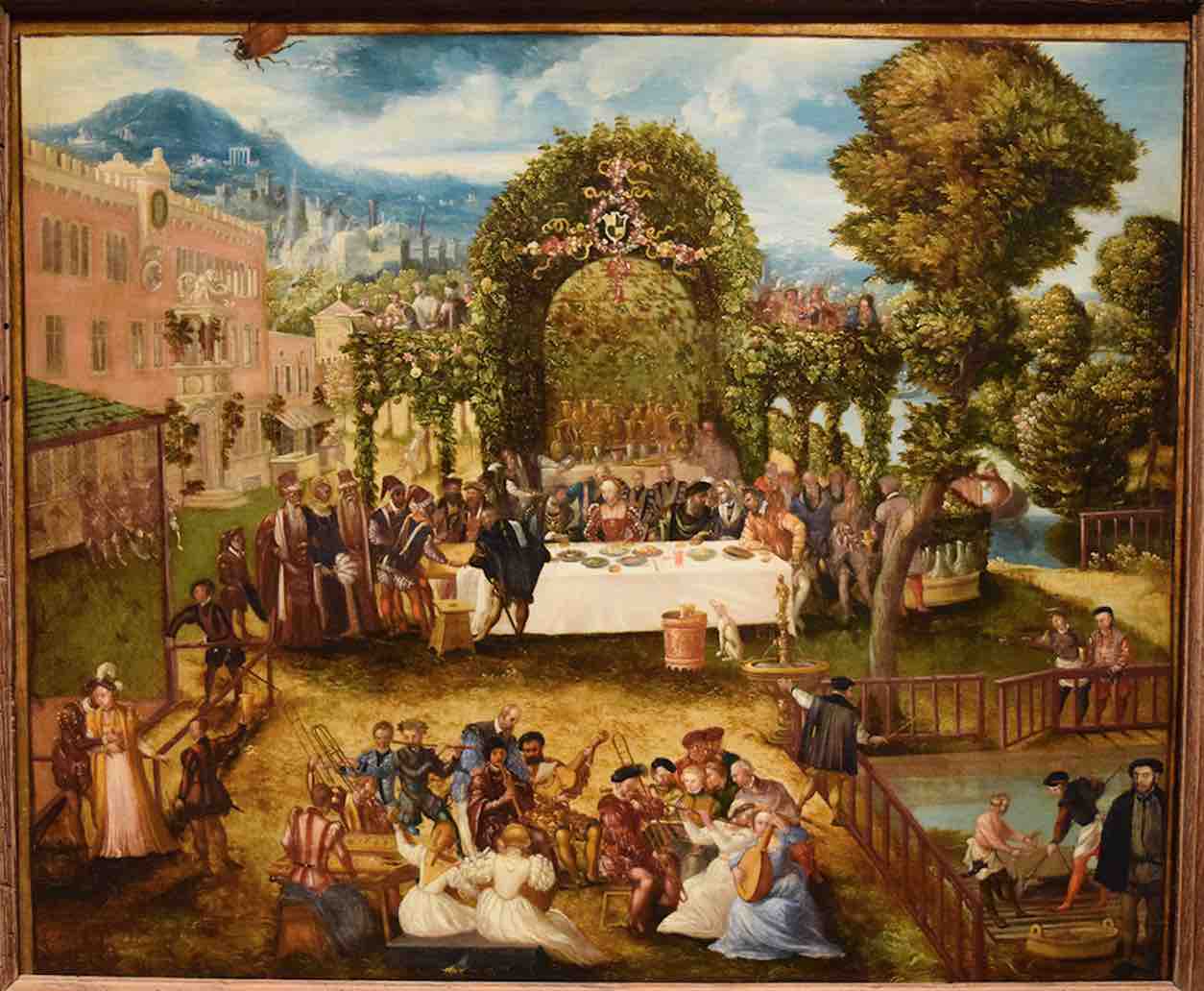
1548/49—Siena, Italy: Clothing lists for town wind band performances for Assumption Day include the follow 3 trombonists: Benedett, Tulio, and Giovanfrancesco di Benedetto (D’Accone, Civic Muse 570).
1549—Bruges, Belgium: The city hires trombonist Jan Leunis, who had recently left his position as chapel master at St. Jacob’s church. Leunis apparently possesses a difficult personality, as the ensemble soon becomes embroiled in repeated disputes, so upsetting the city council that they threaten to dismiss all of the musicians because of their “great irreverence, unmannered and wretched manner of living” (Polk, Susato 76).
1549—Toledo, Spain: Blas Ortiz, vicar general of the Toledo diocese, writes of the ministriles, y sacabuches, y instrumentos used at Mass and in the divine office at the cathedral (Stevenson, Spanish 122).
c. 1550—Netherlands: Artist Martin van Heemskerck includes a trombone-playing muse in his panel painting, Apollo and the Muses (see below image; public domain; wikimedia commons) (New Orleans Museum of Art). This instrument appears to be relaitvely small and is perhaps an alto trombone. Colin Slim proposes the date 1546 in his article, “On Parnassus with Maarten van Heemskerck,” part II (Musica Disciplina, 1997).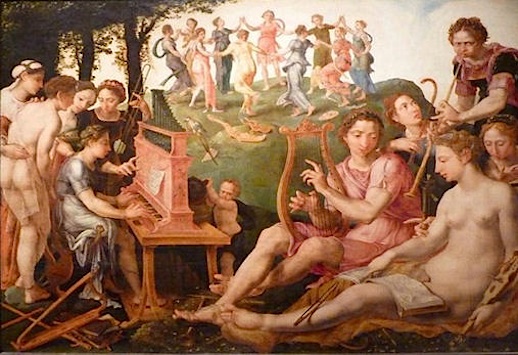
c. 1550—A leaf of various studies by artist Virgil Solis (1514-62) includes 2 trombones (see upper-right and lower-middle of below image—click for larger version; public domain) (Louvre).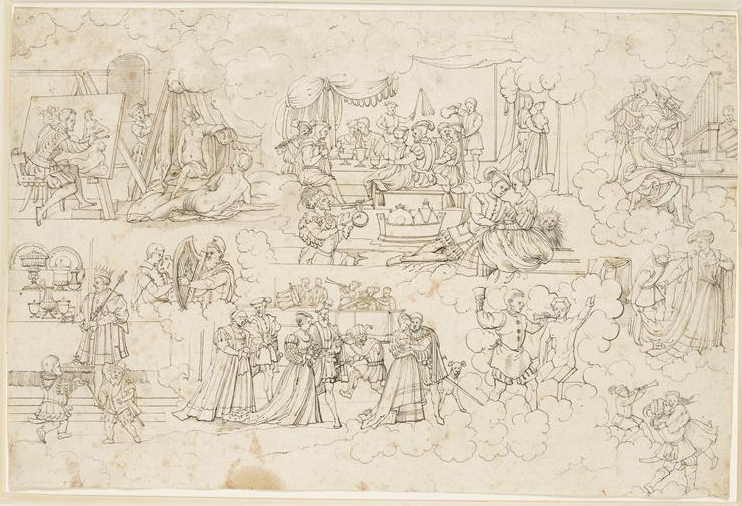 c. 1550—Nuremberg, Germany: Musica, a print by Virgil Solis, includes a trombone hanging on the wall (see below image; public domain) (French National Library).
c. 1550—Nuremberg, Germany: Musica, a print by Virgil Solis, includes a trombone hanging on the wall (see below image; public domain) (French National Library).
c. 1550—Abran writes Tant vous alles doux, Guillemette a 6, for 2 cornetts and 3 trombones (Collver 40).
c. 1550—Nuremberg, Germany: Patriziertanz im Grossen Nürnberger Rathaussaal, an anonymous image depicting a dance in Nuremberg’s town hall, includes 2 trombonists among the 5 wind musicians providing the dance music from the balcony. One of the unusual aspects of the image is that both trombonists have banners hanging from their slides (see detail and full image below; click on large image for larger version; public domain) (Nuremberg, Stadtavchiv; Salmen, Tanz im 17 148).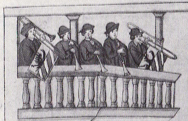

c. 1550—A painting attributed to Cornelis Kettel called La fete des rois includes a trombonist performing with a wind trio at a royal feast (see detail and full image below; public domain) (French National Library).

c. 1550—Leon Davent’s print, Musicians (left half of A King Kneeling before an Altar) includes 2 trombones (see below image; public domain) (source: C & J Goodfriend Drawings and Prints).
c. 1550—Verona, Italy: A painting of angel musicians by Domenico Brusasorzi (also called Domenico Brusasorci and Domenico Riccio) in the Chiesa di Santa Maria in Organo includes what is probably a trombone. Although the bell section is longer than the slide, the slide is still quite long and is gripped like a slide of the time; also, the rear bow of tubing extends behind the player’s shoulder (see below image; public domain) (Paganuzzi, La Musica a Verona, fig. 307).
1550—According to historian John Morehin, “By the middle of the sixteenth century cornetts and sackbuts were probably heard in church [in England] more often than any other instrument with the exception of the organ, at least on important occasions” (Morehin 141).
1550—Brussels, Belgium: The town wind ensemble expands from 5 to 6 players, probably consisting of 2 shawms, 2 tenor shawms, and 2 trombones (Polk, Susato 82; Polk, Instrumental).
1550-1556—Huejotzingo, Puebla, Mexico: A stone carving on one of the 4 posa chapels occupying the corners of the atrium of the church of the Franciscan monastery of San Miguel, Huejotzingo features 2 trombone-playing angels (see below image; public domain) (Viñuales and Gant 23; Donahue-Wallace 12).
1550-1599—A pen, wash, and ink drawing, now held in Szépmüvészeti Múzeum, Budapest (Museum inv. No. 2421), features a group of 7 angel musicians, including one playing trombone (see below image; public domain).
1550-1600—Italy: An anonymous painting from the Florentine School portrays an instrumental ensemble with diverse dress and a mixed grouping of winds, strings, and keyboard (see below image; public domain) (Louvre).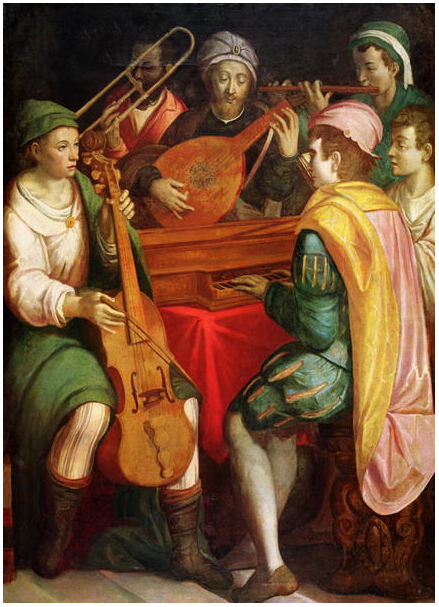
1551—Bologna, Italy: Trombone is included in a list of musical instruments that comprise part of a didactic game in Ringhieri’s Cento Giuochi Liberali (Haar, On Musical Games).
1551—Bologna, Italy: A “Vincenzo Trombone” is mentioned, in a list of Bolognese musicians active c. 1550, by Innocentio Ringhieri in Cento Giuochi Liberali, et d’ingegno (Harr, Science and Art 349).
1551—Nuremberg, Germany: The oldest existing trombone is made by Erasmus Schnitzer. A tenor trombone, it is also the earliest know brass instrument from that manufacturing center, an area which becomes a hot spot in the field for several hundred years (Barclay 30). The tube length of the instrument, a tenor trombone, would indicate it was pitched in C, but, considering rising pitch standards, may have been considered in B-flat at the time (Gregory 30). The instrument, as with all early trombones, has a relatively narrow bore; no spit valve; flat, removable stays; very little terminal flare; and no stockings (Baines, Brass 111). It is held in Germanisches Nationalmuseum (Herbert, Trombone 311).
1551—Brussels, Belgium: Trombonist Jehan vander Maerle is named as a musician at the court of Mary of Hungary (Polk, Susato 67).
1551—France: After this date, an anonymous Nativity long attributed to engraver Jean de Gourmont is painted. The painting includes a cherub playing trombone (see detail and full image below; click on picture for larger version; public domain) (The Louvre).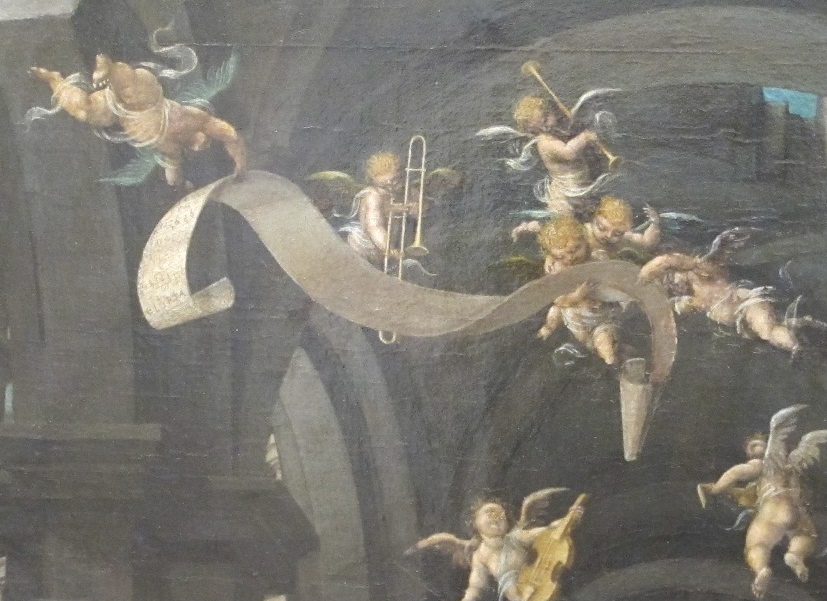
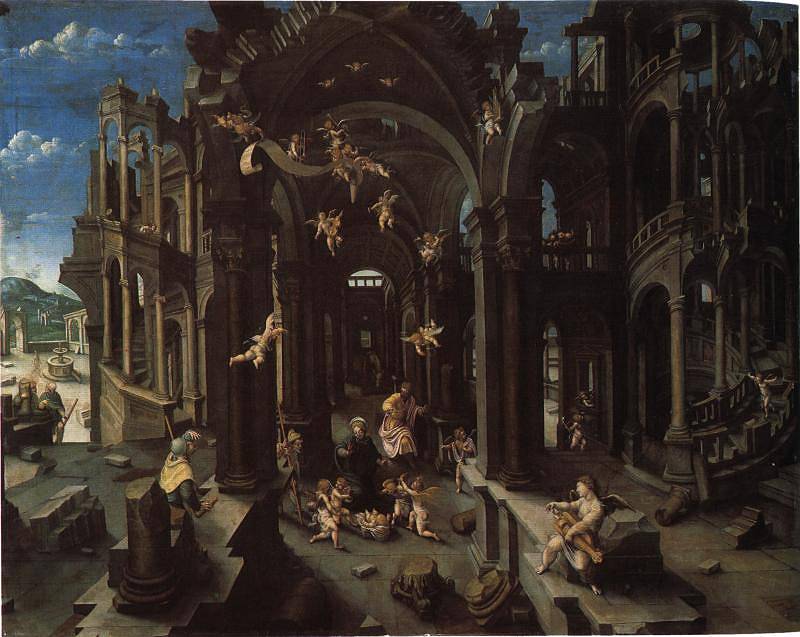
1551-54—Florence, Italy: Records for the household of Lorenzo, duke of Urbino, list 5 trombone players (D’Accone, Musical Chapels).
c. 1552—Verona, Italy: A fresco by Domenico Brusasorzi (also called Domenico Brusasorci and Domenico Riccio) in the church of Santo Stefano depicts angel musicians, including a trombonist, performing from a balcony (see detail and full image below; public domain) (Paganuzzi, La Musica a Verona, fig. 132). Special thanks to Michele Magnabosco.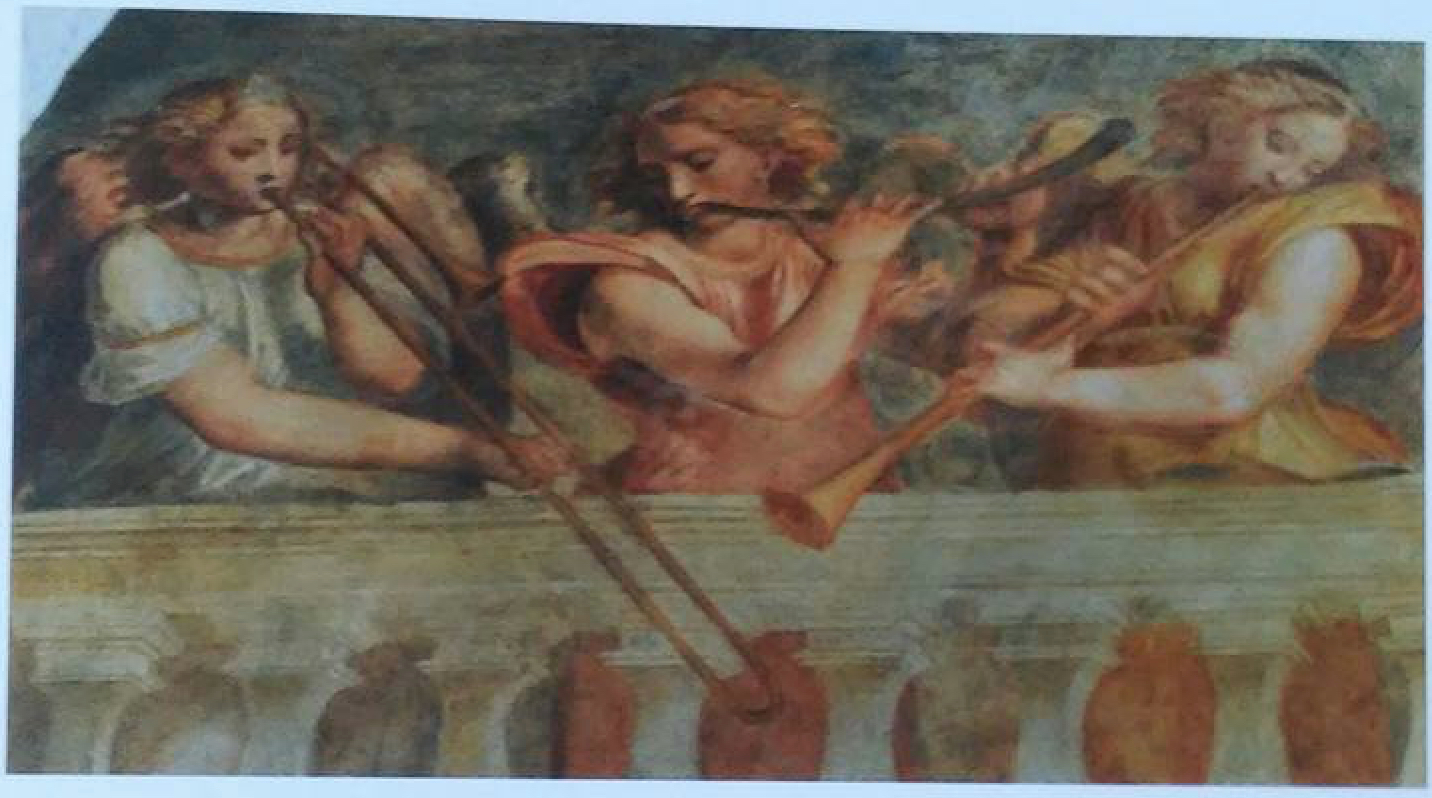
1552—Treviso, Italy: Giovanni Nasco sends music, including an arrangement for trombones, to Accademia Filarmonica in Verona: “Now having newly composed these little things at the request of the magnificent Monsignor Miani, Venetian gentleman, that is the madrigal ‘Donna vostra belta,’ the other with low voices arranged for the trombones…” (Tim Carter, Music in Late 163; Elias, Musical Performance).
1552—France: a document mentions the shawm and sackbut band of King Henry II (Whitwell, Renaissance 76).
c. 1553—Cremona, Italy: A panel on the organ loft at chiesa Sant’Agostino features a depiction of trombonist (see below image; public domain).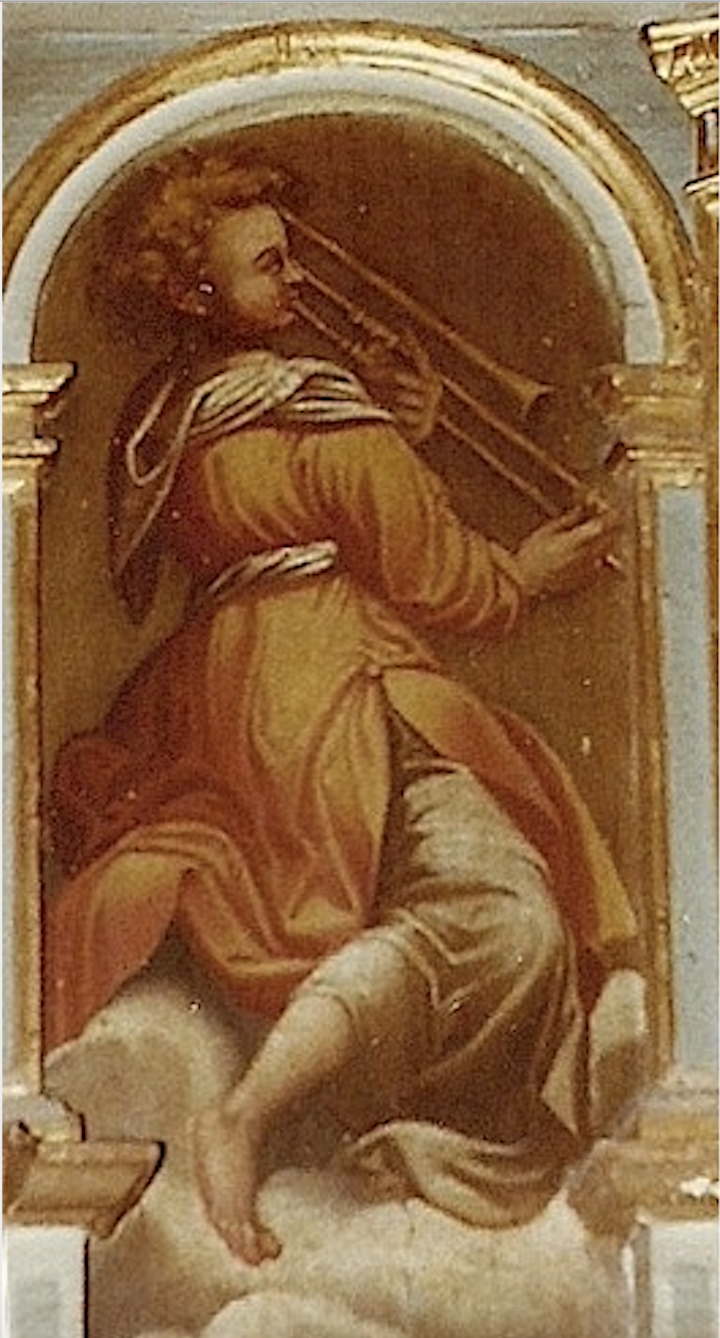
1553—Seville, Spain: The salaried Cathedral wind band established in 1526 apparently having deteriorated or disbanded, church officials decide that Cathedral instrumentalists should again be offered long-term contracts. Subsequently contracts are offered to 3 trombone players: Andrés Deça, Juan Baptista, and Martín de San Pedro (Stevenson, Spanish 144; Stevenson, La Music 40).
1553—Peru: Sometime before this date, a number of trained secular musicians arrive in the country, including a trombonist named Juan Ramiriz (Stevenson, Music Instruction in Inca Land).
1553—London, England: The minutes of the Court of Common Council list the instrumentation of the London Waits as trumpets, shawms, sackbuts, fife, drums, and cymbal for loud music and flutes and a lute for soft music (Whitwell, Renaissance 158).
1553—Milan, Italy: Ferrante Gonzaga, governor of Milan, maintains a wind band that includes at least one trombone. When a trombonist by the name of Orfeo requests to be released from service to play elsewhere, the leader of the ensemble expresses alarm, writing to the governor that it “would be in grand damage to the music of your Excellency” (Getz 170).
1554—Venice, Italy: Saba di Castiglione’s Ricordi overo Ammaestramenti is published. In Ricordo CIX, discussing the decoration of wealthy houses, Castiglione says, “Some adorn [their rooms] with musical instruments such as organs, harpsichords, monochords, psalteries, harps, dulcimers, baldosi, and others like that; and others with lutes, viols, violins, lire, recorders, cornetts, shawms, cornamuse, dianoni, trombones [tromboni], and others such as these” (Boydell, Crumhorn 294).
1555—Denmark: King Christian III evidently employs trombones at his court; he orders, from brass instrument maker Georg Neuschel, “1 quart-trombone, which is very good” and “2 tenor trombones, with one-tone crooks with which they may be lengthened, which are good.”
1555—London, England: The city buys a second sackbut for their town waits (Woodfill 34).
1555—London, England, liveries for the King’s Musick include 8 sackebutts (De Lafontaine 9).
1556—Siena, Italy: Because of political changes and financial difficulties, the city’s wind band is decreased from at least 7 full-time musicians to 5 players: 3 pifferi and 2 trombonists. A new set of statutes is drawn up for the ensemble, stating that the musicians, with their “flutes, trombones, and cornetts,” are to be “in constant readiness to play for the captain of the people and the lord priors [city rulers]” at all the required times and occasions decided upon by the ruling bodies (D’Accone, Civic Muse 577).
1556—Siena, Italy: Palace inventories list “a silver trombone, broken, with its pieces” (D’Accone, Civic Muse 587).
1556—Brussels, Belgium: Mary of Hungary retires, relocating to Spain and taking with her a trombonist by the name of Jehan van der Maerle (Thompson, Mary of Hungary).
 1556-59—Venice, Italy: Matteo Pagan’s Procession in St. Mark’s Square on Palm Sunday includes what appears to be an awkwardly-rendered trombone, labeled trombe piffari, among the members of the wind band (see far left of facing image; public domain) (Landon 36; Fenlon, Magnificence 34; Venice, Museo Correr).
1556-59—Venice, Italy: Matteo Pagan’s Procession in St. Mark’s Square on Palm Sunday includes what appears to be an awkwardly-rendered trombone, labeled trombe piffari, among the members of the wind band (see far left of facing image; public domain) (Landon 36; Fenlon, Magnificence 34; Venice, Museo Correr).
c. 1557—Murano, Italy: Paolo Caliari (also called Veronese) paints The Seven Planetary Gods on the ceiling of the first floor of Palazzo Trevisan. The fresco, which includes a cherub or putto playing trombone, is later transferred to canvas and housed in the Louvre, Paris (see middle-right of below image; public domain).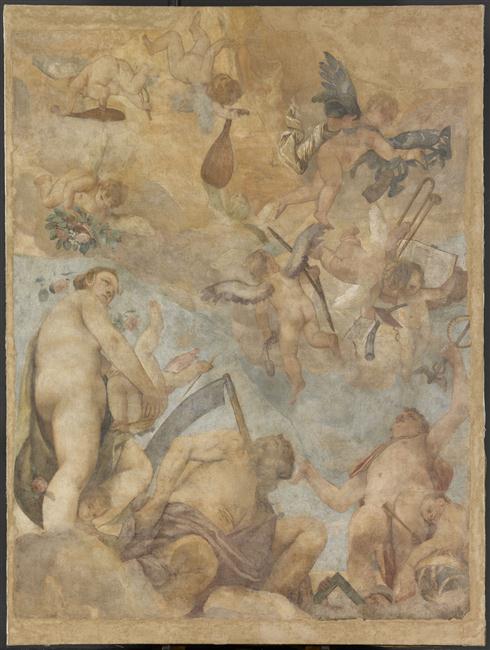
1557—Nuremberg, Germany: The second-oldest extant trombone is made by Jörg Neuschel (Carse, Musical 252). In the words of Philip Bate, “The instrument is, in fact, in all major respects a trombone as used today, the only differences being in the loose stays… and in the less marked ‘flare’ of the bell” (Bate 134). The holder is Sammlung alter Musikinstrumente, Kunsthistorisches Museum, Vienna (Herbert, Trombone 311).
1557—Padua, Italy: The chapel at St. Antonio replaces a full-time cornettist with a trombonist (Dickey, The Cornett 58).
1558—Germany: Krüger publishes a volume of chorales with accompaniments of organ and 4 to 6 trombones (Daubeny 95).
1558—Liverpool, England: Sackbut is the earliest instrument, after the shawm, to be bought by the city for its town waits (Woodfill 85).
1558-60; 1565-73—Siena, Italy: Giovanfrancesco di Benedetto, who is also a Palace musician, serves as cathedral trombonist (trombone in cappella) (D’Accone, Civic Muse 738).
1559—Munich, Germany. A collection of works by composer Cipriano de Rore, illuminated by court painter Hans Mielich, includes several images of trombones (see below 3 images; public domain) (Bayerische Staatsbibliothek, Mus.ms. B).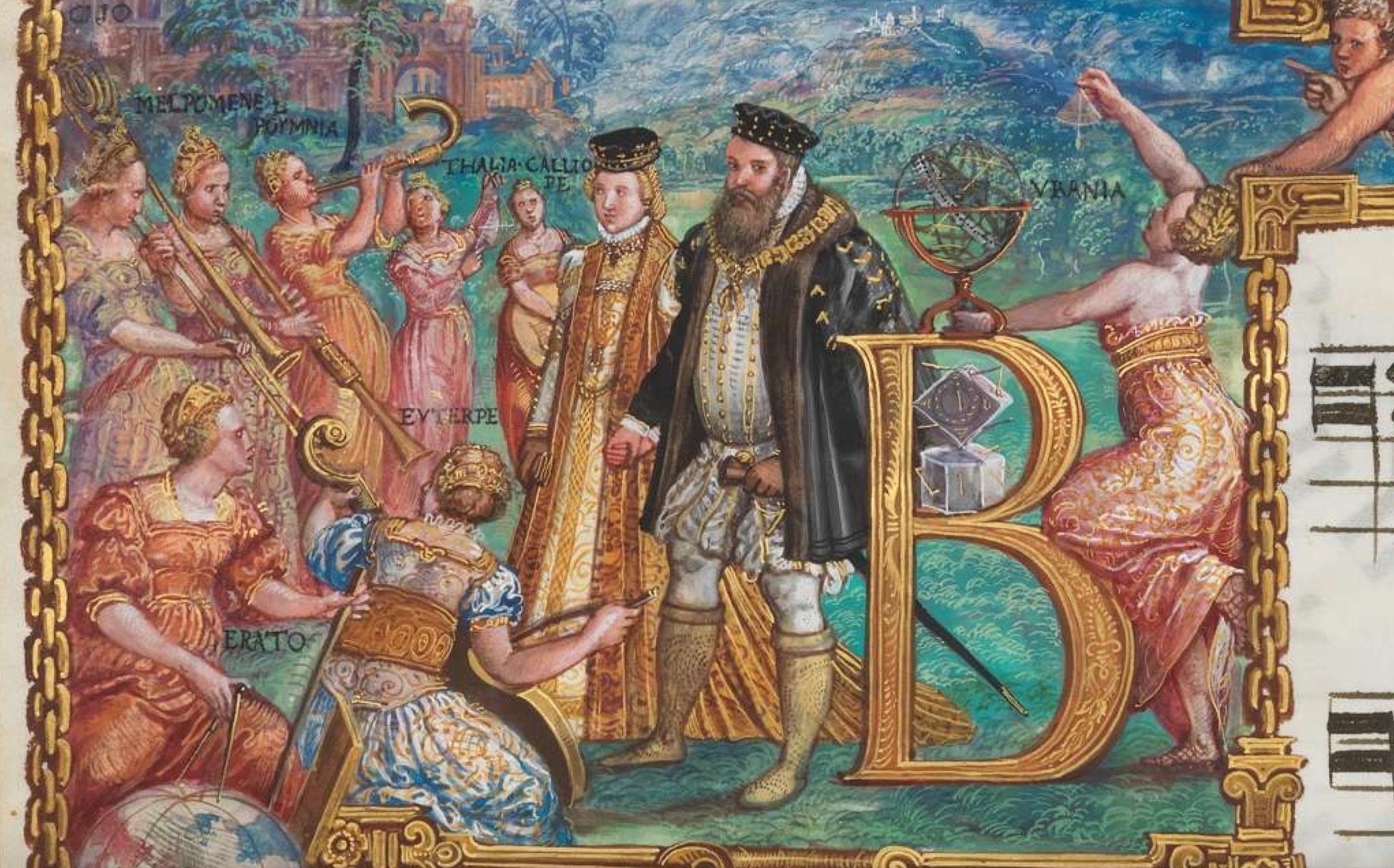
1559—London, England: Music at the coronation of Queen Elizabeth includes a consort of 6 Shackebuttes (Bray 270).
1559—London, England: The city buys a third trombone for their town waits (Woodfill 34).
1559—Valencia, Spain: Author and former musician Jorge de Montemayor writes the pastoral novel, La Diana. In the story, Celia’s serenade, termed a “concierto que parescía una música celestial,” is performed by harpsichord, 3 trumpets, and sackbut (Damiani, Music in La Diana).
1559—Siena, Italy: The nuns at Santa Petronilla hire “five singers from the duomo and the Palace trombone” for a Good Friday performance of “the Passion in figural music” (D’Accone, Civic Muse 630).
1559—Milan, Italy: Carnival celebrations at the Milanese court include “an excellent music of bowed viols, trombones [tromboni], cornets, and voices…playing their instruments so sweetly and harmoniously [soavemente che all’armonia]” (Getz 201).
1560—The Geneva translation of the Bible is the first to mistranslate the Hebrew word sambuca (a type of harp) into sackbut in 3 passages in the third chapter of Daniel. The error, which originates in the Latin Vulgate, is perpetuated in later translations and leads to the misconception that the trombone is an Old Testament instrument of great antiquity (Herbert, Sackbut 68).
1560—Bologna, Italy: Trombonist Alfonso Viola is the first instrumentalist hired at San Petronio (Guion, Missing Link).
1560—Seville, Spain: A new trombonist, García Gonsales, is hired as a cathedral musician (Stevenson, Spanish 149).
1560—Seville, Spain: A father and son pair—Melchor de Camargo (soprano shawmer) and Gaspar de Camargo (trombonist)—are hired to be cathedral instrumentalists (Stevenson, Spanish 149).
1560—Valencia, Spain: A quartet of cathedral instruments includes trombone. Interestingly, both sacabuig and trompon are listed in the document, indicating a possible distinction or a confused scribe (Kreitner, Minstrels in Spanish Churches).
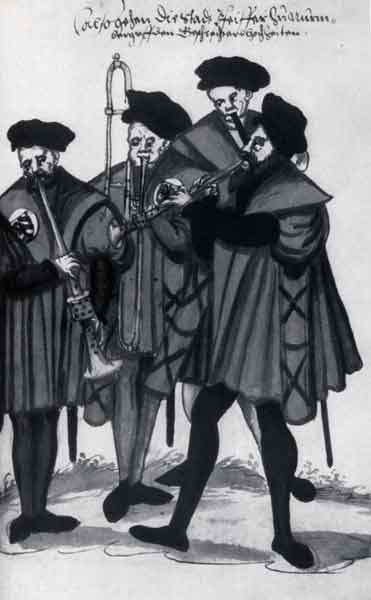 c. 1560-80—Nuremberg, Germany: Municipal Wind Players, an image from the Heldt’schen Trachtenbuch, shows a trombone playing in a wind band. The musicians wear the costume and badges of civic musicians (see facing image; public domain) (Berlin, Kunstbibliothek).
c. 1560-80—Nuremberg, Germany: Municipal Wind Players, an image from the Heldt’schen Trachtenbuch, shows a trombone playing in a wind band. The musicians wear the costume and badges of civic musicians (see facing image; public domain) (Berlin, Kunstbibliothek).
1561—Spain and Mexico: Philip II of Spain issues the following order to the president and oidores of the royal audiencia of Mexico: “Because of the cost of maintaining the present excessive number of instrumentalists who consume their time playing trumpets, clarions, chirimías, sackbuts, flutes, cornetts, dulzainas, fifes, viols, rebecs, and other kinds of instruments, an inordinate variety of which are now in use in the monasteries,…and because the number of musicians and singers is reported to be increasing constantly in both large and small towns,…and because very many of those reared simply to sing and play on instruments soon become lazy scoundrels whose morals are reported to be extremely bad,…and because in many places they do not pay tribute and resist lawful authority, we require a reduction in the number of Indians who shall be permitted to occupy themselves as musicians” (Stevenson, Music in Mexico 65).
1561—London, England: A witness of Christmas entertainments at the Temple reports, “At every course the trumpeters blew the courageous blast of deadly war, with noise of drum and fyfe, with the sweet harmony of violins, sackbuts, recorders, and cornetts, with other instruments of musick, as it seemed Apollos’ harp had tuned their stroke” (Nichols 134).
1561—Ferrara, Italy: During the carnival season at the court of Alfonso II d’Este, an outdoor dramatic tourney includes a musical element, as recorded at the time: “Six participants from the playing-field appeared, and mixed, deafening sounds were heard from kettledrums, cornetts and trombones [from] behind the loggia of the towers” (Bowles, Timpani 362).
1562—Venice, Italy: Duke Alfonso II d’Este from court of Ferrara visits and brings 30 musicians, including 18 singers, 7 cornett and trombone players, 3 organists, and 2 viol players (Fenlon, Venice 122).
1562—London, England: The following is recorded about festivities at the Inner Temple: “The Prince so served with tender meats, sweet fruits, and dainty delicates confectioned with curious Cookery…and at every Course the Trumpetters blew the courageous blast of deadly War, with noise of Drum and Fyfe, with the sweet harmony of Violins, Sackbutts, Recorders, and Cornetts, with other Instruments of Musick, as it seemed Apollo’s Harp had tuned their stroke” (Wienpahl, Music at the Inns of Court 102).
c. 1562-68—Germany: An embroidered tablecloth depicts an aristocratic woman playing trombone. The people in the middle of the tablecloth are Count Poppo of Henneberg and wife Sophie of Brunswick (see detail and full images below; click image to expand; public domain) (Herbert, Trombone 79). The top detail, below, is from a 19th-century color engraving that is a copy of the original tablecloth (Hefner-Alteneck, vol. 9, pl. 594). The second image is a photo of the original tablecloth, now lost (Newe deudsche gesitliche Gesenge, unpaginated front matter). The third is the full 19th-century copy that the top detail is drawn from.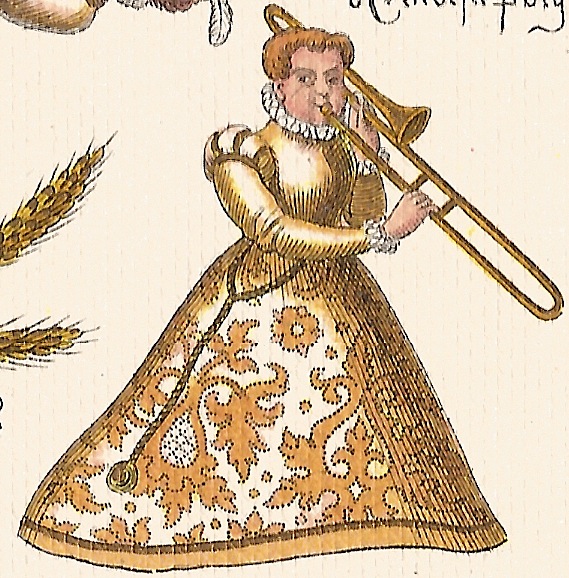
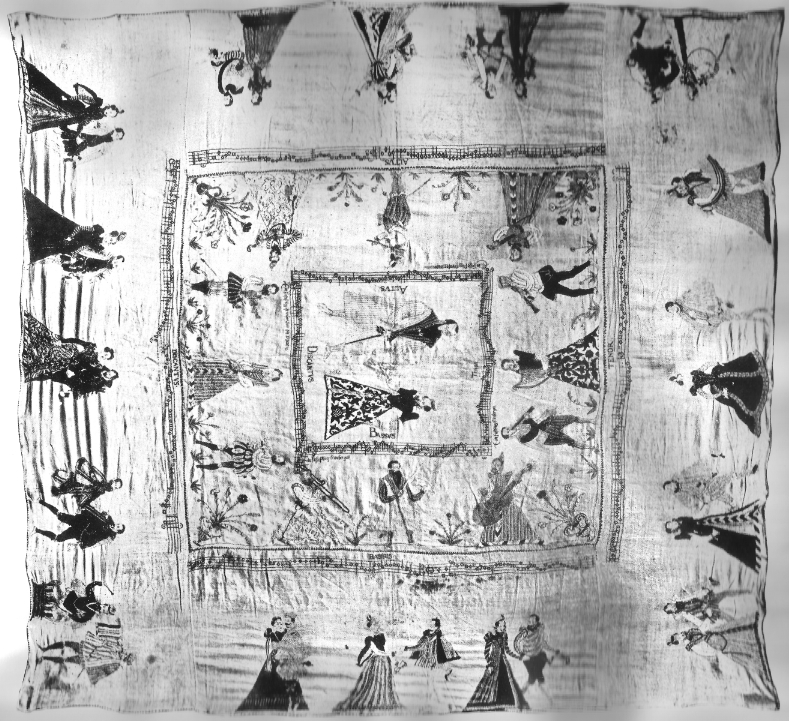

1562-83—Modena, Italy: A trombonist is on the payroll at the Modena Cathedral (Herbert, Trombone 101).
1563—Seville, Spain: Authorities vote to increase the salaries of 5 Cathedral instrumentalists, including trombonists Juan Baptista, Diego López, and Gaspar de Cuevas (Stevenson, Spanish 151).
1563-70—Munich, Germany: An elaborately illuminated 2-volume manuscript of Orlando di Lasso’s collection of motets, Psalmi Poenitentiales or Busspsalmen (Penitential Psalms), includes several depictions of trombones. The illuminations are by Hans Mielich, painter for the Bavarian court. In the most famous image (see top image below), a contemporary depiction of the Bavarian court, Mielich depicts Orlando di Lasso, seated at the keyboard, with his ensemble of court musicians around him, including trombone, cornett, woodwinds, and strings. That image and the 2 images following it (below) come from the second volume of the manuscript. The final 3 images below are from the first volume (public domain images) (Munich, Bayerische Staatsbibliothek, Mus. Ms. A, I and II).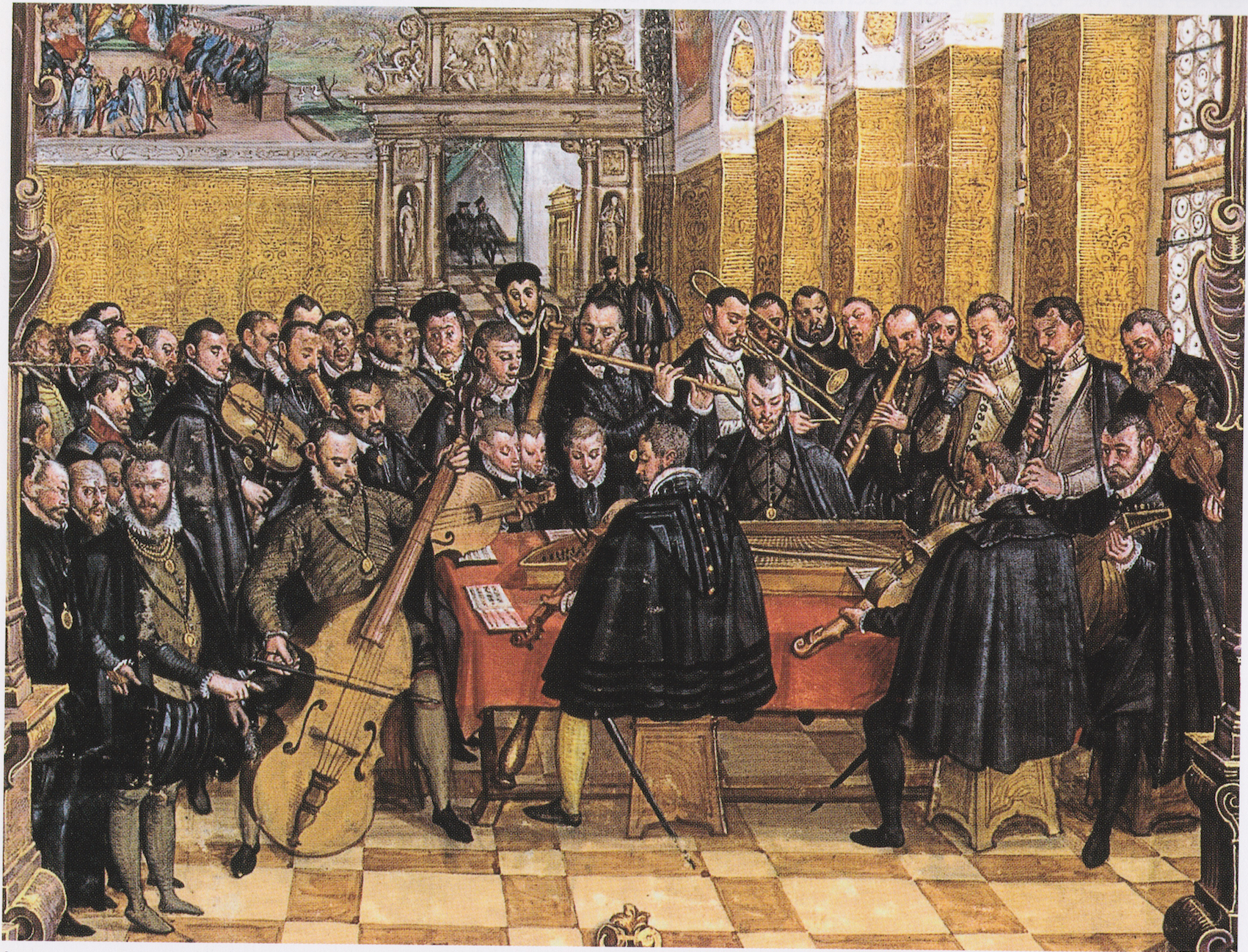
1564—Fontainebleau, France: Celebrations at the residence of Alexander Edward, Duke of Orleans, in connection with a visit by the Pope’s ambassadors, include a performance by 2 shawms and a trombone (“deux hault boys, et une saqueboutte”) (Garcia; Graham and Johnson 152).
1564—France: Celebrations on the Isle of Aiguemeau in the Adour river in honor of the Spanish King and Queen feature various aquatic entertainments. Among these entertainments are 6 trombonists (“seis menestriles con carnamutas sacabuches”) disguised as tritons, riding on the back of an enormous turtle. They perform both to introduce Neptune and, later, while Neptune speaks in verse to the monarchs (Garcia; Graham and Johnson 316).
1564—Siena, Italy: Tiberio di Girolamo Rivolti, a trombonist recently hired at the Siena palace, has his meal privileges revoked, apparently for some misdeed. The following day, the order is reversed, and Tiberio is described as “a musician of tender age and of much musical promise.” Four years later, while he is still Palace trombonist, Tiberio is ordered to jail “for writing injurious words on the wall and lying to a colleague.” He eventually becomes one of the most well-respected performers to come out of 16th century Siena (D’Accone, Civic Muse 581, 795).
1564—Sevilla, Spain: At the Seville Cathedral, a bronze medallion by Juan Marin and Bautista Vazquez portrays 2 trombones performing with a cornett and 2 shawms. The 5 players are all gathered around a single music stand (see below image; public domain) (Kreitner, Minstrels in Spanish Churches).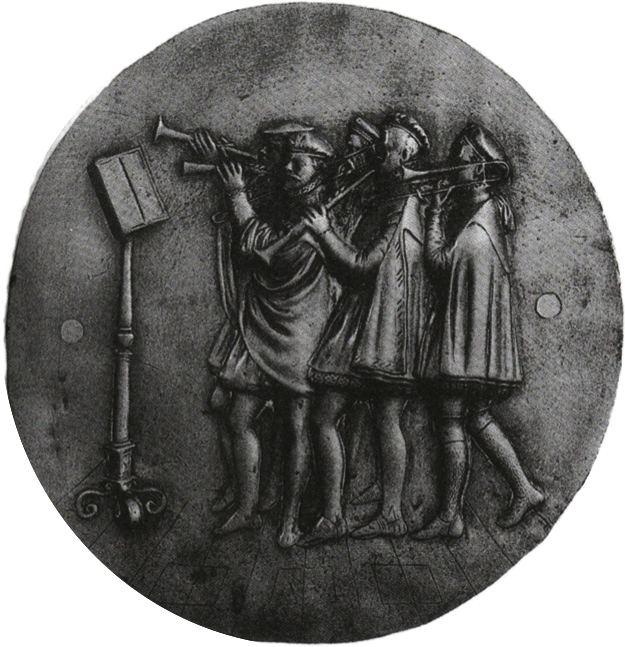
1565—Musica, an engraving by Dutch artist Cornelis Cort from a series called the Seven Liberal Arts (after works by Frans Floris) includes a small trombone hanging on a wall in the background (see below image—click to expand; public domain) (Burgers 99).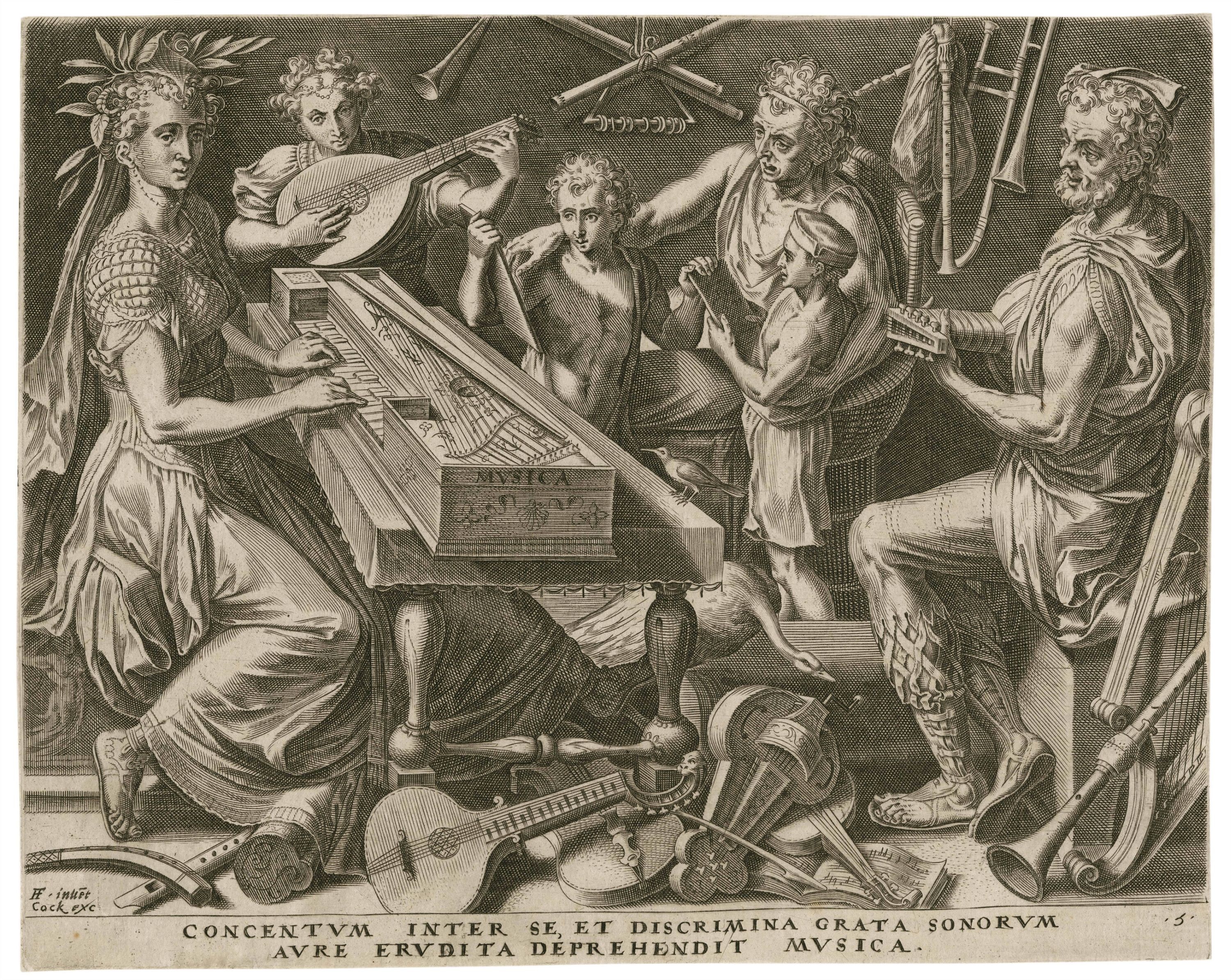
1565—Padua, Italy: A trombone player is employed at the Padua Cathedral (Herbert, Trombone 101).
1565—In an intermedio reported by Orlando di Lasso, trombones (pusaunen) accompany a battle scene (Weaver, Sixteenth-Century Instrumentation).
1565—Florence, Italy: Duke Cosimo de’ Medici writes to Averardo Serristori, his ambassador in Rome, about the need for a boy soprano. One of the requirements for the singer is that he be able to perform along with violins and trombones: “It so happens that in an intermedio for the comedy which is being prepared for performance on the arrival of the Princess [Joanna] there is a need of a boy’s voice as a soprano….We tell you that he has to sing alone in a large room in company with four violini and four tromboni.” The musician hired is Giulio Caccini, who becomes known for his pioneering efforts in early opera (Carter, Giulio Caccini).
1565—Florence, Italy: Wedding festivities for Prince Francesco de’ Medici and Johanna of Austria include performance of the comedy La Cofanaria by Francesco d’Ambra, with interludes (intermedii) between the acts. The trombone is used in several different settings. The 1st intermedio, for example, calls for 2 trombones (Westrup, Monteverdi and the Orchestra), and the 5th intermedio features Striggio’s madrigal Fuggi mia speme, fuggi, accompanied by 4 violins and 4 offstage trombones (Bowles, Musical Ensembles 53). Duke Ferdinand of Bavaria, a guest at the wedding, writes in a letter that wind music is also performed at the wedding breakfast: “at the breakfast…music was played with cornetts, trombones [pusaunen], also with crumhorns; but they only played Italian dances which in my opinion were nothing special” (Boydell, Crumhorn 53).
c. 1566—Celle, Germany: The interior of Celler Schlosskapelle (the chapel of Celle Castle) is completely refurbished. It is probably at this time that an angel with trombone is added to the chapel (see below image; public domain).
c. 1566—Cremona, Italy: Bolognese artist Orazio Samacchini paints a cherub (putto) holding a trombone in the Church of Sant’Abbondio (see detail below; public domain) (Bandera Fig. 66).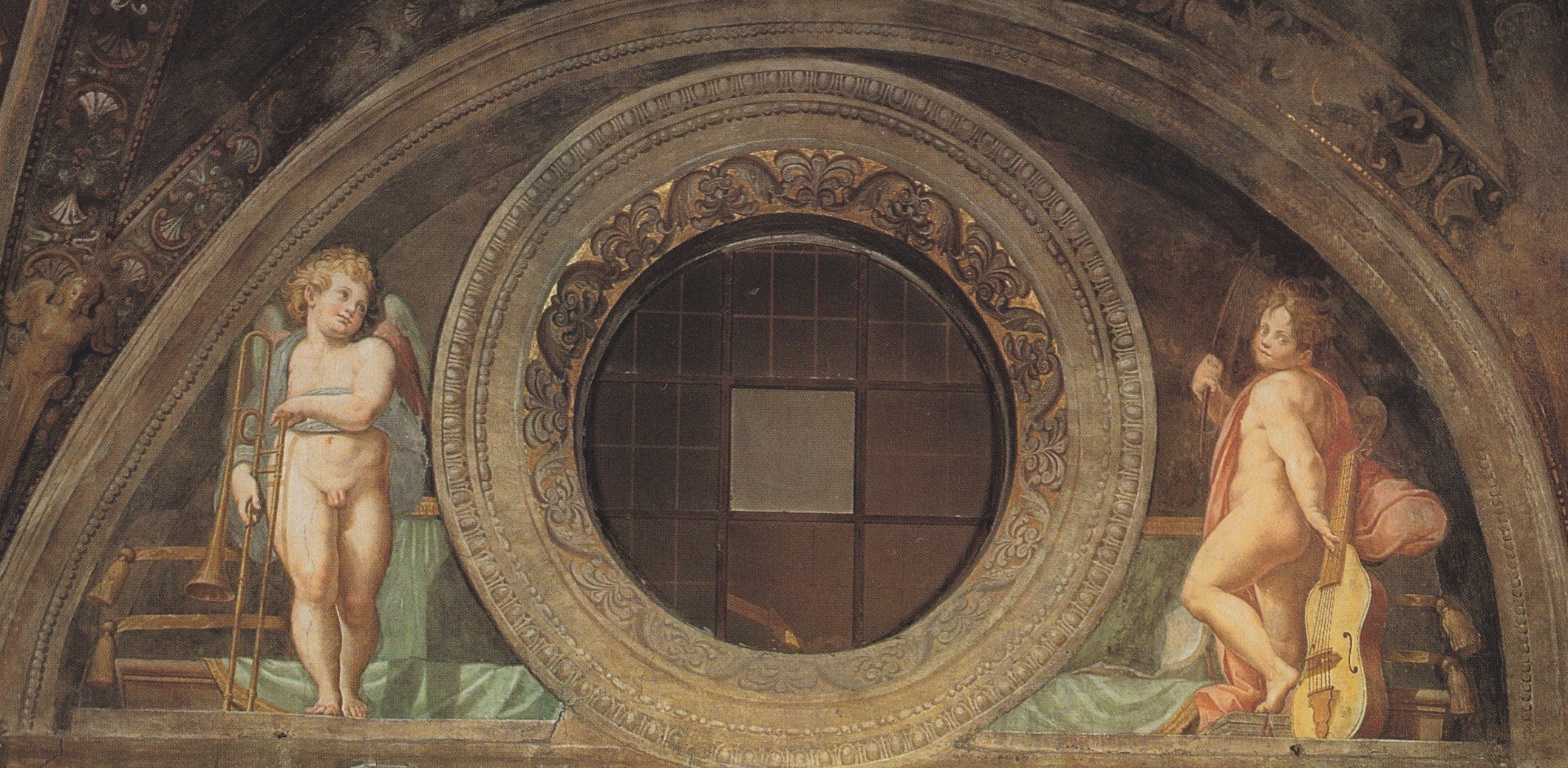
1566—Florence, Italy: Wedding festivities for Prince Francesco de’ Medici and Johanna of Austria include an allegorical procession, Genealogy of the Gods, in which one of the 9 muses “marche[s] in elegant fashion” with a trombone (Bowles, Musical Ensembles 54).
1566—Brussels, Belgium: Margaret of Parma employs trombonist Theodoro Ristel at her chapel (Niwa, Madama Margaret).
1566—Ferrara, Italy: Ferdinand of Bavaria visits Ferrara and is honored by cornetts and trombones playing in the adjoining room (Reese 547).
1566—Siena, Italy: Young trombonist Tiberio di Girolamo Rivolti is jailed for having written certain scandalous words on the wall of the employees’ dining room and for having lied to fellow trombonist Giovanbattista di Bennardino. Tiberio goes on to become one of the leading Sienese trombonists (D’Accone, Civic Muse 581).
1567—Piero da Ricasoli, discussing instrumental virtuosi in Cosimo Bartoli’s Ragionamenti accademici, includes the following trombonists: Bartolomeo, Zaccheria da Bologna, and Lorenzo da Lucca (who “has in his playing a certain grace and lightness, with a manner so pleasing as to make me dumbstruck, beyond which he even handles both a viola and a lute with a marvellous grace”) (Tim Carter, Music in Late 164).
1567—Florence, Italy: Alessandro Striggio writes 6 intermedi for performance with Lotto del Mazzo’s I Fabii. The intermedii make extensive use of trombone. For example, the second intermedio features music sung by a bass and soprano voice, accompanied behind the scenes by 4 trombones, 3 harpsichords, 3 lutes, 4 viols, 2 recorders, and a transverse flute. The third intermedio makes use of trombone in a pastoral scene. The fifth intermedio features 12 female voices representing heaven in a 5-part madrigal, supported by 2 trombones, 4 viols, 1 lyra, 1 lute, and 1 muted cornett, while earth is represented by 2 trombones and 3 flutes. The sixth intermedio features a 6-part canzona sung by 12 voices and accompanied by 4 trombones, 2 cornetts, 6 lutes, 1 bass viol, 1 soprano viol, 2 recorders, and 1 transverse flute (Weaver, Sixteenth-Century Instrumentation).
1567—Florence, Italy: Three weeks of festivities celebrating the birth of a Leonora to Grand Duke Francesco de’ Medici and Princess Johanna of Austria begin with a hunt, followed by an evening pageant of hunters; a contemporary account says, “Afterwards they had sixteen musicians, some of whom sang and others who played [instruments]….The song was written on order of the Illustrious Duke by a young gentleman from our city, in the manner of our forefathers, accustomed to composing dance music….[There were] huge and amazing triumph-wagons, with all sorts of inventions….There were sixteen musicians, as I’ve said, divided as follows: the music was in six parts, composed by that excellent Francesco Corteccia: that is, all the voices doubled by the tenor out-of-doors, and accompanied and doubled by two trombones, two crumhorns and two cornetts, all of which together produced a sweet harmony” (Bowles, Musical Ensembles 57). Later there is another dramatic procession: “On the next Thursday, the twelfth of the present [month], Signor Triano Boba…continuing the entertainment with excellent musicians, ordered an outdoor masquerade [featuring] a carriage of widows, which proceeded first to His Highness and then to the noblest houses in the city, entering them to sing and play the song [Hor che vedove, e sole] written by Domenico Mellini to music composed by that excellent Alessandro Striggio, in six parts, and accompanied by two viols, two trombones, two flutes and two lutes, which produced a harmonious and most sweet harmony (Bowles, Musical Ensembles 57). The following Sunday the cardinal hosts a festival in front of the old Medici palace that includes, according to a contemporary account, “excellent musicians, some vocal and some with instruments, singing and playing the following canzona [Per questi duo guerrier famosi] with words by Scipione dale Palle, an excellent Sienese musician, and music by Stefano Rossetto, for six [voices] accompanied by two trombones, two lutes, a lira [viol], a gravecembalo, a cornett and a flute (Bowles, Music Ensembles 57). Another masquerade on the following Monday features a madrigal, Scorte dal chiaro lune, by Alessandro Striggio, “in four parts, accompanied by trombones and cornetts: that is, the first time with voices alone, unaccompanied; and the second time with instruments and voices together…the voices were doubled on [each] part; and between the singers and instrumentalists were a large number [of performers]” (Bowles, Music Ensembles 58). On the final day of the festivities, an allegorical pageant, The Triumph of Fortune, again features trombones; a contemporary account states: “[The pageant] was replete with musicians who sang and played the song [Donne poscia ch’a voi non fatte ancelle le grazie]. The [pageant-] ship symbolized the triumph of Fortune….[The song] was written by a young gentleman from Siena, with music by Steffano Rossetto, in six parts, accompanied by three trombones, two cornetts, a flute and a lira [da braccio]” (Bowles, Music Ensembles 58).
1567—Venice, Italy: Orlando Lassus visits Venice and engages a musician named Fileno Cornazzano as a trombone player (Lyndon-Jones, A Checklist).
1567—Venice, Italy: Piero da Ricasoli, discussing instrumental virtuosi in Cosimo Bartoli’s Ragionamenti accademici, names 3 trombonists: Bartolomeo, Zaccheria da Bologna, and Lorenzo da Lucca. Ricasoli comments specifically that Lorenzo da Lucca “has in his playing a certain grace and lightness [grazia et una leggiadria] with a manner so pleasing as to make me dumbstruck” (Haar, Cosimo Bartoli). This trombonist, Lorenzo da Lucca, is presumably the same trombonist who had performed with Benvenuto Cellini for the pope in 1524 (see above).
1568—Munich, Germany: During a banquet celebrating the marriage of Wilhelm V of Bavaria to Renata (Reneé) of Lorraine, trombone participates in numerous pieces: Musicians play Battaglia a 8 of Annibale Padovano on trombones and cornetts, then a 7-voice motet by Lassus with 5 cornetts and 2 trombones, followed by a madrigal by Alessandro Striggio for 6 bass trombones (one of which plays an octave lower than usual). During another course, 5 trombones and a cornett participate in works by organist Annibale Padovano and “other masters” (Haar, Munich 251, 253; Bowles, Musical Ensembles 60). At least 3 other banquet performances include trombone. One of them features, according to eyewitness Massimo Troiano, “the wind instruments, now with cornamuse, now with recorders, now with flutes, and now with trombones [tromboni] and cornetts” (Boydell, Crumhorn 295). In another banquet, “…here there played sweetly a harpsichord, a trombone [trombone], a recorder, a lute, a cornamusa, a mute cornett, a viola da Gamba, and a flute, which music certainly pleased me greatly” (Boydell, Crumhorn 295). During the “fruit course” of the final banquet of the celebrations, a 24-part work is performed that includes “Eight viole, eight viole da braccio, and eight different instruments, namely a curtal, a cornamusa, a mute cornett, an alto cornett, a large twisted cornett, a fiffaro, a dolzaina, and a large trombone [un Trombone, Grosso]” (Boydell, Crumhorn 296). The performance is followed by a vocal version of the same piece by the members of the ducal chapel (Haar, Munich 254). According to Reese, Alessandro Striggio’s 40-part motet, Ecce beatam lucen, is performed at the celebrations, utilizing a mixed consort of 8 trombones, 8 viols, 8 recorders, 2 choirs of 8 voices, a bass lute, and a harpsichord (Reese, 487).
1568—Mexico: Bernal Díaz writes that churches have acquired a plentiful supply of flutes, oboes, trombones, and lutes (Stevenson, Music in Mexico 92).
1568—Venice, Italy: The first regular cornettist is hired at St. Mark’s Cathedral, along with his 2 brothers, both trombonists (Dickey, The Cornett 58).
1568—Venice, Italy: An ensemble consisting of 6 cornetts, cornamuse, fifero, and 3 trombones plays “the concertos in the organ loft on the festival day” at St. Mark’s (Broder).
1568—Florence, Italy: In a series of intermedii 2 trombones, 2 mute cornetts, and bass crumhorn accompany 5 voices representing Calumny, Ignorance, and Fear (Boydell, Crumhorn 55).
1568—Florence, Italy: Wedding celebrations for the marriage of Virginia de’ Medici to Cesare d’Este include intermedii for the comedy L’Amico fide, by Giovanni Bardi. Music for the intermedii is by Bardi and Alessandro Striggio. In the 2nd intermedio, a “horrible old man with a scraggly beard, naked and covered with flames,” sings to the accompaniment of trombones and bass viols. In the 3rd intermedio, birds signaling the arrival of spring are accompanied by lutes, harps, muted cornets, trombones, and dulcians. In the 4th intermedio, an angry Neptune sings to the accompaniment of trombones, lutes, harps, and transverse flutes (Nagler, Theatre Festivals of the Medici 58-65).
1568—An engraving by Jost Amman (1539-1591) called A Bridge for Adultery Built by King Arthur includes a trombonist performing outdoors with a quartet of 3 winds and a viol (see below image; public domain) (Buchner 26; Naylor 35).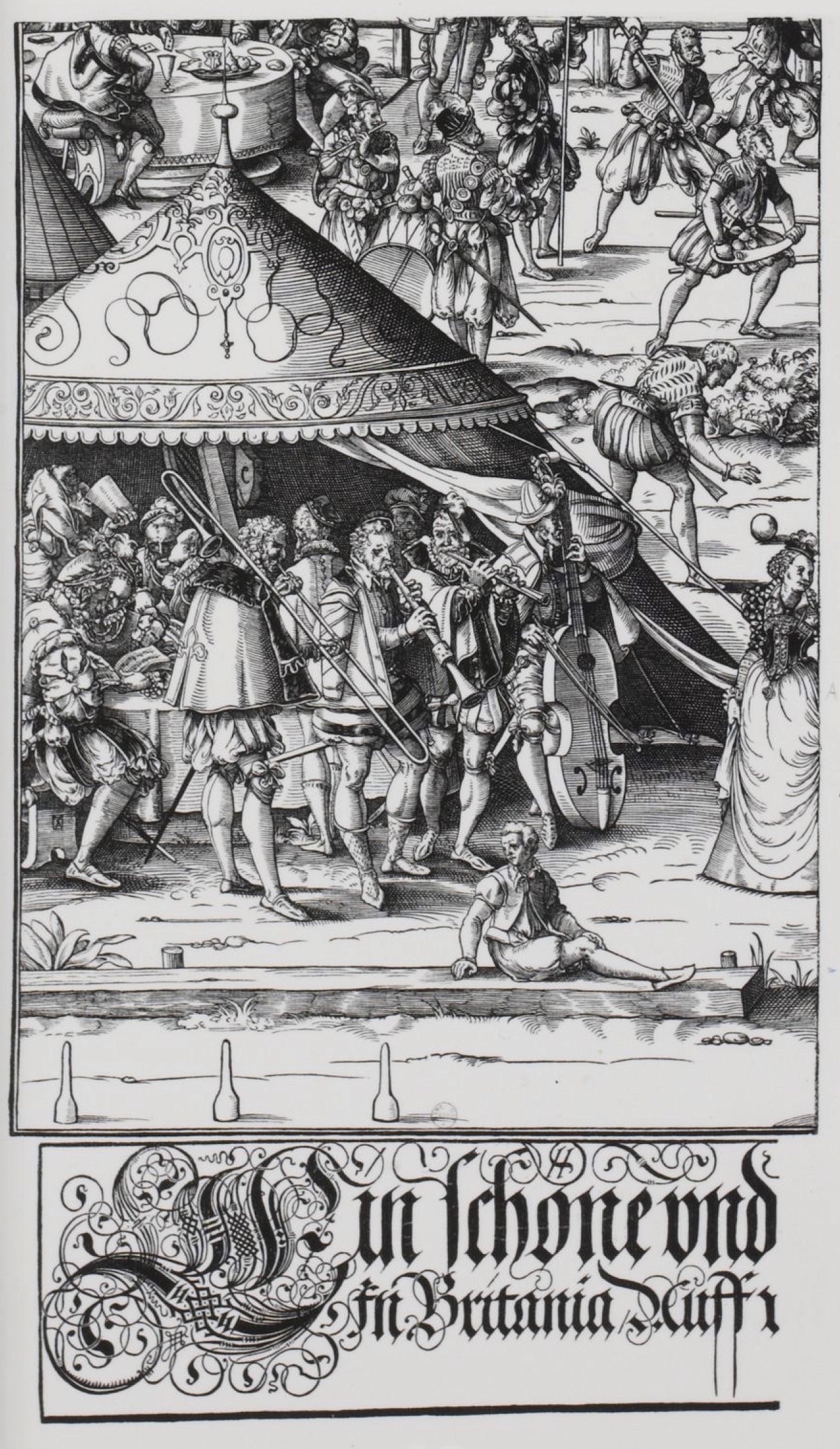 1569—Paris, France: A man by the name of François Robillard signs a contract with a company of hatters to provide 10 musicians for their celebrations on the feast of St. Michael. Apparently the activities are to take place outdoors, as the musicians are to play cornetts and violins if it does not rain, flutes and trombones if it does (Bate 228).
1569—Paris, France: A man by the name of François Robillard signs a contract with a company of hatters to provide 10 musicians for their celebrations on the feast of St. Michael. Apparently the activities are to take place outdoors, as the musicians are to play cornetts and violins if it does not rain, flutes and trombones if it does (Bate 228).
1569—Orlando Lasso’s “Motette,” which is performed by 5 cornetts and 2 trombones, is contained in M. Troiano, Dialoghi, Venice (Whitwell, Catalog Before 1500 79).
1569—Bremen, Germany: Three musicians apply for positions as trumpeters and Spielleute for the city of Bremen. They indicate they are capable of performing to the council’s satisfaction “with all kinds of these or other commonly used musical instruments, as with cornett and trombones [Bassunen], trumpets, crumhorns, viols, flutes and recorders, and others of a similar type” (Meyer, The Crumhorn, 137).
c. 1570—Germany: An engraving by Franz Ignaz Brun from the Nine Muses series features an angel-musician playing trombone (see first image below; public domain) (British Museum). A second image, The Muse Calliope, a plaquette after the style of Brun, is essentially a mirror image of Brun’s (without the wings). It comes from a set of several plaquettes depicting muses playing various musical instruments (see second image below; public domain) (Marle 273, fig. 306). Yet another image, also representing Polyhymnia, is also nearly a mirror image of the Brun, and may be either a preparatory sketch or a copy of one of the images (see third image below; public domain) (Louvre, INV 18676.6).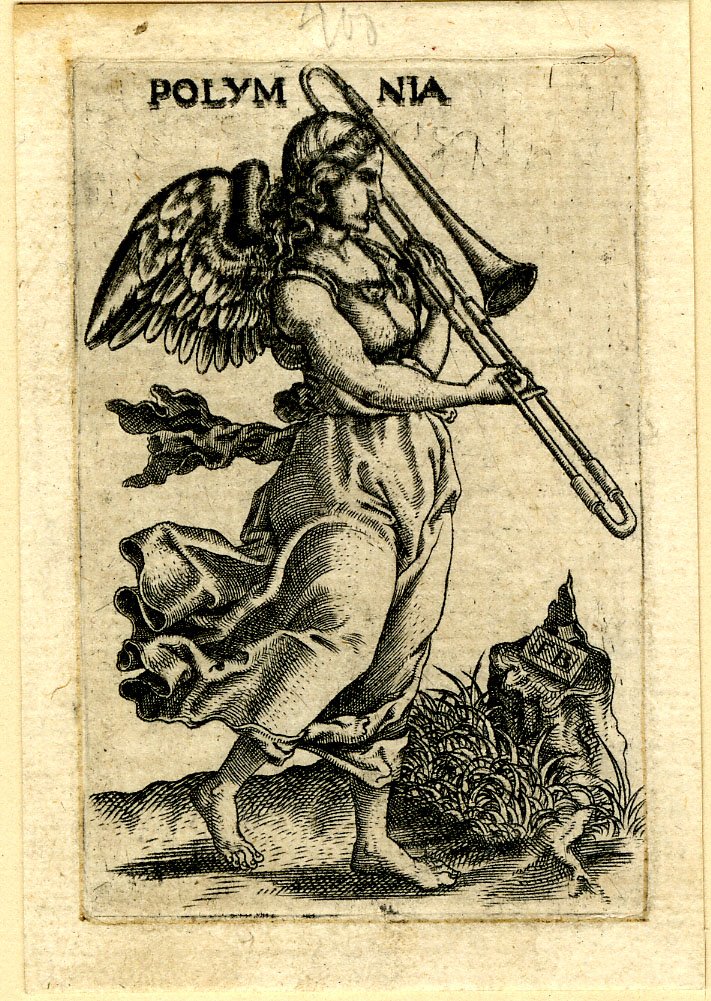


1570—Seville, Spain: Seville’s Archbishop Don Gaspar de Zuñiga y Avellaneda is chosen to solemnize the nuptials of Philip II with Princess Anne, daughter of Emperor Maximilian. He obtains this honor by promising the most impressive retinue that the cathedral can create. At the ceremony, the king makes his entry through an archway upon which are stationed numerous instrumentalists, including 6 shawm and trombone players wearing blue robes and hats bordered with gold (Stevenson, Spanish 157).
1570—Siena, Italy: Trombonist Tiberio di Girolamo Rivolti, a prominent performer and member of the Palace wind band, is imprisoned because of making certain disparaging remarks about several gentlemen. He spends a week in prison, without salary (D’Accone, Civic Muse 582).
1570—England: The roster for the King’s Musick includes 7 sackbuts, a number probably typical for most of Queen Elizabeth’s reign (Woodfill 184).
1570—England: A list of the private expenditures of Queen Elizabeth includes “One greate sackbut provided for the Queens use.” Based on this document, which otherwise lists only the queen’s private items such as bedding and clothing, historian Trevor Herbert has raised the remote possibility that the queen may have been an amateur trombone player (Herbert, Trombone 79).
1570—Waiting for the Princely Guests, an image depicting wind musicians in a balcony atop a triumphal arch, shows trombone, trumpets, bombard, and positive organ, as they prepare to play for a prince’s arrival (see below image; public domain) (Carter, Renaissance 278; Nuremberg, Stadtbibliothek). The rear-facing or over-the-shoulder trombone is one of several examples from pre-1800, including 1503-1529, c. 1504, 1570, 1578, c. 1615, c. 1660-1670, 1689, 1732, and c. 1795. 
1571—London, England: The town waits, which include sackbuts, are specifically instructed to play from late March through September “upon their instruments upon the turret at the Royal Exchange every Sunday and holiday toward the evening.” One historian calls these performances London’s first regularly scheduled public concerts (Atlas, Aragonese 686).
1571—Ulm, Germany: A civic council ordinance mentions the civic wind band playing trombones and cornetts in the Munster Cathedral (Whitwell, Renaissance 240).
1571—Ferrara, Italy: One of the performances celebrating the arrival of Rudolph of Austria features an ensemble consisting of cornetts, trombones, dolzaine, shawms, viols, ribechini, lutes, citare, harps, and harpsichords (Broder).
1571—Seville, Spain: 3 trombonists are among the 6 cathedral instrumentalists who have just returned from Jaén with the cadaver of the cardinal. They are given special payment for their services (Stevenson, Spanish 158). The full makeup of the cathedral band is 3 shawms and 3 trombones (Kreitner, Minstrels in Spanish Churches).
1571-1596—Mexico: Gerónimo de Mendieta writes the following in his Historia Eclesiastica Indiana: “Nowhere in all of Christendom are there so many recorders, shawms, trombones (sacabuches), orlas, trumpets and drums as in the Kingdom of New Spain” (Boydell, Crumhorn 128).
1572—Venice, Italy: Tomás Luis de Victoria, O vos omnes (transposed alla quarta bassa):
1572—Liverpool, England: The city buys an additional sackbut for their town waits (Woodfill 85).
1572—Norwich, England: The city owns 4 trombones (sacquebuttes) for their town waits (Whitwell, Renaissance 158).
1573—Kassel, Germany: An inventory for the Hofkapelle lists “1 Quart Pusaun with its crooks [Bogen] and mouthpieces,” “2 Second Posaun with their appurtenances; the crooks of one are wanting, so that Hans Heugel has delivered one which he has used before and lengthened,” and “3 small Pusaun with their appurtenances; one less its crooks” (Baines, Two Cassel Inventories).
1574—Dresden, Germany: A procession for the carnival season is held at the court of Elector August of Saxony. It includes an ensemble of 8 musicians playing cornetts, shawms, and trombones; another ensemble of 8 playing lute, fiddle, flute, trombone, cornett, mandora, and shawm; and another group playing fiddles, cornetts, and trombone (Bowles, Musical Ensembles 73). Graphic representations of the event (see below 3 images) show the first and third groups in lavish robes and hats, the second with rough leggings, no shirts, and leaves in their hair (representing “wild men and women”) (Bowles, Musical Ensembles 77, 79, 80; public domain images).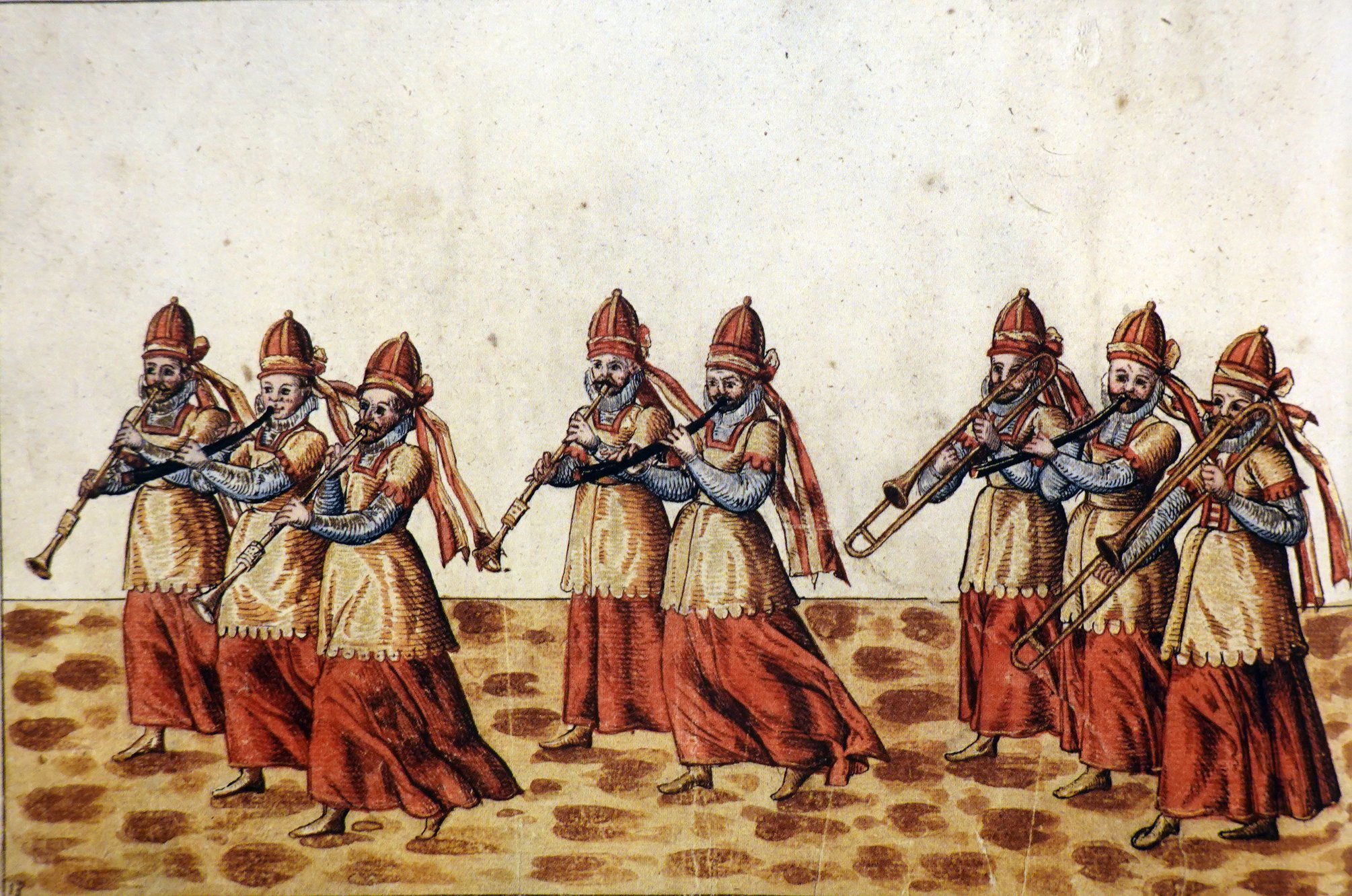
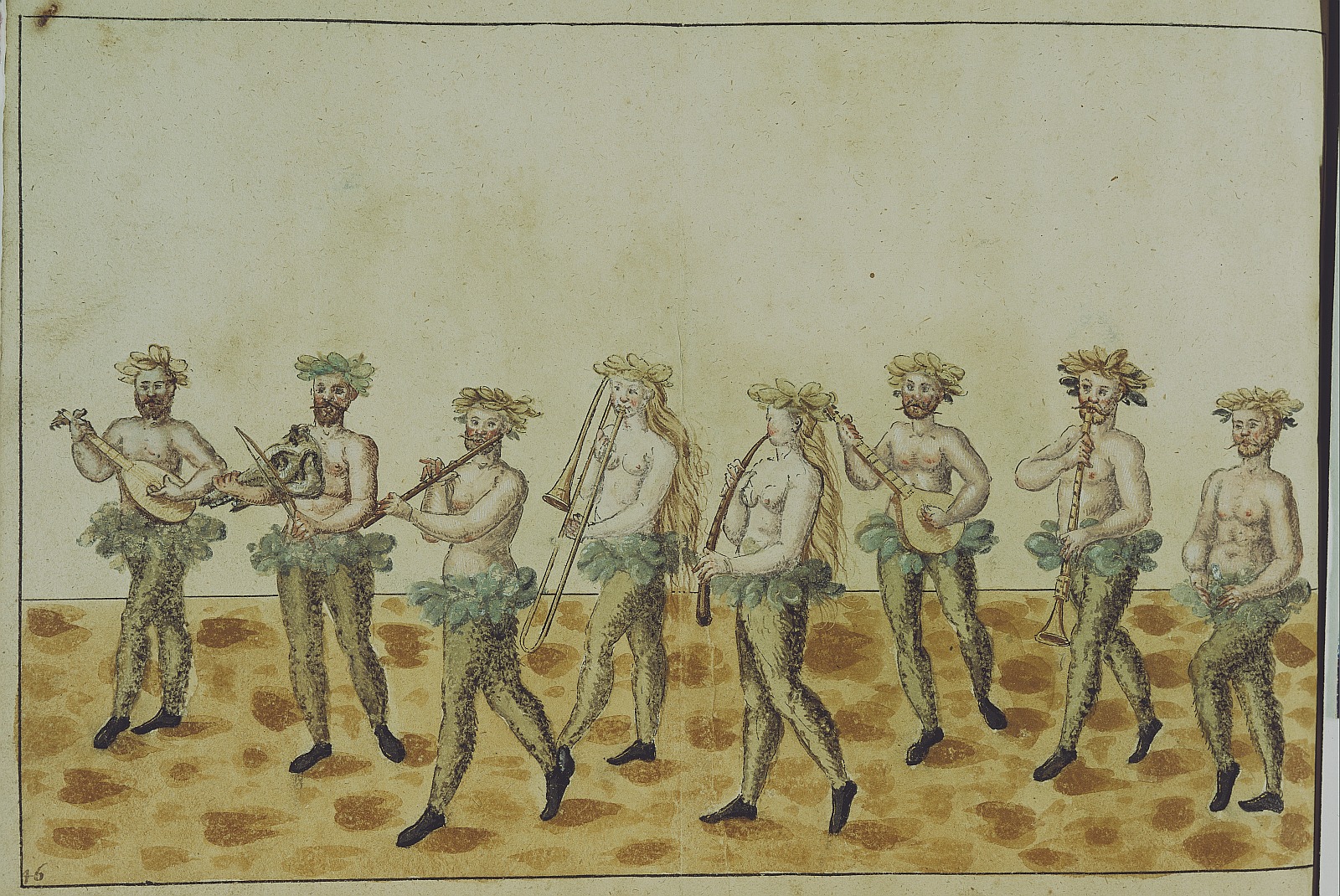
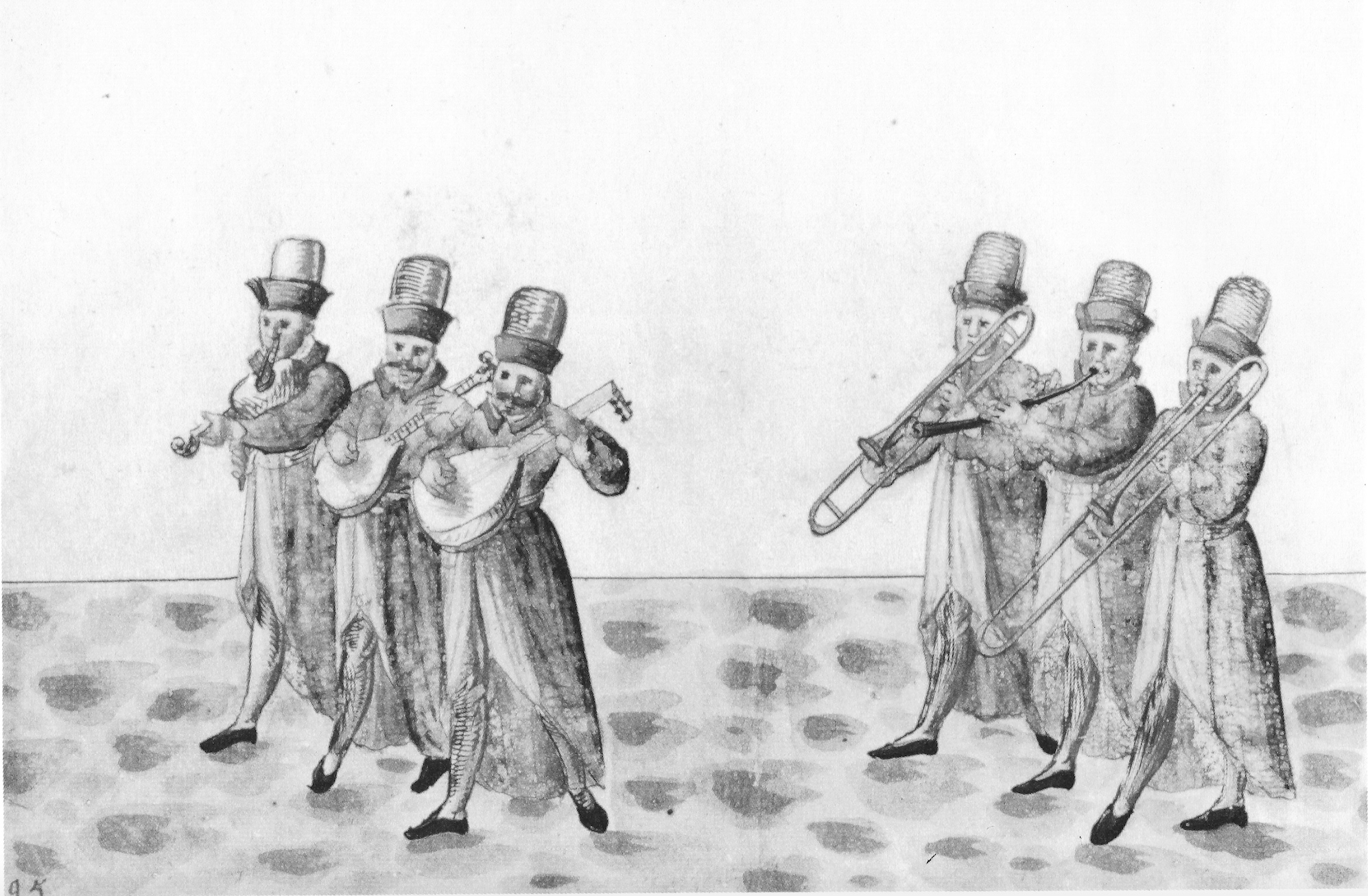
1574—Siena, Italy: Trombonist Tiberio di Girolamo Rivolti begins service at the cathedral chapel, where he continues until 1580, later resuming the post from 1587 to 1588 (D’Accone, Civic Muse 596).
1574—Musicians dressed as shepherds perform in a mascherata in honor of Don Juan of Austria. The remarkably large and varied ensemble consists of trumpets, cornett, trombone, cornamusa, flute, dolzaina, recorder, diana, spinet, viole da gamba, violin, lute, lira, cittern, piva, dolcemele, contralto di viola, triangle, small drum and fife, harp, buttafoco, sordina e mantica, theorbo, and 4 viole da braccio (Broder).
1574—Rome, Italy: A letter written from Tivoli by Ernst of Bavaria states, “The Romans get their trombones [pusaunen], recorders, and crumhorns almost exclusively from Nuremberg” (Boydell, Crumhorn 132).
1574—Milan, Italy: A mascherata held in honor of Duke Johann of Austria includes a pastoral scene in which numerous instruments are used: “5 trombetti…cornetto, trombone, cornamusa, fifre, dolzana, flauto, diana, spinetta, viola di gamba, violino, liuto, lira, cetera, piva, doulcemele, contralto di viola, triangolo, tamborino e zufolo, arpa, buttafoco, sordina e mantica, tiorba, quattro viole da braccio” (Boydell, Crumhorn 296).
c. 1575—A portrait of St. Cecilia playing organ, accompanied by musician angels, includes an angel playing trombone (see below image, public domain, special thanks to Tassos Dimitriadis) (Sónia Duarte, “Saint Cecilia in Baroque Painting in Portugal” in Meeting of Research in Music, Arts and Design. First Online 29 June 2022).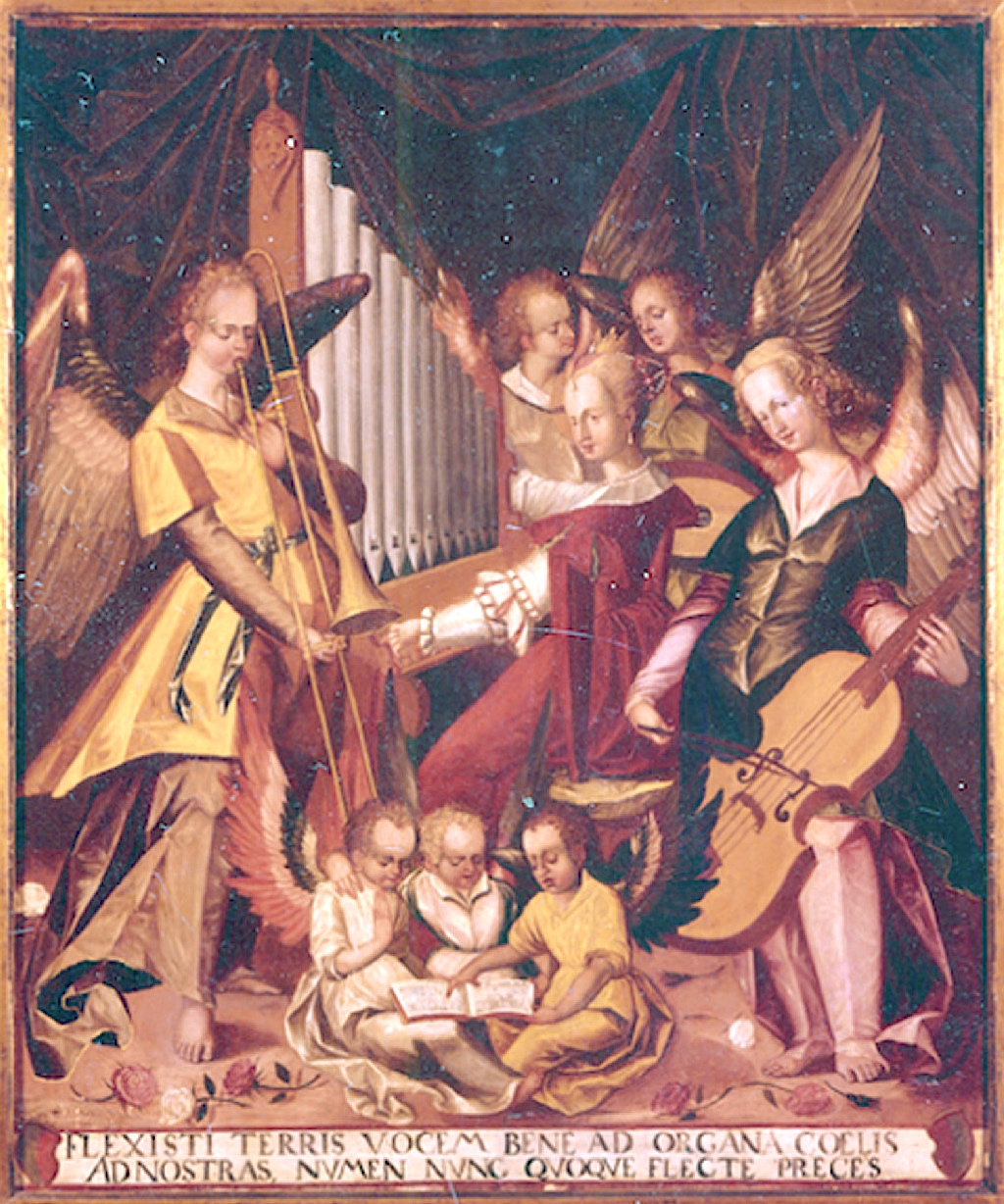
1575—Mexico City, Mexico: The cathedral orchestra includes trombone (Stevenson, Mexico City Cathedral Music).
1575—Quito, Ecuador: A report about music in Ecuador makes the following claim about Flemish Franciscan Josse (“Jodoco”) de Rycke of Malines, who had established a convent 40 years earlier in 1535: “In addition to teaching the Indians [native Ecuadorans] how to read and write, Fray Jodoco taught them to play various keyboard and string instruments, also sackbuts and shawms, flutes, trumpets, and cornetts, and the science of mensural music and plainchant” (Stevenson, Music in Quito).
1575—Worcester, England: Queen Elizabeth visits Worcester Cathedral twice. Both times, cornetts and sackbuts are used in the services. Records detail the Sunday service as “a great and solemn noise of singing of service in the quire both by note and also playing with cornetts and sackbuts” (Woodfill 149; Parrott, Grett and Solompne Singing).
1575—Munich, Germany: Giovanni Gabrieli, in his formative years, resides at the Bavarian court in Munich, where there are 7 trombonists and cornettists on staff (Arnold Gabrieli Renaissance 9).
1575—Stuttgart, Germany: According to a poetic account of the marriage festival of Duke Ludwig von Württemberg and Dorothea Ursula, “There went a long procession / Of princes, counts and lords, / And there was a throng of nobles / On all sides in the hall, / Who approached here and there, / To view the princely dance. / The women also came there as well / In a long line, two-by-two….Then a sound was heard above the throng. / Trumpets and trombones blew, / And the kettledrums boomed mightily, / This (as I have heard truly tell) / There was no place in the entire city / Where [the music] could not be clearly heard” (Bowles, Musical Ensembles 61). Trombone is also mentioned in descriptions of other wedding festivities: “When [the noble guests] reached the castle / then things really got started… / In every corridor, at every corner / The instruments were heard / with music sweet as angels, / With charming sound and tone, / In artful harmony all. / And rich-sounding ensemble / of trombones [Pusaunen], loud cornetts…” During the wedding ceremony itself, “Therein the choir was heard / Singing freely with eight voices… / Thus the nuptial song resounded / With trombones and singing…” (Bowles, Musical Ensembles 103; Boydell, Crumhorn 328).
c. 1575—Germany: Jonas Silber, a German goldsmith, includes a trombone in his medallion, Apollo and the Muses on Parnassus (see below image; public domain) (source: Germanischen Nationalmuseum Nürnberg).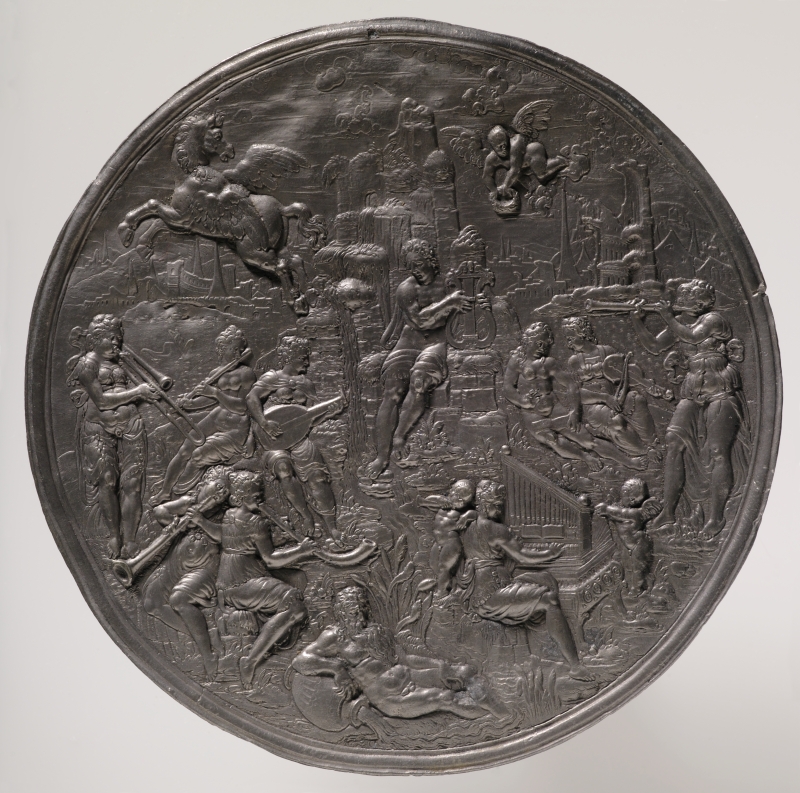
c. 1575—Italy: Jan van der Straet (sometimes know as Stradanus), probably working in Italy, includes a trombone hanging on a wall in his La Musique (see below image; public domain) (source: École des Beaux-Arts).
c. 1575—Scene biblique avec banquet, by an unknown artist, depicts a group of musicians performing from a balcony or raised platform during a banquet. The instrumentation appears to be 3 shawms and a trombone. Based on other depictions of trombones in biblical feasts (see c. 1545 and c. 1580), and based on the group’s instrumentation, the date of the work is probably mid- to late-16th century (see detail and full image below; public domain) (French National Library).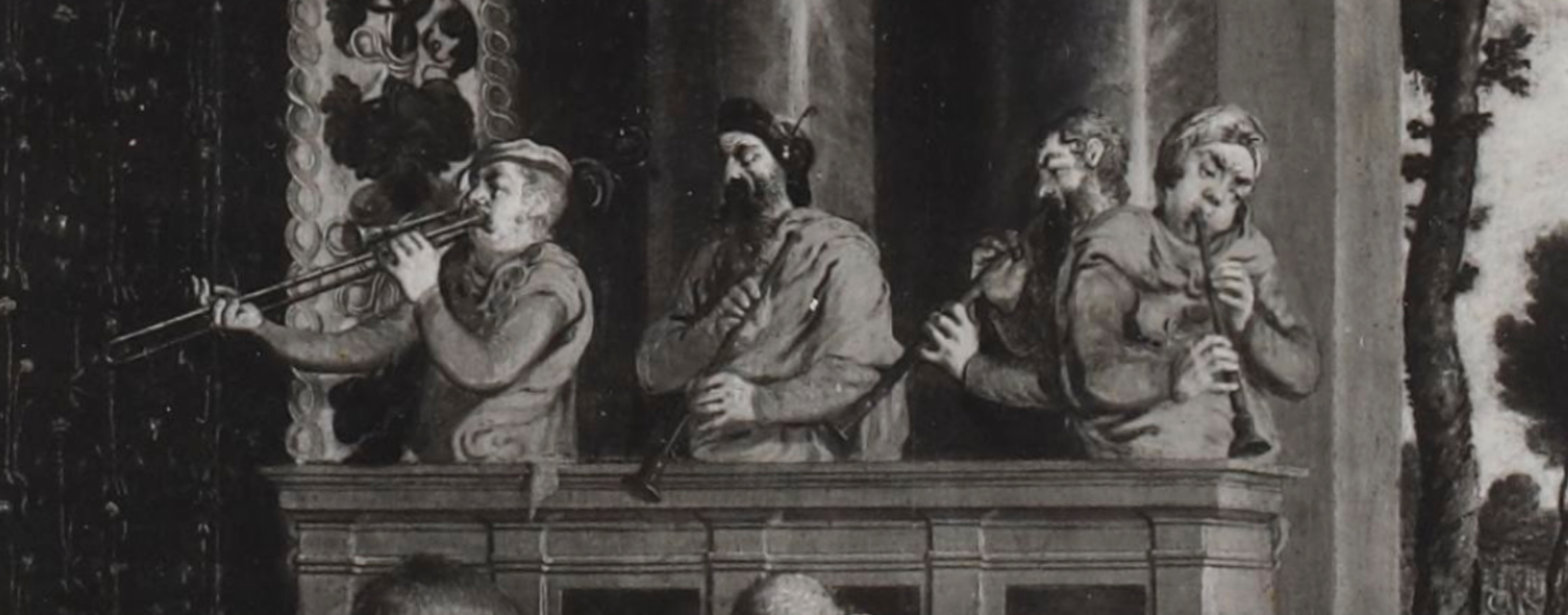
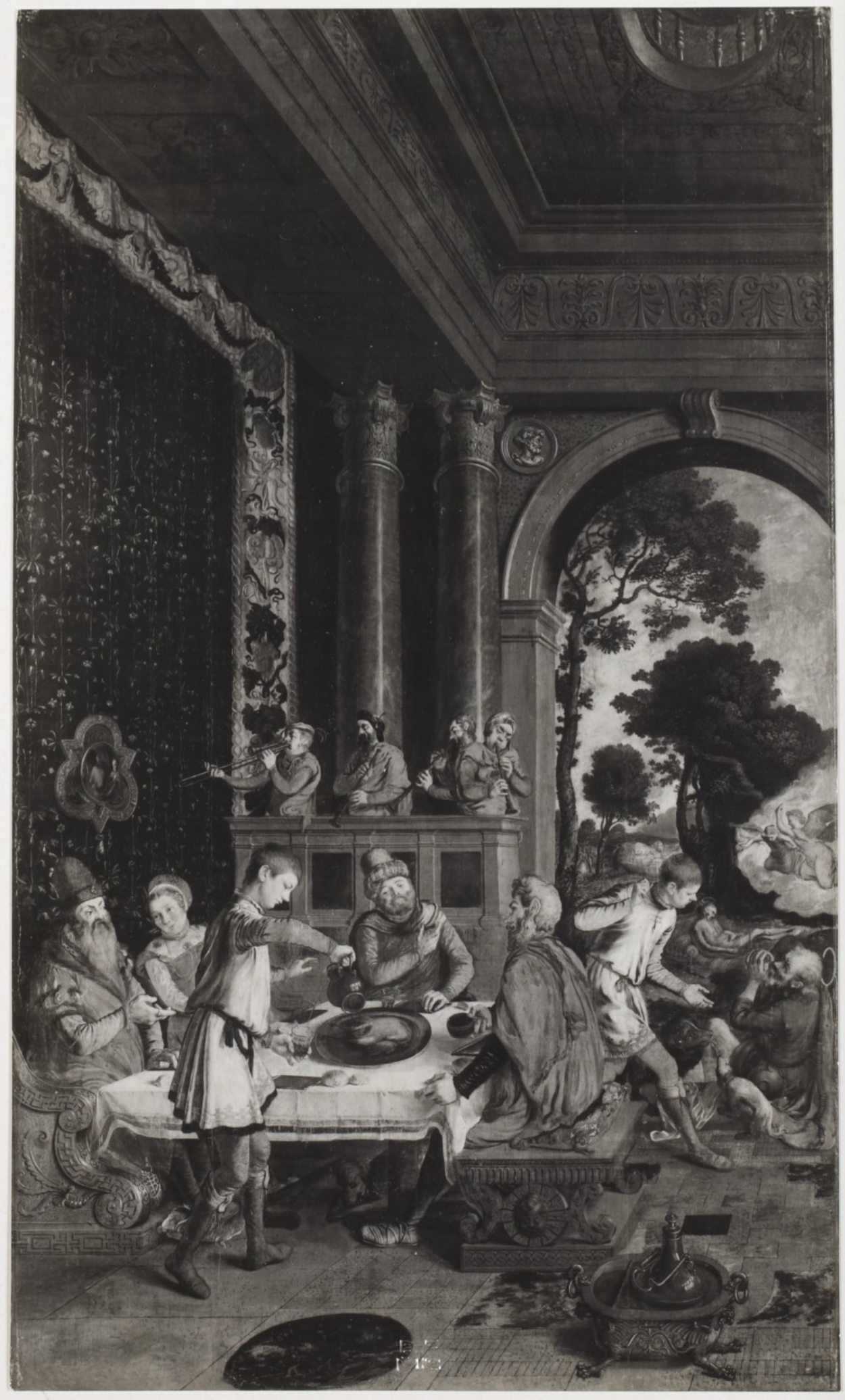
1576—Bologna, Italy: Isabella Trombetta brings her trombone with her to the convent Santi Gervasio e Protasio (Monson, Disembodied 264).
1576—Munich, Germany: The Bavarian court purchases 2 trombones from Nuremberg (Whitwell, Renaissance 102).
1576—Italy: The Roman Confraternity of San Rocco takes with them on a pilgrimage 2 boy sopranos, 2 contraltos, a tenor, 2 basses, and a trombone player (O’Regan, Palestrina).
1576—Nuremberg, Germany: A tenor trombone made by Anton Schnitzer with the date 1576 engraved on the bell is probably the earliest dated instrument by that maker, and the third-oldest signed trombone. The instrument is later discovered inside an organ case in a church in Altötting, Germany in 1903 (Raquet).
1576—Nuremberg, Germany: Records show a short double trombone, probably a double-slide trombone, belonging to Anton Schnitzer (Baines, Brass 117).
1576—Lima, Peru: Native Indians of Surco are listed as shawm and trombone players (Bermúdez).
1576-78—Rome, Italy: An English Jesuit describes music of the church: “A man may goe to so many Churches in one day…with such voices, such instruments, al ful of gravitie and majestie, al moving to devotion and ravishing a mans hart to the meditation of melodie of Angels and Saintes in heaven….Among the quyre, Cornet or Sagbut, or such like above the voices” (Atlas, Aragonese 615).
1577—Breslau, Poland: An engraving by Johann Twenger features a wind band performing for the arrival of Emperor Rudolf II at Breslau. The ensemble, which is featured playing in a high tower at the entrance to the palace, is comprised of 2 trombones, 2 shawms, cornett, and bass curtal (see below detail; public domain) (Nuremberg, Germanisches Nationalmuseum; Lindell 259; Kmetz 259-60).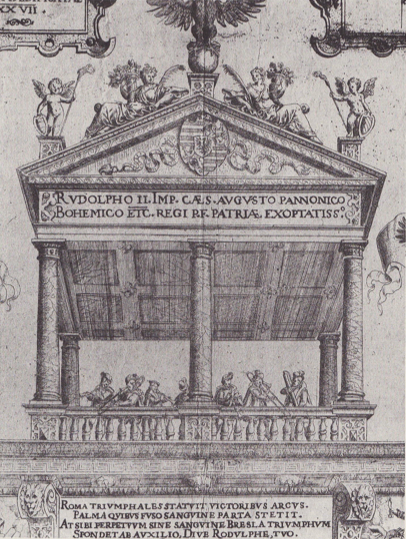
1577—England: Records for the household of Queen Elizabeth include “Livery for Marco Anthonio Bassanie, one of the shagbutts” (De Lafontaine 27).
1577—Pallanza, Italy: Aurelio Luini and Carl Urbino complete a fresco in the church, Madonna di Campagna, that includes an angel-trombonist (see below detail, click to expand; public domain).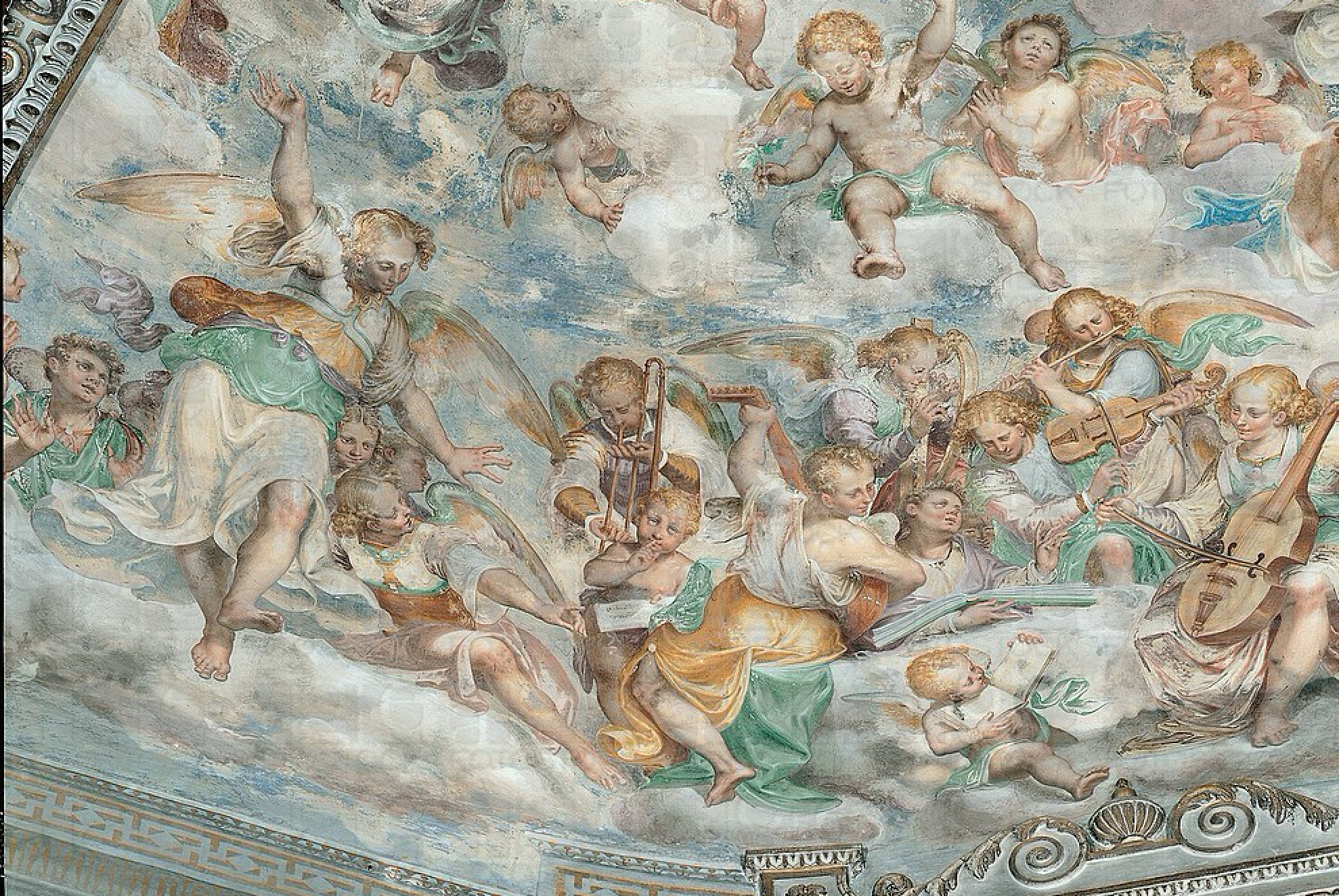
1578—Siena, Italy: Members of the Palace wind band, including a trombonist, receive permission to travel to Lucca for the annual feast of the Holy Cross (D’Accone, Civic Muse 591).
1578—Siena, Italy: Trombonist Tiberio Rivolti receives permission from authorities in Siena, Italy for a leave of absence to enter the service of Habsburg Emperor Rudolph. His brother replaces him in Siena (D’Accone, Civic Muse 595).
1578—Mantua, Italy: Salary records document the use of trombones at the court (Sanders, Gonzaga 58).
1578—Antwerp, Belgium: A set of masses by George de La Hele includes an image–an initial D in front of a group of cherub musicians–that features a rear-facing trombone being played by a cherub (also rear-facing) (see below image; public domain; Wangermée vol. 1 167).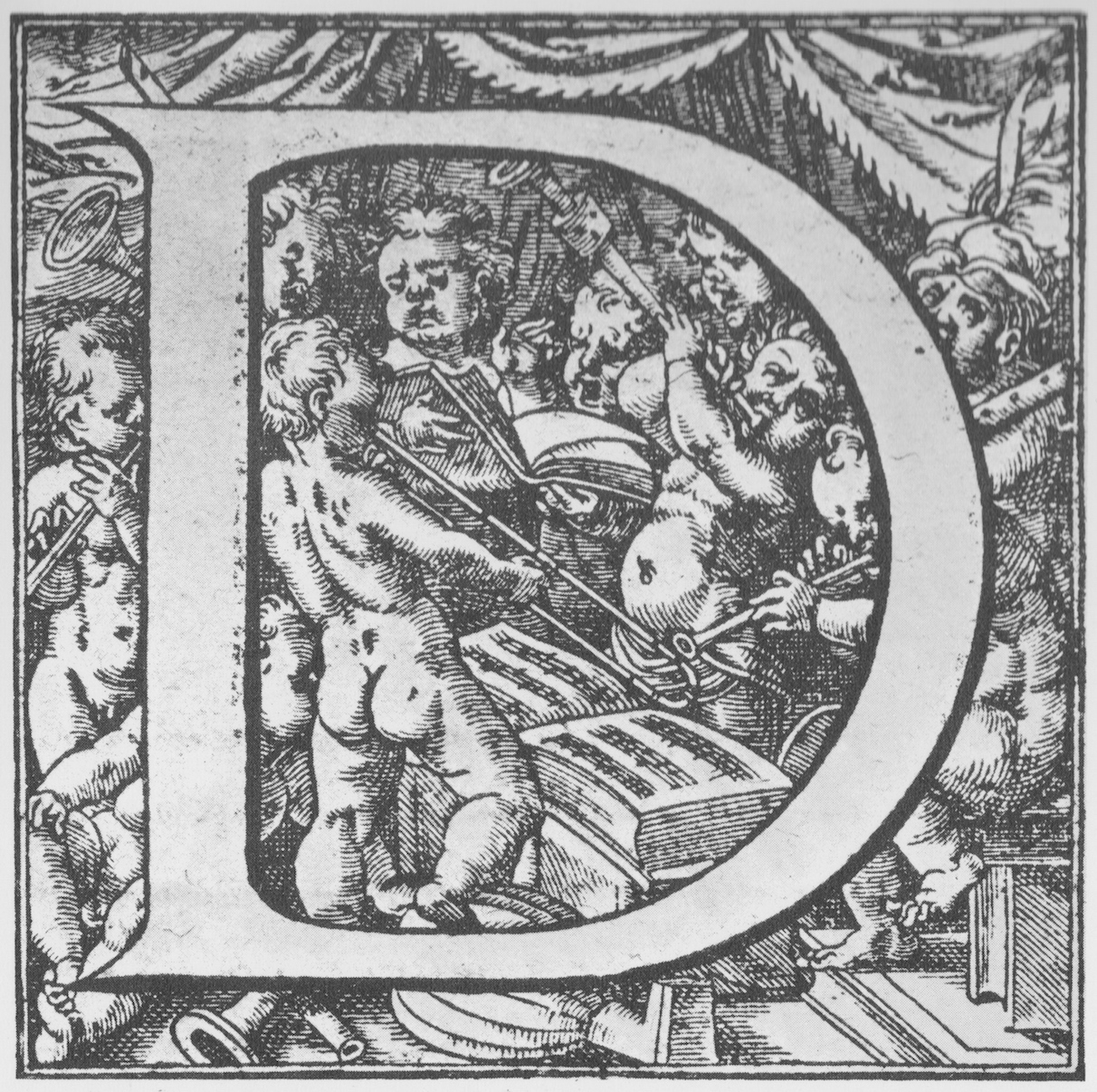
1578—Lugano, Switzerland: After this date, decoration of cherubs in the Lugano Cathedral includes a cherub playing trombone (see below image; public domain).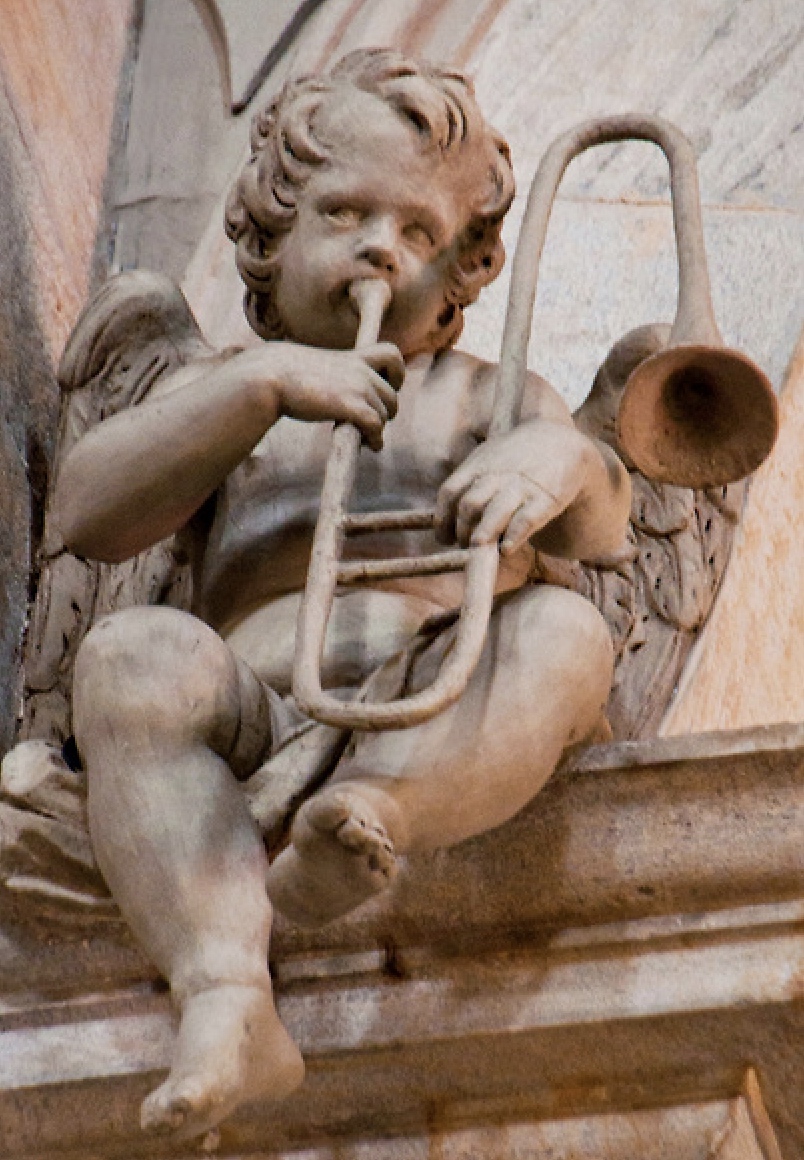
1579—Nuremberg, Germany: One of the earliest extant trombones is manufactured by Anton Schnitzer (Carse, Musical 252).
1579—Florence, Italy: 4 trombones participate in a performance by a large mixed consort: “On the preceding evening there was a concert in honor of the Venetian noblemen who had come to Florence with the father of Grand Duchess Bianca, Bartolomeo Cappello, and other relatives of hers. Twelve harpsichords [clavicordi], an organ, four trombones, two cornetts, thirty viols, a violin, a piffaro, a double-bass, and twelve lutes took part in the concert and made a lovely sound. The words, in praise of the Grand duchess, were set to music by Signor Striggio” (Newcomb 33).
1579—Spain: A trombonist by the name of Gascón is employed at the Toledo Cathedral (Noone, Toledo Cathedral).
c. 1580—Ferrara, Italy: Santa Cecilia is painted by Sebastiano Filippi (also called Bastianino) for Santa Maria in Vado. The painting, now located in Pinacoteca Nazionale, Ferrara, includes a trombone at the feet of St. Cecilia (see below image; public domain) (Pinacoteca Nazionale, Ferrara).
c. 1580—Innsbruck, Austria: An anonymous painting etitled Gastmahl des Herodes depicts a trio of instrumentalists that includes trombone, performing under a porchlike structure in the background (see detail and full image below; public domain) (Salmen, Bilder 36; Innsbruck, Tiroler Landesmuseum Ferdinandeum). The painting is probably a copy of an image from 1516 (thus the date on the lower-middle of the painting itself).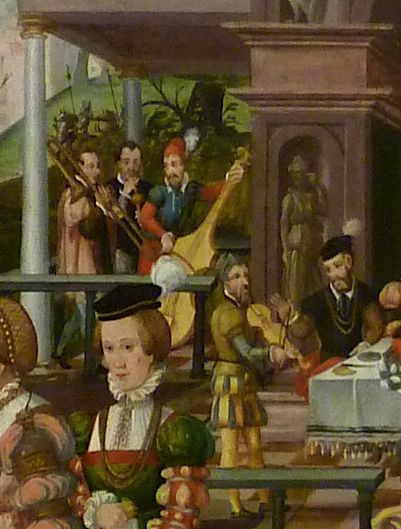

c. 1580—Italy: Alessandro Striggio (c. 1540-1592) writes Ecco ch’io lass’il core a 6, which is scored for 3 trombones, 2 cornetts, and Pumart (Collver 70).
1580—England: Upon the death of Henry Fitzalan, Earl of Arundel, who has retained both household choir and instrumentalists, owns 126 instruments, including 4 sackbuts (Bray 270).
1580—France: The court wind band of Henry III, under its “usual” name of “hautbois, sacquebutes, cornets a bouquin,” consists of 12 players (Whitwell, Renaissance 86).
1580—Passage in a letter from Giovanni de’ Bardi to Giulio Caccini says, “Wind instruments, as more nearly imitating the human voice, are given preference over the others by Aristotle in his Problems….We shall simply say that among the wind instruments there are some for playing compositions that are low pitched and somnolent—these are the trombone, others opt for playing those that are high-pitched and lively, such as the cornetti…” (Bardi 106).
1580—Siena, Italy: Members of the wind band, including a trombonist, perform at a non-official function without permission. They are subsequently charged by the priors (city rulers) and ordered to be incarcerated for 2 days, along with losing their meal privileges for 6 days. Their sentence is later lowered to 1 day of incarceration (D’Accone, Civic Muse 589).
1580—Innsbruck, Austria: A procession to a tournament that is part of marriage celebrations of Johann Lipsteinsky von Kolowrat and Katharina von Boymont und Pairsberg includes a trio of dulzian and 2 trombones (see below image; public domain) (Bowles, Musical Ensembles 85, 89).
1580—Munich, Germany: A plan for a procession written by the court chancellor, Müller, mentions “where the pipe and tabour, dulcin, triangle…Quintern and trombones [Pusaunen] are also made use of as they used to be in the days of Duke Albrecht” (Boydell, Crumhorn 397).
1581—Nuremberg, Germany: A trumpet made by Anton Schnitzer includes, on the bell, an engraving of a trombone player. The player appears to be a woman, probably a symbolic depiction of a muse (notice also the classical columns on either side of the trombonist) (see below detail; special thanks to Richard Lyman).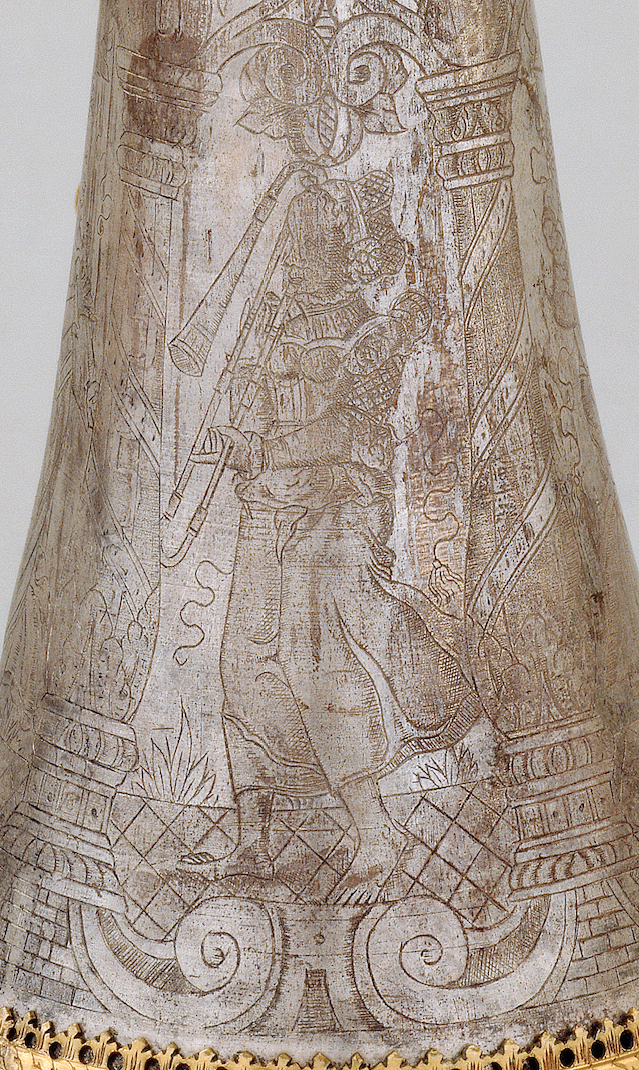
1581—London, England: The city buys 2 additional sackbuts for the town waits (Woodfill 248).
1581—France: Music for the Ballet Comique de la Reyne, written for the marriage of the sister of the Queen of France, contains an overture, now lost, that calls for “hautboyes, cornets, saquebuttes and other soft instruments” (Herbert, Trombone 100; Westrup, Monteverdi and the Orchestra).
1581—Rome: The Spanish Archconfraternity holds morning services on Easter Sunday that include trompon y corneta and, listed separately, los menestriles (cornett and trombone players—a ceremonial ensemble from either Castel Sant’Angelo or the Campidoglio) (O’Regan, Victoria).
1581—Florence, Italy: Lute player and theorist Vincenzo Galilei speaks “concerning those who play the trombone, the cornet, the viola d’arco and the violone,” admonishing them against showing off: “I say that each one of these professors deserves to be reputed whenever his work is of that excellent standard which it is desirable to establish. I warn you, however, that those who have need of this sole particular, in order to show the disposition of the lips, the agility of the tongue, and the speed of their fingers, believing that knowledge consists of these, will thus detract from the true being, air, semblance, effigy, and natural beauty of any composition which they may have in hand, enveloping it from head to foot in the confused fog of their ‘winged’ passages, or tirades, as they are called.” He then addresses the purpose of cornetts and trombones: “The cornets and trombones were invented and introduced into musical concerts rather through the need for sopranos and basses, or let us say in order to provide more substance and noise in these concerts, or else for both reasons, than because of some good, necessary effect which they make there. In order to prove that this is true, observe that these instruments are not ordinarily heard elsewhere except where it is necessary for such voices….They will indeed be heard many times in masquerades, in the theaters, upon the balconies of the public squares for the satisfaction of the plebians and common people, and, against every propriety, in choruses and in organ lofts of sacred temples for the solemn feasts…Such instruments as these are never heard in the private chambers of judicious gentlemen, lords, and princes where those who indeed possess refined judgment, taste, and hearing reside, because they are totally banished from these chambers.” Galilei then proposes an alternate use for trombones: “Since the trombone possesses a sound quite similar to the bellowing of bulls—in order not to say buffaloes—and since it is consequently formidable, it would be very appropriate in forests in order to chase the wild beasts from their homes and lairs and frighten them like Astolfo Galigorante used to frighten them with the horn.” Galilei, a lute player himself, then compares the trombone with the lute: “One could not or should not, for various reasons, compare such professors as these to any of the reputed players of the lute and of keyboard instruments, first because of the great facility of the latter and the great difficulty of the former, and also because [trombones] play only one part, ordinarily [using] the [music]. In addition, only one of these is not worth a thing in the world, since four to six are needed—according to the usage of today—for the perfection of the harmony, and since in addition their professors are unable to speak, let alone discourse while they are playing them. In addition the one playing them can very easily remain not only without any knowledge and practice of counterpoint and theory, but also without the ‘mother of music’ or that of another good, important thing. The trombone in particular—in addition to most wind instruments—is an instrument less employed by noble than any other and they, being well-born, do not wish to practice on it…” (Galilei 874-880).
1581—Rome, Italy: Gregory Martin, in his book praising religious life in Rome, mentions the following about music performed there: “It is the most blessed varietie in the world, where one may goe to so many Churches in one day….Among the quyre, Cornet or Sagbut, or such like above al the other voices” (Sherr).
1581—Nuremberg, Germany: The earliest mouthpiece “that survives apparently with the instrument for which it was made” is a tenor trombone mouthpiece by Anton Schnitzer the Elder. It bears the same mark as an accompanying instrument by Schnitzer, which contains the date 1581 on the bell garland (Palais Lascaris, Nice). In general, based on extant examples, illustrations, and treatises, early mouthpieces have flat rims, shallow cups, and narrow apertures (Herbert, Sackbut 73; Herbert, Trombone 16).
1581—Dresden, Germany: A quartet of 3 strings and a trombone is depicted by artist Frederick Bercht as part of celebrations surrounding the visit of Archduke Charles of Austria to Dresden (see below image; public domain) (Dresden, Sächsische Landesbibliothek).
1582—Padua, Italy: The chapel at St. Antonio employs a cornett and 3 trombones as a regular ensemble (Dickey, The Cornett 58).
1582—Berlin, Germany: An inventory of the instrument collection of the court of Elector Johann Georg includes 3 trombones (Whitwell, Renaissance 121).
1582—Valdemoro, Spain: The parish church owns a dozen instruments, including trombone (sacabuche), shawms, flutes, and bajon (Kreitner, Minstrels in Spanish Churches).
1582—Ferrara, Italy: A chronicler describes occasion in which Duke and Duchess of Ferrara go with approximately 100 of their entourage on a ceremonial barge to meet the Prince and Princess of Mantua, who were likewise traveling on a barge in the Po River: “Upon encountering the visitors, one fired an artillery salute from accompanying boats. Then the trumpets of the Duke on the bucintoro played a fanfare. When this was finished, there was music with trombones and cornetts until one arrived [at Ferrara].” According to historian Andrew Newcomb, “The implication is that, as the visitors’ boat drew closer, one progressed from less to more subtle noise—from artillery salute to trumpet fanfare to music, presumably polyphony, for cornetts and trombones” (Newcomb).
1582—Dresden, Germany: In a procession celebrating the marriage of Christian I of Saxony, a symbolic entourage of Bacchus includes a quartet of 2 trombones, cornett, and tenor shawm (see below image; public domain) (Bowles 103-4). In the final tableau, a trombonist, one of 5 instrumentalists attired as angels, stands on a fire-breathing dragon, announcing the Last Judgment with his trombone (Bowles, Musical Ensembles 103).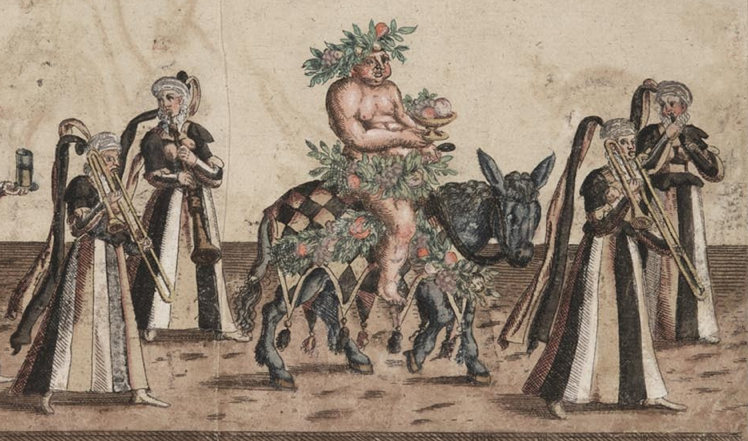
1582—Dresden, Germany: A festival book recording the details of a procession celebrating the marriage of Christian I of Saxony shows a group of 8 female musicians, the last of whom is playing a trombone (see below image, click for larger version; public domain).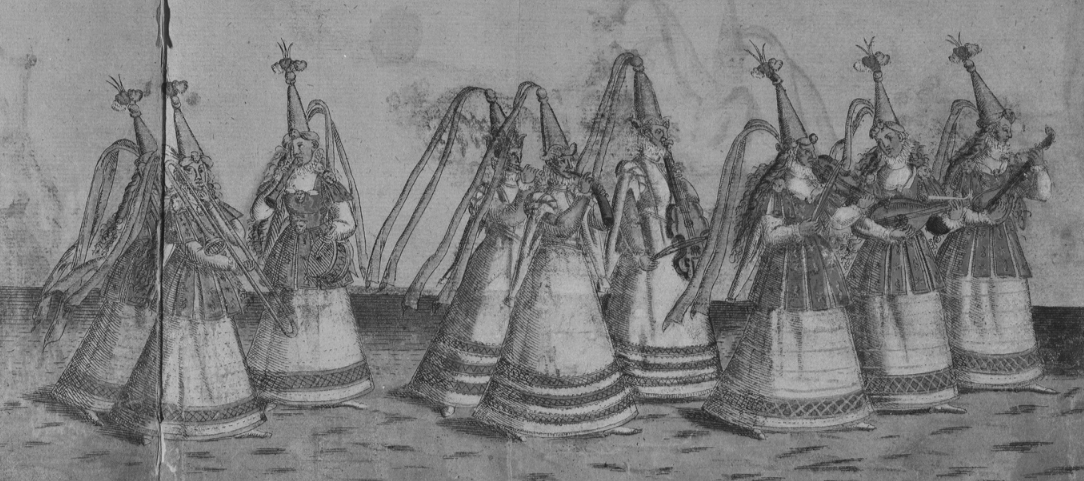
1582—Dresden, Germany: A festival book recording a procession celebrating the marriage of Christian I of Saxony (see also 2 entries above) shows a group of musicians on a festival wagon, including a trombonist playing the instrument in a very vertical position (see below image, click for larger version; public domain).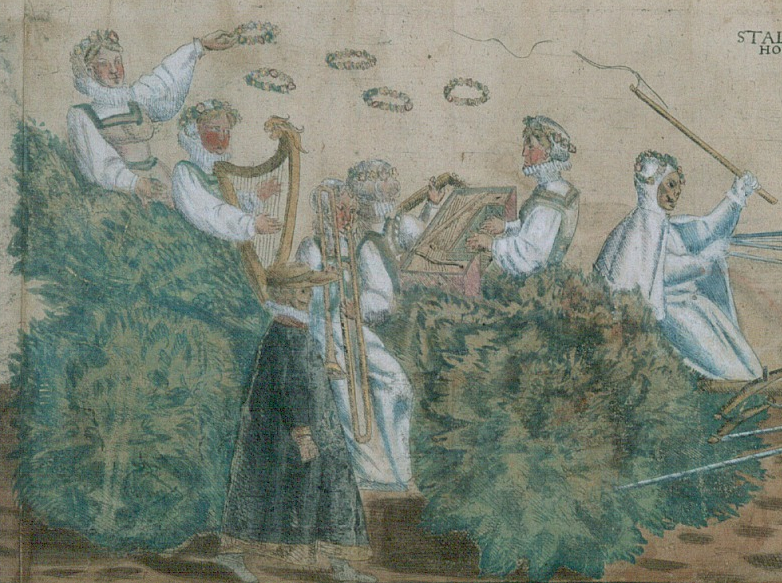
1582—Dresden: Artist Daniel Bretschneider records the events of a procession (see also 3 entries above), including 2 trombonists among a group of female instrumentalists (see below image—click on picture for larger version; public domain).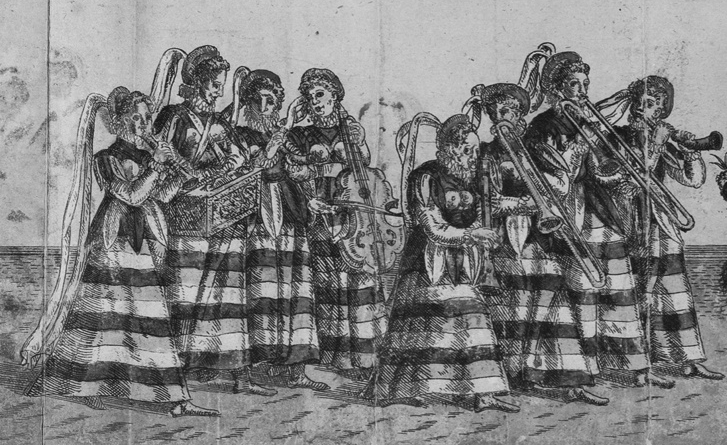
1583—Ferrara, Italy: Duc de Joyeuse visits Duke Alfonso. A letter describing the event mentions mealtime entertainment that is apparently commonplace: “They heard mass in the small chapel and then went to eat, with music as usual by trombones, cornett, and other instruments” (Newcomb 25).
1583—Rome, Italy: The Spanish Archconfraternity continues to employ a trombone player (trompon). A list of expenses specifically mentions that a trombone and cornett play at Vespers on Easter Day (O’Regan, Victoria).
1583—Leipzig, Germany: Tabulaturbuch Johannes Rühling includes an image of an angel playing trombone (see below image; public domain) (special thanks to Suzanne van Os).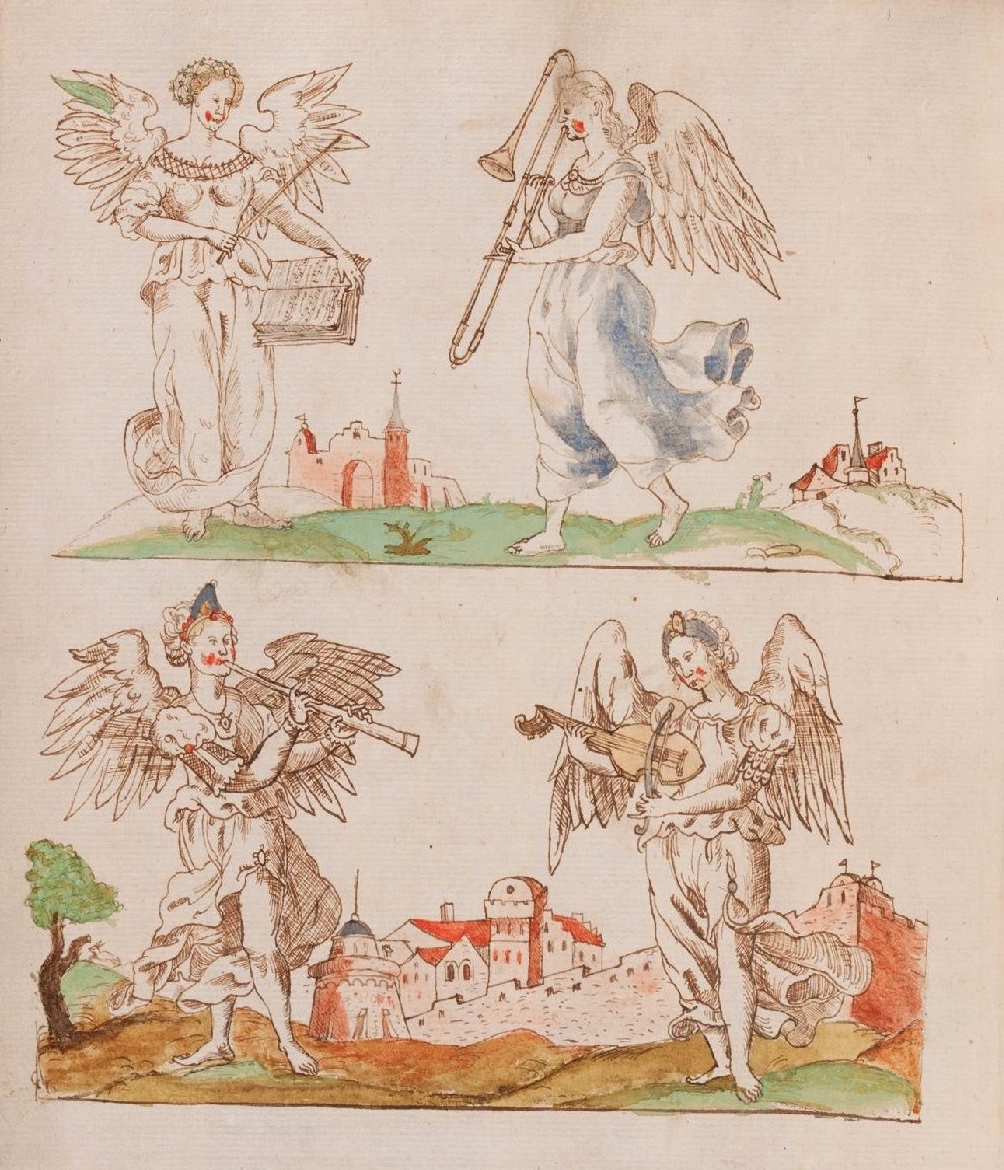
1584—Bologna, Italy: Ascanio Trombetti, master wind player of San Petronio and the ensemble Concerto Palatino, also serves as maestro di cappella at the convent of San Lorenzo. About the nuns at San Lorenzo he says, “As a musician, I’ve often gone to teach the sisters the trombone and viola. More precisely, I’ve taught the trombone and viola to Sister Florentia, and to many others as well—Sister Semidea Poggi, Sister Angelica Fava, Sister Panina, and Sister Cecilia Ghisliera” (Monson, Nuns Behaving Badly 53).
1584—Dresden, Germany: A colored engraving by Daniel Bretschneider of a procession shows an angel playing trombone (see below image; public domain) (source: Deutsche Fotothek).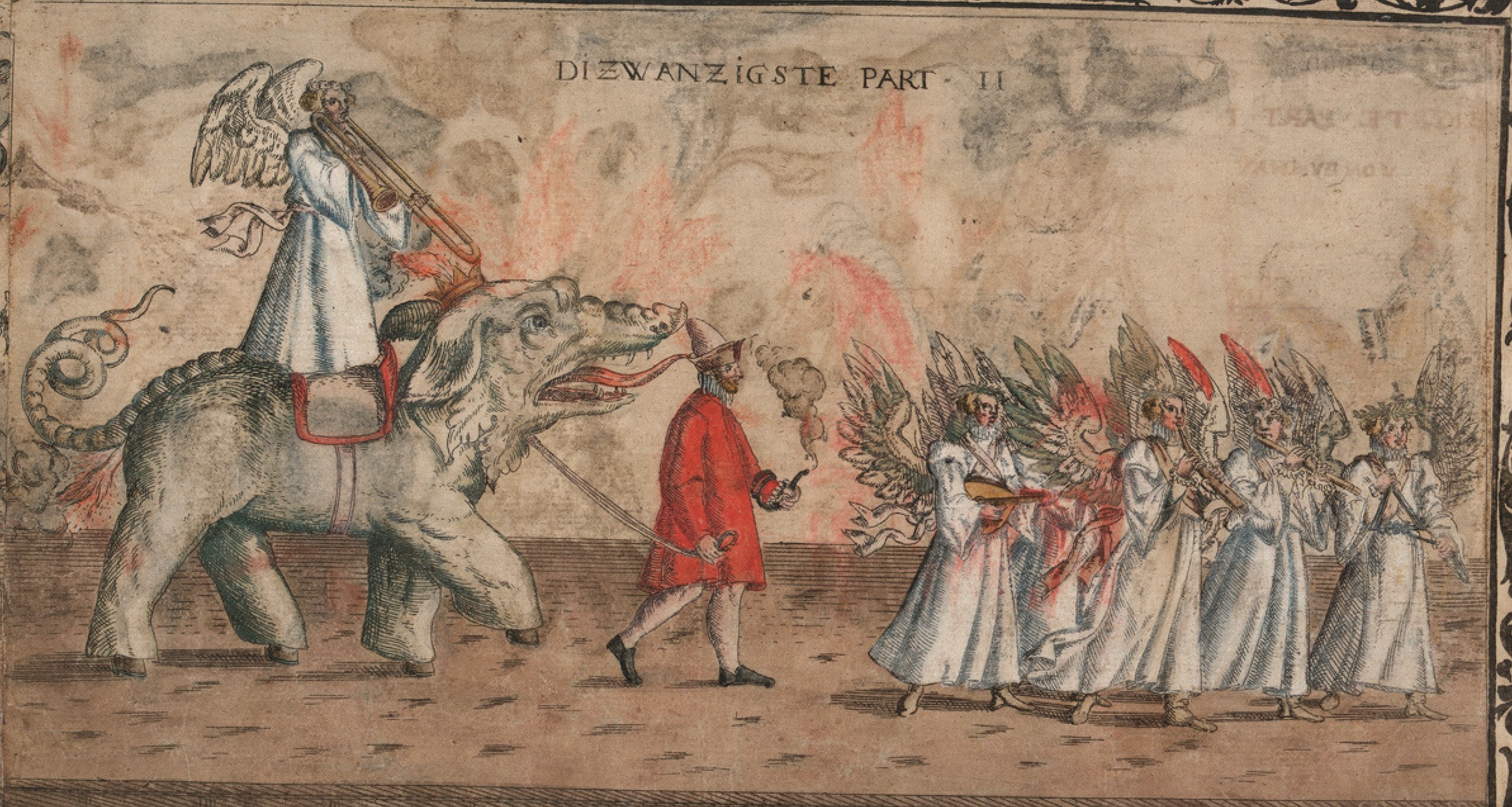
1584—Dresden, Germany: A procession during wedding festivities for Balthasar Wurm and Anton von Sahlhausen at the court of Saxony, includes 8 musicians dressed as women, playing trombone, lute, cittern, treble viol, bass recorder, tenor viol, transverse flute, and clavichord; a graphic representation of the procession shows the trombone at the head of the group (see below image; public domain) (Bowles, Musical Ensembles 105, 107).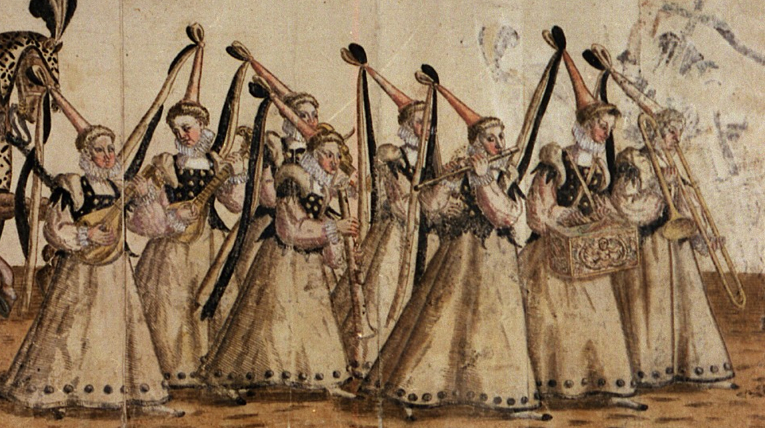
1584—Dresden, Germany: A procession during wedding festivities for Balthasar Wurm and Anton von Sahlhausen (see also entry above) features a group of 8 wind players, including 3 trombones. Close behind them follows an ominous-looking giant with a sickle, hour glass, and infants (see below image—click for larger version; public domain).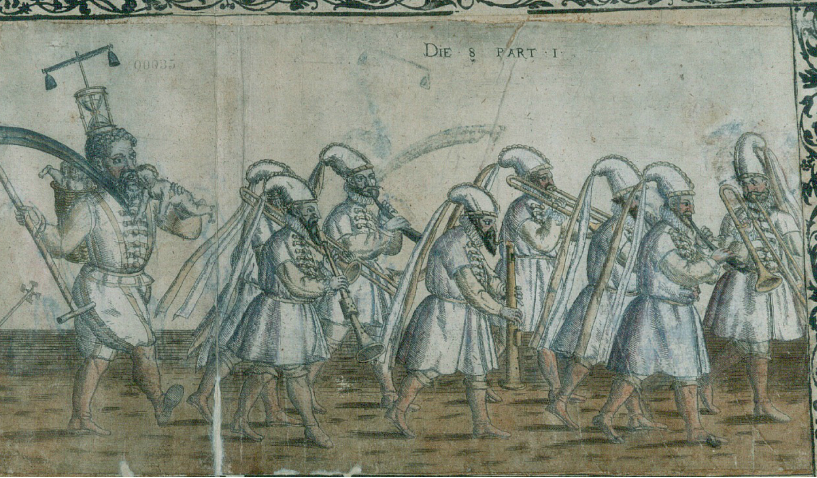
c. 1585—Florence, Italy: A description of a very large ensemble includes 2 cornetts, 3 trombones, 12 harpsichords, an organ, 30 viols, a violin, a shawm, a double bass and 12 lutes (Dickey, The Cornett 58).
c. 1585—Norwich, England: The town waits include sackbut (Woodfill 85).
c. 1585-1590—A long series of very similar images, probably beginning with David Singing God’s Praise, a painting by Pieter de Witte (also known as Peitro Candido and Peter Candid), includes an angel playing trombone among a mixed consort of angel-musicians. The upper half of the image is meant to depict Saint Cécile and angels. The lower half, not shown, depicts angels performing with David (Haarlem, Frans Hals Museum, photo A. Dingjan; Pieter Fischer 22). Shortly later (c. 1590), an engraving by Jan Sadeler, after Pieter de Witte’s painting, accompanies a setting of Psalm 150, Laudent Deum Cithara, by Orlando Lassus (see second detail) (Mirimonde 67). At around the same time, c. 1590, the top half of a painting by Otto Venius, the portion depicting St. Cecilia and angels, appears to either be a copy of or inspiration for the upper half of the painting by Peter de Witte (or one of the other versions) (see third detail below) (French National Library). A fourth image, a painting attributed to Hans Rottenhammer’s “circle,” follows that of Pieter de Witte in close detail. Like the others, only the top half of the image is shown (see fourth detail, below) (wikimedia commons). A fifth artwork, a silver relief by Christoph Lencker, is also modeled after the above Pieter de Witte painting (see fifth detail, below) (Pieter Fischer 23). Finally, a painted glass window in St. Helen’s church, Denton, England follows the same image. It is dated 1700 and signed by Giles of York (see sixth detail, below) (photo by Gordon Plumb). All images public domain. For more on this series of images, including several sketches not included in this timeline caption, see Paper, Canvas, Silver, Wood, and Glass: St. Cecilia Trombone Image in Many Forms.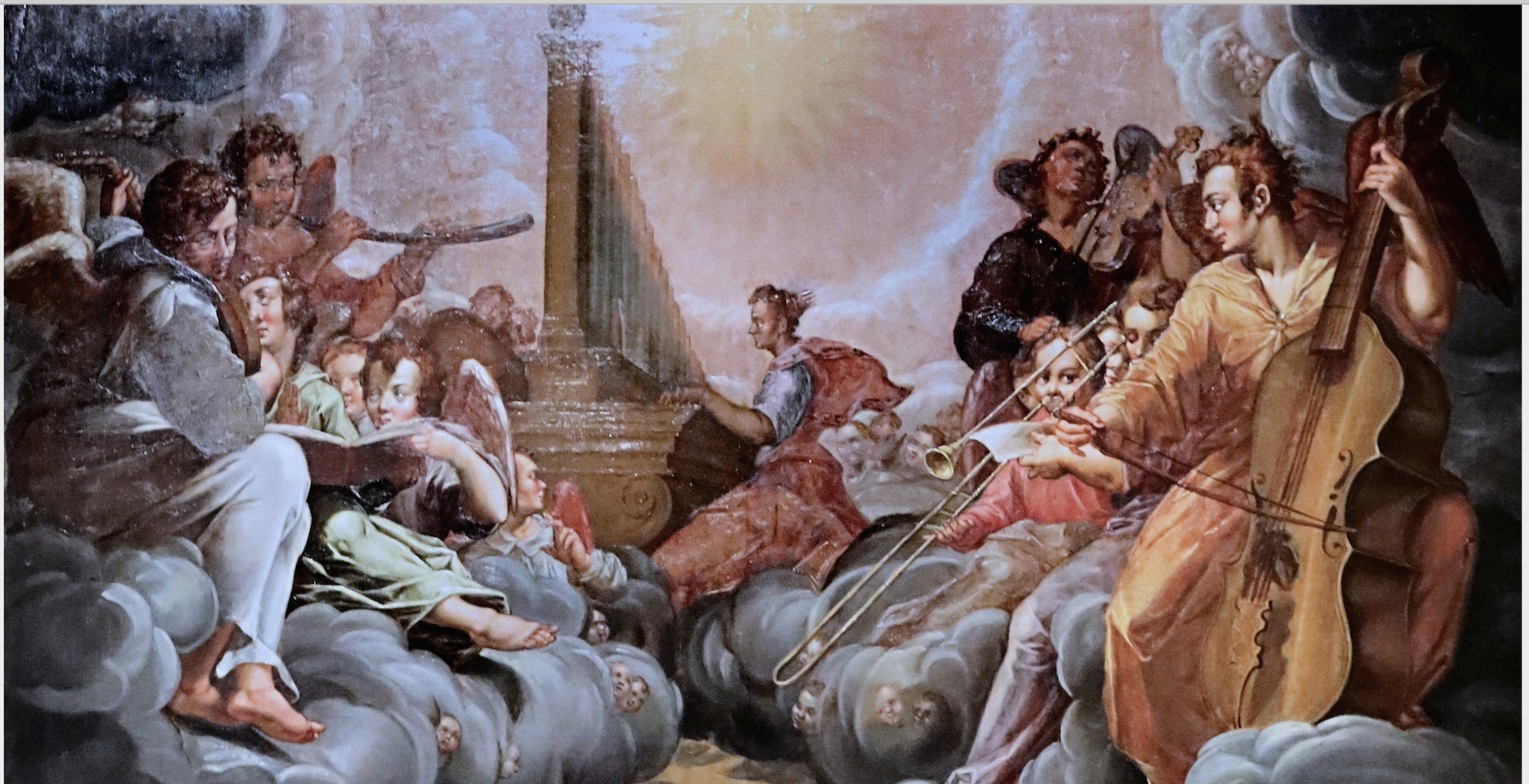
![]()
![]()
![]()
![]()
![]()
c. 1585—A painting attributed to Paolo Fiammingo (Pauwels Franck) features what appears to be a trombone among a group of 4 wind musicians playing from a balcony or loft (see detail and full image below; public domain).

1585—Verona, Italy: An inventory from the Accademia Filarmonica includes 3 trombones (tromboni) (Castellani, Veronese Inventory; Boydell, Crumhorn 102).
1585—Vicenza, Italy: The Pellizzari sisters, Lucia and Isabella, who are well-known vocalists, are singled out in praise for their playing of cornett and trombone in the production of Oedipo Tiranno at the Teatro Olimpico. They are sisters of Antonio Pellizzari, custodian of the Accademia Olimpica in Vicenza, and appear with their brother as musicians at the Accademia from around 1581 (Newcomb 100).
1585—Siena, Italy: A dispute arises between trombonists in the Palace wind band. According to the record, Alberto Gregori and Giovanbattista Formichi disagree over the right to play “the first bass in the musical ensemble, in truth, the basic and most important part.” Alberto claims that, as the successor to Tiberio, who previously held the post, he should have the position. Giovanbattista’s claim is that “it was an old custom of this chapel that the oldest persons succeeded to this post” and that he deserves the position because of seniority. In the end, the priors (city rulers) decree that each should have the honor a month at a time (D’Accone, Civic Muse 597).
1585—Siena, Italy: Ottavio Basili enters cathedral service as a boy soprano; as an adult he serves as a professional trombonist for the same cathedral from 1601 to 1610 (Reardon, Agostino Agazzari 48).
1585—While the prince of Transylvania travels at the opening of the parliament of Medgyes (modern Romania), the city trombonists, playing from the church tower, alternate with 8 trumpeters and a kettledrum stationed in front of the city wall (Reese 721).
1585—Transylvania (modern Romania): At the parliament of Medgyes, the opening church service includes a motet accompanied by a trombone and viola (Reese 725).
1585—Florence, Italy: Trombones, transverse flutes, lutes, and harps accompany a sea scene in the intermedio to Amico fido. In another intermedio, Striggio suggests the underworld in a vocal solo with accompaniment by 4 trombones and 4 bass viols (Weaver, Sixteenth-Century Instrumentation).
1586—Florence, Italy: The nobility enjoy frequent performances by children of the orphanage, who play cornetto, traversa, viola o trombone. These orphanage children also travel to Ferrara, Pistoia, and Lucca, Italy. Their leader, Franciosio, is founder of a school for instruction on wind and string instruments (Reese 546).
1586—Padua, Italy: The instrumental ensemble of St. Anthony’s basilica consists of 4 trombonists, 1 cornettist, and 1 violinist (Bettley, L’Ultima Hora).
1586—Italy: Philippo Oriolo da Bassano’s poem, Monte Parnaso, mentions trombone players (tromboni) playing along with other wind players (bagpipes, cornetts, and pifferi) at a ball. Bassano specifically praises the playing of a trombonist by the name of “Zacaria”: “There was a proud and noble chorus Of players so upright and perfect That near them David would appear base….Still others were playing in company with them On such pipes [piferri] and trombones [tromboni] So that such harmony was never heard before. Of these there was a certain Zacaria Whose trombone send such sweet tones to heaven That they were enjoyed by the cherubim and by the thrones.” Bassano mentions 2 other trombone players by name, “Allovise” and “Tosi” (Slim, Musicians on Parnassus).
1586—Brussels, Belgium: upon the death of Margaret of Parma, the estate includes several trombones (Niwa, Madama Margaret).
1586—Seville, Spain: The cathedral band continues to include at least 2 trombones (Kreitner, Minstrels in Spanish Churches).
1586—Seville, Spain: Chapelmaster Francisco Guerrero issues the cathedral band a set of guidelines, including directions on improvisation: “First, that Rojas and Lopez should always play the treble shawms, and that they should take great care in the order of the time and place of their glossing [improvising], so that when one is glossing, the other plays the music unadorned, each being careful of the other because when they gloss together it makes such absurdities as would stop up the ears….When the same Juan de Medina plays the contralto [shawm] alone as a treble with the trombones [sacabuches], the field is open to him to make whatever decorations and glosses he wants and can play well on his instrument” (Kreitner, Minstrels in Spanish Churches).
1586-1600—Germany: An image representing musicians in a wedding procession features an ensemble of 3 trombones and 2 cornetts (see below image; public domain) (graphic arts collection, German National Museum).
1587—Oxford, England: Dr. John Case, in his Praise of Musicke, mentions sackbut: “What shall I speak of the Lute, Citterne, Violle, Rebeck, Gittorne, Pandore, Dulcimer, Organes, Virginals, Flute, Fife, Recorders, of the Trumpet, Cornet, Sackbut, and infinite other sortes so excellent & pleasant in their sundrie kinds, that if art be any way faultie for them, it is for being too riotous and superfluous” (Newton, English Lute Music).
1587—England: John Howes recommends that the children of the school called Christ’s Hospital, later known as the Bluecoat School, “…learn to singe, to play upon all sorts of instruments, as to sounde the trumpet, the cornet, the recorder or flute, to play upon shagbolts, shalmes, & all other instruments that are to be plaid upon, either with winde or finger” (Boyd 15).
1587—Nuremberg, Germany: A tenor trombone that bears the inscription, “CUNRAT 9 LINCZER ME FECIT NURM 1587,” and 2 renderings of the Nuremberg coat of arms is manufactured. Typical of Renaissance-era construction, it has a conical bell with almost no terminal flare, richly engraved stays (or braces) between main sections of tubing, and no water key. The instrument is later found under the floor of St. Gertrude’s Chapel, Hamburg, in the early 19th century (Young 43).
1587—Munich, Germany: Records from the wedding of Pfalzgraf Wolfgang Wilhelm von Neuburg and Magdalena of Bavaria note, “As soon as the princes themselves had arrived, inside the church, up high, one could hear the trombones, trumpets, and timpani on opposite sides. After the congratulations [to the bridal couple] people once again entered the pews and sang the Te Deum Laudamus…” (Bowles, Timpani 366).
1587—Mantua, Italy: Trombones perform with numerous other musicians at the coronation of Vincenzo Gonzaga as Duke of Mantua. As recorded in the festival book, “The music for the coronation Mass was sheer perfection, written for this specific event by that most excellent musician and maestro di cappella of His Highness, Signor Giaches de Wert, known for the superiority of his compositions [and] world famous; and following the ensemble pieces were [concerti] for organ, voices, cornets and trombones…” (Bowles, Music in Court Festivals; Sanders, Gonzaga 99).
1587—Venice, Italy: Existing vocal partbooks for Andrei Gabrieli’s motet Judica me include handwritten suggestions for instrumental performance, including 2 parts for trombone (Kurtzman Monteverdi Vespers 140).
1587—Nuremberg, Germany: An inventory of the Nuremberg Frauenkirche notes, “Further, a short double-trombone [kursze Toppel Posaunen] was returned in 1587 to Anton Schnitzer, to whom it belongs. One piece” (Raquet).
1587—Dresden, Germany: Artist Daniel Bretschneider records the events of a procession, including a group of trombones and cornetts (see below image; public domain).
1588—Pisa, Italy: A performance heralding the entrance of Grand Duke Ferdinand de’ Medici into the city uses an ensemble of 64 singers, 2 harpsichords, 4 cornetts, 4 trombones, an organ, 2 viole da gamba, and 4 lutes (Dickey, The Cornett 58; Broder).
1588—France: Thoinot Arbeau mentions the trombone in Orchesography, his treatise on dancing. First, he complains,“Nowadays there is no workman so humble that he does not wish to have hautboys and sackbuts at his wedding” (Arbeau 51). Later, he describes use of the instrument by royalty for dances on solemn feast days: “On solemn feast days the pavan is employed by kings, princes and great noblemen to display themselves in their fine mantles and ceremonial robes. They are accompanied by queens, princesses and great ladies, the long trains of their dresses loosened and sweeping behind them, sometimes borne by damsels. And it is the said pavans, played by hautboys and sackbuts, that announce the grand ball and are arranged to last until the dancers have circled the hall two or three times, unless they prefer to dance it by advancing and retreating. Pavans are also used in masquerades to herald the entrance of the gods and goddesses in their triumphal chariots or emperors and kings in full majesty” (Arbeau 59).
1588—Siena, Italy: Trombonist Giovanbattista Formichi replaces Tiberio di Girolamo Rivolti as trombonist in the cathedral chapel (D’Accone, Civic Muse 596).
1588—Mantua, Italy: A trombonist is hired at the Mantua cathedral (Herbert, Trombone 101).
1588—Florence, Italy: At the wedding festivities for Grand Duke Ferdinand III de’ Medici and Christine of Lorraine, the wedding entourage proceeds to the Church of Santa Maria del Fiore, where it is accompanied by “music of trombones and cornetts, which [came] from the middle portal” (Bowles, Musical Ensembles 117).
1589—Strasbourg, France: Martin Braun, a wealthy merchant, adds new upper floors and commissions carvings and paintings for Maison Kammerzell (also known as Kammerzellhaus), a famous half-timbered building across from the Strasbourg Cathedral. Among the numerous outside carvings of musicians—some with wings, some without—is an angel playing the trombone. Like many works of art of such age, the current carvings are the result of multiple restorations (see below image; public domain) (Pudlowski 50; special thanks to Valentin Guérin).

1589—Munich, Germany: A woodcut by Johannes Nell on the title page of Lasso’s Patrocinium musices includes a depiction of 2 trombonists performing in an ensemble of 9 instrumentalists and 5 singers (see below image; public domain) (Kinsky 90).
1589—Canterbury, England: A visiting Italian observes a service at Canterbury Cathedral, according to a report, and, upon hearing “the solemne Musicke with the voices, and Organs, Cornets, and Sagbutts, hee was overtaken with admiration, and tolde an English Gentleman…that (unlesse it were in the Popes Chappell) hee never saw a more solemne sight, or heard a more heavenly sound” (Parrott, Grett and Solompne Singing).
1589—Norwich, England: Sir Francis Drake, sailing as second in command of a fleet under Sir John Norris in order to “singe the King of Spain’s beard” gets special permission to take with him, as his private band, the Norwich waits. The waits include trombone (among preparations for the trip is the purchase of a new saquebut case). The mortality of the trip is enormous; of the 6 waits who make the trip, only 2 return (Bridge, Town Waits and Their Tunes).
1589—Florence, Italy: Trombones are used to accompany voices singing of the horrors of Avernus in Giovanni Bardi’s “Miseri habitator,” one of the pieces performed at Florence festivities (Westrup, Monteverdi and the Orchestra).
1589—Padua, Italy: Compline is celebrated at St. Anthony’s basilica with expanded instrumental forces, including 5 trombones (one of whom doubles as a vocalist) (Bettley, L’Ultima Hora).
1589—Pisa, Italy: At celebrations surrounding the visit of Christine [Madama Christierna de l’Oreno Gran duchessa di Toscana], a mock battle on the Arno River between Christians and Turks concludes with a performance of music by Antonio Buonavita in which the “Arabi” sing 3 ottave:the 1st is a solo aria; the 2nd is a work in 10 parts, performed by 52 people with 6 trombones, 4 cornetts, and organ; and the 3rd is a work in 20 parts, performed by the same forces as the 2nd ottava (Fenlon, Music and Culture in Late Renaissance Italy, 225).
1589—London, England: An intermedio is performed that utilizes 4 trombones, a cornetto, a transverse flute, and various string instruments (Weaver, Sixteenth-Century Instrumentation).
1589—Basel, Switzerland: Nicolas von Riedt includes a trombonist in his Fastnachtszug, a depiction of a carnival procession of 8 elaborately masked and costumed men (see facing image; public domain; click picture for larger version) (Salmen, Musikleben im 16 80-81).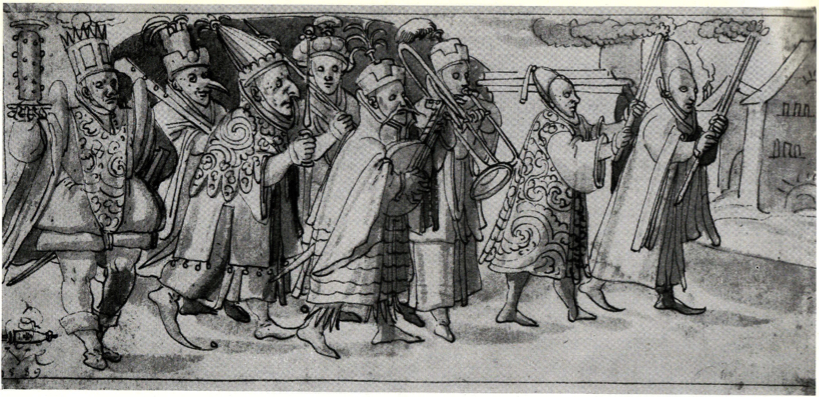
1589—Siena, Italy: In the town square, as part of the ceremonies for the entrance of Archbishop Ascanio Piccolomini into the city, “a joyful concert of trombones, curtals, flutes, cornetts, and other wind instruments filled everyone with pleasure…” (D’Accone, Civic Muse 677).
1589—Siena, Italy: For May Day festivities, shepherds sing the 5-part madrigal, “Oh dolcezza d’Amor soave, e grata,” accompanied by “bowed violas, recorders, lutes, and trombones.” The festival’s closing madrigal, “Vaghe, novelle fronde,” is accompanied by violas, curtals, trombones, and recorders (D’Accone, Civic Muse 703).
1589—Russia: Johann David Wunderer of Strassburg, Germany writes about Russian military music: “In battles and parades they use many trombones [posaunen], crumhorns, shawms and other wind instruments which are unknown in Germany” (Boydell, Crumhorn 63).
1589-1598—When the Morning Stars Sang Together, an engraving by Adriaen Collaert, after an image by Jan van der Straeten, includes an angel-trombonist among a number of angel-musicians (in the middle, partially obscured). Beneath is a Latin caption of a verse from Job 28 (see below image; public domain; click on picture for larger version) (Goodfriend, pl. 16).
c. 1590—Milan, Italy: Aurelio Luini depicts a cherub playing trombone in his fresco in Milan’s San Simpliciano (see below image; public domain) (Kendrick, Sounds of Milan 77).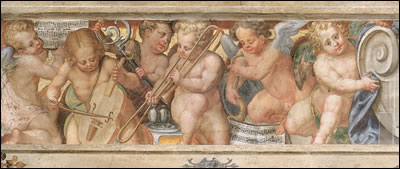
c. 1590—The painting Musical Scene, by Lodewyk Toeput (c. 1550-c. 1603), a Flemish painter active in Italy, features a pair of trombones in a musical ensemble (see below image; public domain). Courtesy of Tassos Dimitriadis.
c. 1590—Ravenna, Italy: Giovanni Laurenti’s painting in the Basilica of Santa Maria in Porto includes an angel-trombonist performing with harp, lute, flute, and recorder (see below image; public domain) (source: recorder home page). Click for larger image.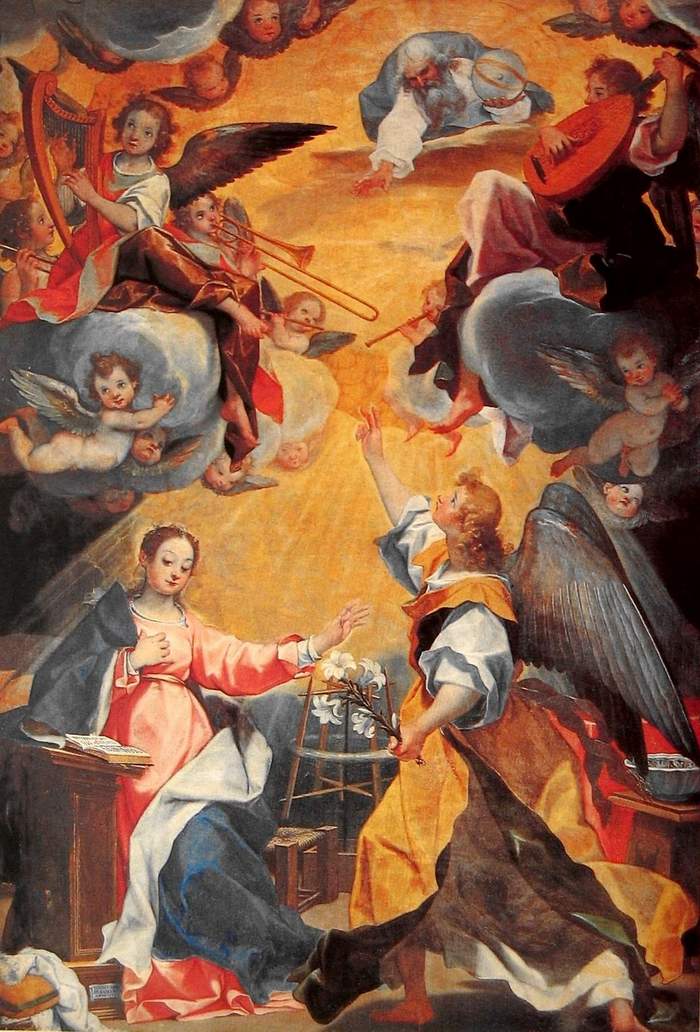
c. 1590—Loano, Italy: Battesimo di Gesu (Baptism of Jesus), a painting by Giulio Cesare Semino located in Chiesa di S. Agostino, includes a cherub playing trombone (see below image; public domain).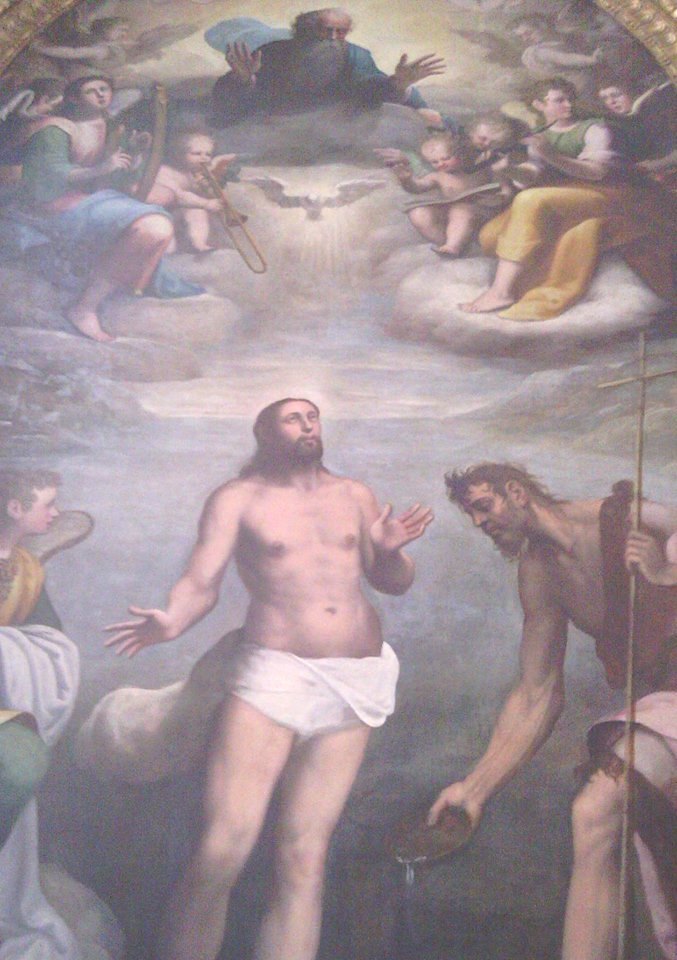
c. 1590—Florence, Italy: Jacopo Corsi acquires, to go with his large collection of musical instruments, two trombones brought from Nuremberg (Carter, Late Renaissance Florence 71).
c. 1590—Treviso, Italy: The cathedral employs its own wind band of trombones, trumpets, and cornetts. Pietr’ Antonio Spalenza, the maestro di cappella, is reprimanded for taking this band to perform along with his choir at a nearby convent of Augustinian nuns, since the organ is the only instrument permitted in closed convents (Whitwell, Renaissance 252).
c. 1590—The drawing, Coronation of the Virgin with Angel Musicians and All Saints, attributed to “Master J.N.,” a German or Netherlandish artist active during the late 16th century, includes an angel playing trombone (see detail and full image below; public domain) (National Gallery of Art; Washington, D.C.).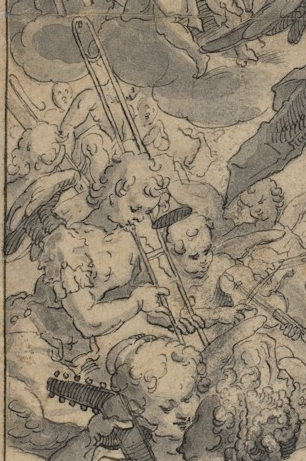

c. 1590—Rome, Italy: A fresco by Cristoforo Roncalli (Pomarancio) in the cupola of Sant’Andrea della Valle depicts music-making angels, including one playing trombone (see detail and full image below; public domain).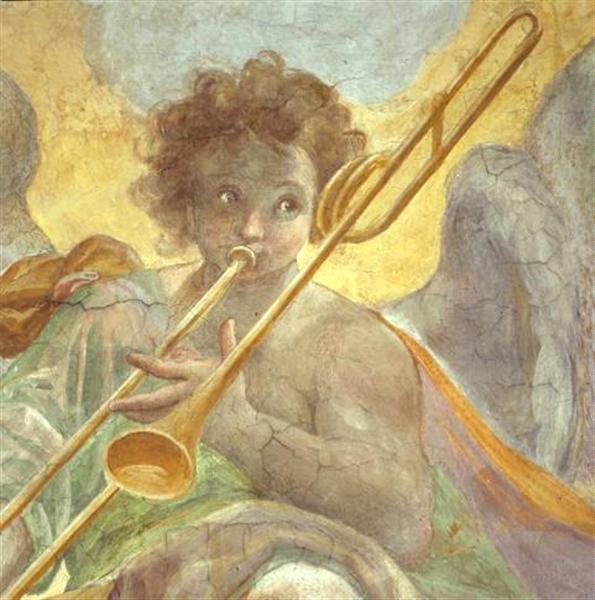
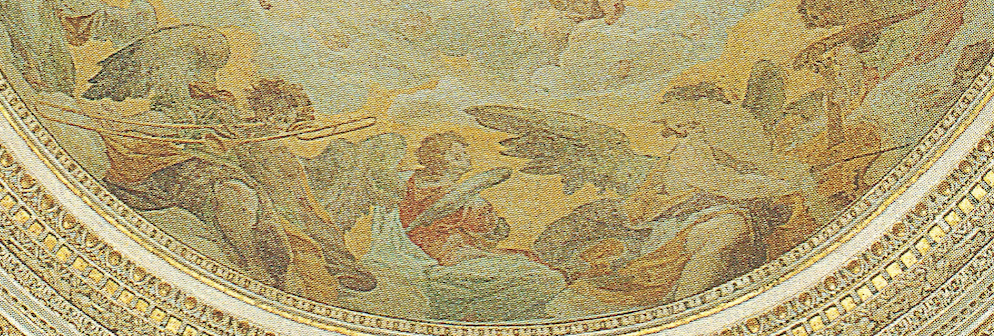
1590—London, England: The King’s Musick decreases its number of sackbuts from 7 to 4: John Lanier, Marke Anthonio Basano, Raphe Grene, and Samuel Garshe (Woodfill 300). The “musicians of the chamber” are classified as musicions, Violens, Sagbotes, and Flutes (Woodfill 308).
1590—London, England: Andrea Bassano is employed as a recorder player in The King’s Musick. Apparently a versatile musician, he is later listed as an instrument maker (in 1603) and a sackbut player (in 1625) (Woodfill 308).
1590—Genoa, Italy: A document stipulates that “the musicians shall be seven or eight in number, with parts for trombones and parts for cornetts, that is, first and second trombone, first and second cornett, and the other three parts in the middle shall be given to trombones or to cornetts according to what is required” (Dickey, The Cornett 56).
1590/91—York Minster, England: Payments are made “to those that played upon Sagbuttes and Cornettes” (Payne 147).
c. 1591—Augsburg, Germany: An oil painting by Abraham Schelhas titled Augsburger Geschlechtertanz depicts an aristocratic dance in Augsburg. The 4 wind musicians providing the music play from a balcony and include a trombonist; the other instruments appear to be cornettos or shawms (see detail and full image below; public domain) (Augsburg, Städtische Kunstsammlung; Salmen, Tanz im 17 151).![]()
![]()
1591—Augsburg, Germany: A woodcut on the title page of Adam Gumpelzhaimer’s Neue Teutsche Geistliche Lieder (re-used for at least one subsequent work) includes a depiction of a female trombonist as part of an apparently all-female ensemble (see below detail; click on image for larger version; public domain) (Naylor 221; Kinsky 85).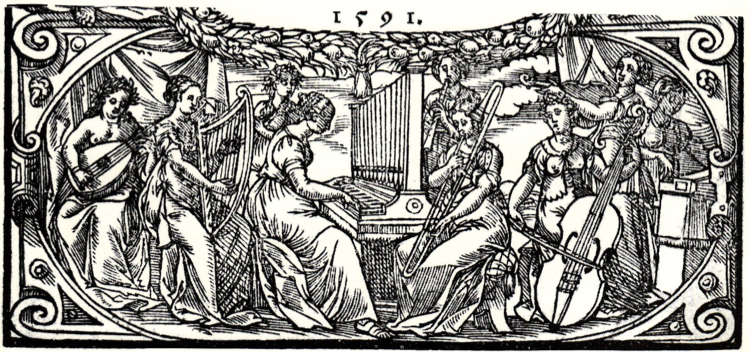
1591—Rome, Italy: Records of an Easter Day performance at the Spanish Archconfraternity show payments “al trombon de Castello” and “a los dos trombones de Campidoglio” (O’Regan, Victoria).
1591—Rome, Italy: For the Assumption of the Virgin at S. Maria Maggiore, cornetto and trombone are engaged for first and second Vespers and Mass (Lightbourne).
1591—Rome, Italy: Music for the feast of Our Lady of the Snows at S. Maria Maggiore includes violin, cornetto, and trombone (Lightbourne).
1591—Rome, Italy: Artist Ferrau Fenzoni includes an angel playing trombone in a ceiling painting in the chapel of St. Francis in the church of Santa Maria in Trastevere (see detail and full image below; public domain) (Schwed, New Drawings by Ferrau Fenzoni).

1591—Italy: Luca Marenzio calls for trombone in the “Combatimento di Apolline col Serpente” of his Intermedii et Concerti (Collver 135).
1591—Venice, Italy: Zacconi’s Prattica di Musica mentions trombones (tromboni) along with other wind instruments (Boydell, Crumhorn 297).
1591—Dresden, Germany: Artist Daniel Bretschneider includes 2 trombones in his depiction of a procession celebrating the christening of Dorothea, the daughter of Duke Christian I. The depiction features Bacchus in chains, led in procession by Georg Rudolph Marschalch in Roman costume (see below image; public domain). 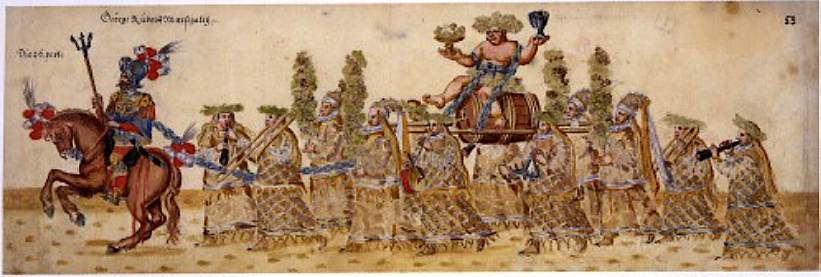
1591—Dresden, Germany: A group of elaborately-costumed musicians, documented by artist Daniel Bretschneider, includes a trombonist. The group is part of a larger procession celebrating the baptism of the daughter of Elector Christian I, Dorothea (see below image—click picture for larger version; public domain) (Dresden, Sächsische Landesbibliothek). 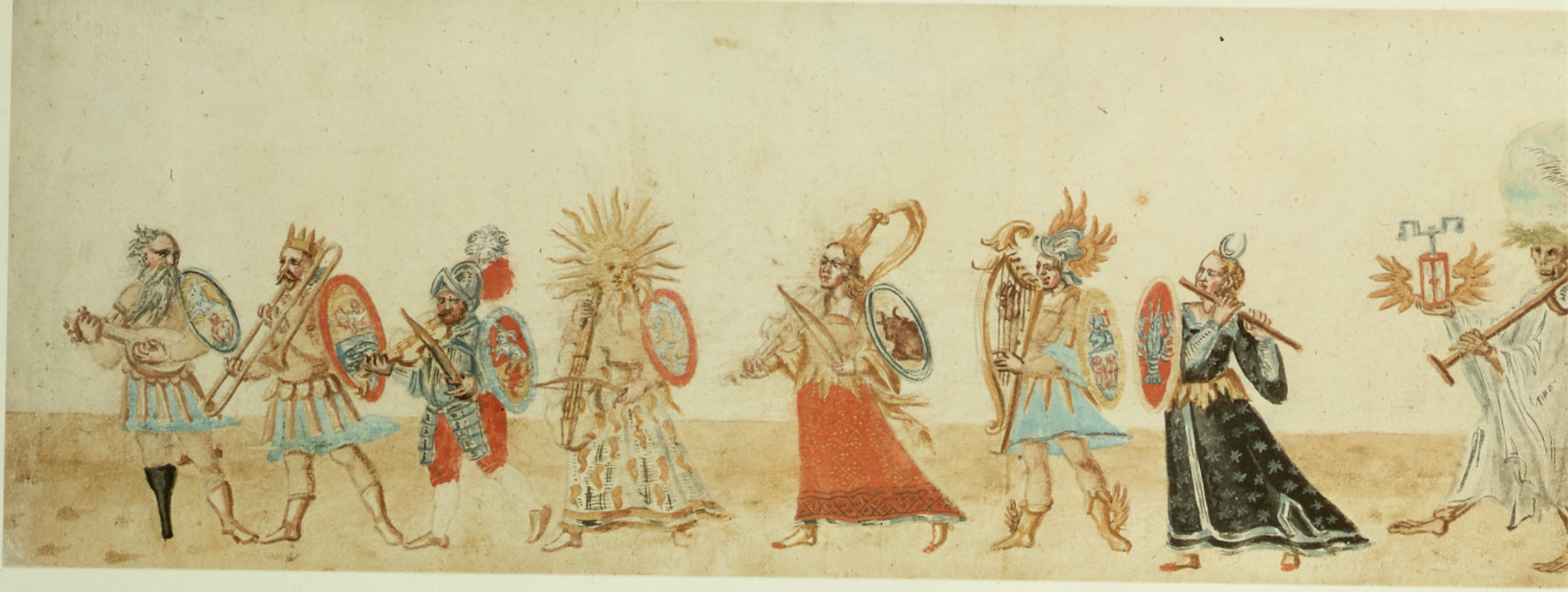
1591—Dresden, Germany: Artist Daniel Bretschneider depicts “wild men” and a group of bears playing musical instruments, including trombone. The figures are part of a procession celebrating the baptism of Dorothea, daughter of Christian I (see detail and full image below; public domain) (Dresden, Sächsische Landesbibliothek).
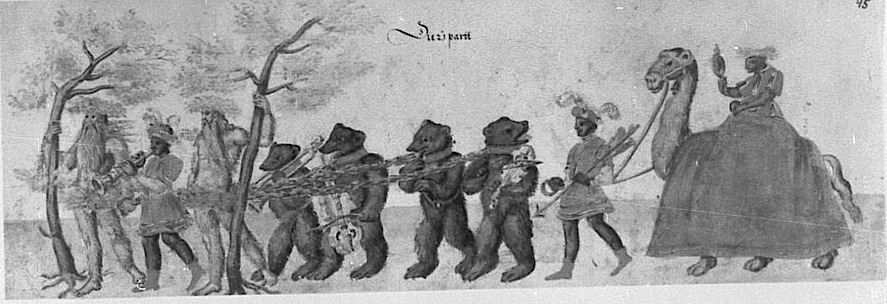
1592—Mexico City, Mexico: A trombonist is hired for the cathedral orchestra (Stevenson, Mexico City Cathedral Music).
1592—Naples, Italy: An inventory of holdings of the Spanish nobleman Marquis Ferdinando d’Alarçon includes what is probably a bass trombone (un trombone de biffali grande), as well as a trombone of old Cypriot copper (Uno trombone di ramo cipro vecchio) (Mammarella, Musical Instrument in a 1592 Inventory).
1592-9—Germany: An anonymous painting from the Album of Hieremias Buroner of Augsburg depicts a consort consisting of trombone, 2 singers, positive organ, cornett, bass viol, violin, and lute (see below detail; public domain) (Remnant, Musical Instruments of the West 202; London, British Library). 
1592-1601—Freibourg, Switzerland: The high altar in the Augustin Church includes a sculpture by Peter Spring depicting an angel playing a trombone (see detail and full image below; public domain) (Wold 82). Click on full image to expand.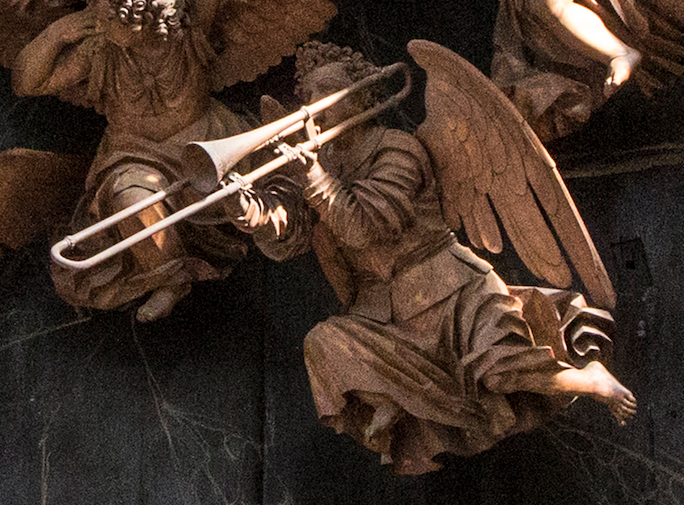
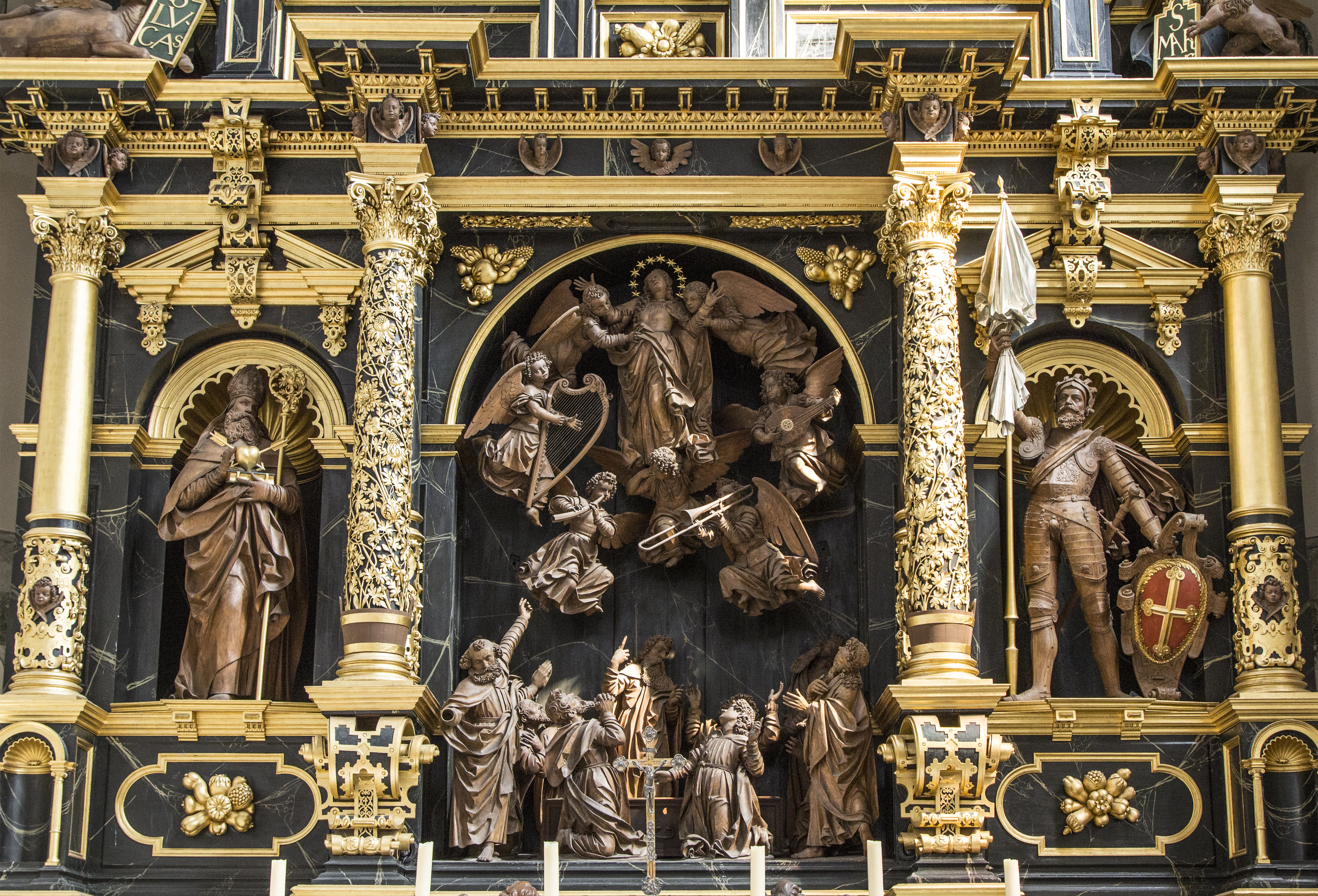
1592/1604—Czech Republic: A page from Graduál český features a decorated border with numerous musicians, including a trombonist. The artwork may be by painter Matouš Radouš, who did some of the volume’s decorations (see detail and full image below; public domain) (sources: Museum of Eastern Bohemia, Hradec Králové; Manuscriptorium; artsandculture.google.com; special thanks to Richard Seda).
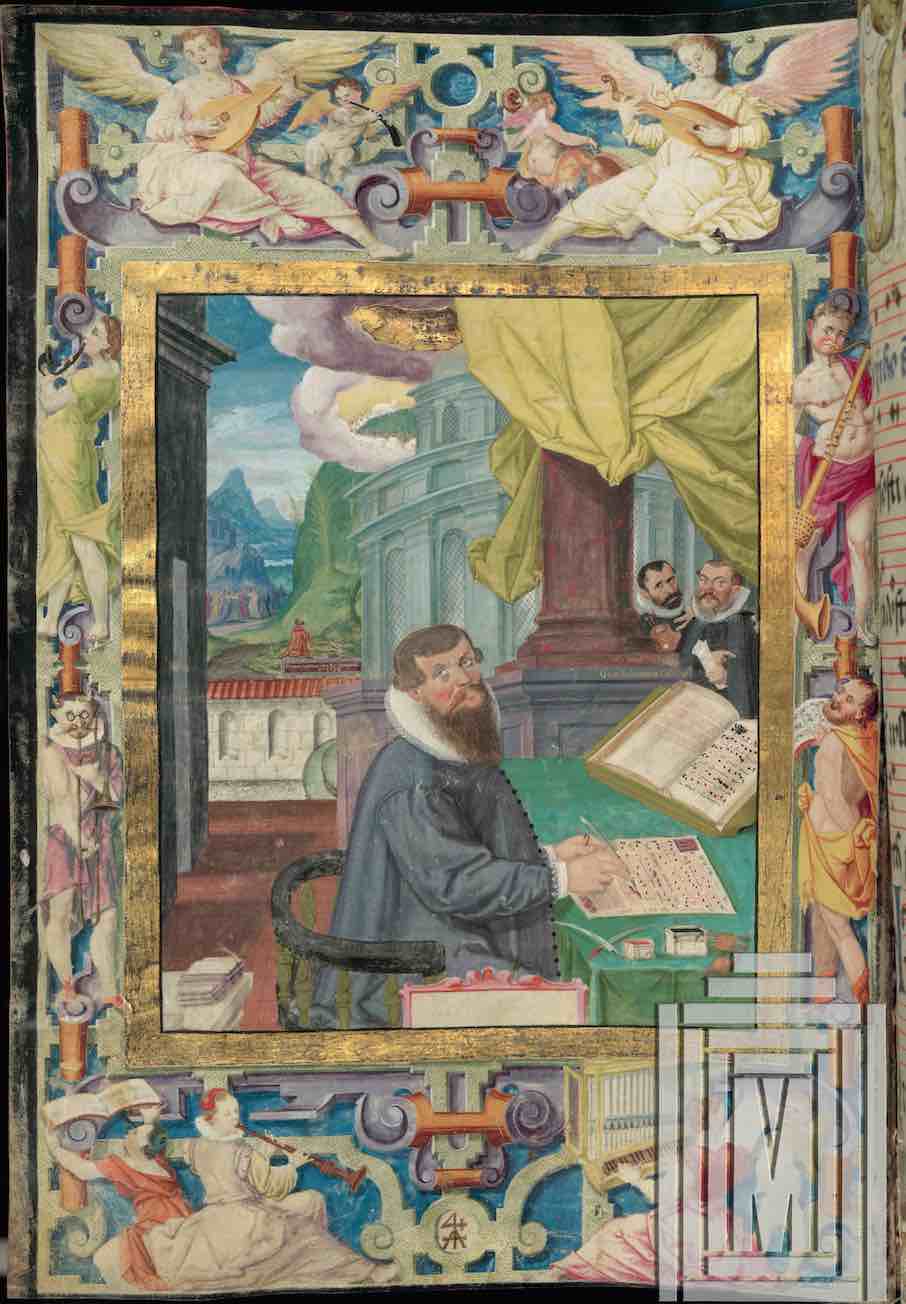
1593—Arnstadt, Germany: A letter from Count Anton Heinrich of Sondershausen to Christian Kirchberger, treasurer of the Arnstadt town council, lists instruments the Count wants purchased in Leipzig for his Hofkapelle. Included is a request for Einfache Posaunen (ordinary trombones), implying, of course, various sizes of trombones (Boydell, Crumhorn 66).
1593—Dresden, Germany: An Octav-posaune is retained as a rarity (Baines, Brass 117).
1593—Verona, Italy: Upon the death of Count Mario Bevilacqua, the count leaves a collection of instruments that includes Due tromboni, un grande, et uno piccolo (Castellani, Veronese Inventory).
1593—France: An instrument that can be categorized as both the oldest surviving bass trombone and the oldest surviving non-German trombone is manufactured (Baines, Brass 111). Made by Pierre Colbert of Rheims, it contains an extension handle for operating the extremely long slide (instrument held in Gemeente Museum, The Hague) (Bessaraboff 191; Montagu 105). Herbert lists an older bass trombone (1579), made in Nuremberg and held in Accademia Filarmonica, Verona (Herbert, Trombone 311).
1593—Landsberg am Lech, Germany: Assumption of the Virgin, a painting by Pieter de Witte (also known as Pietro Candido and Peter Candid) located at the Marienaltar of the Heilig Kreuzkirche, includes and angel playing trombone (see below image; public domain) (Burresi 73-74; painting now located at Landsberg am Lech Neues Stadtmuseum).
1593—Dresden, Germany: An inventory of instruments in the court’s Instrumentenkammer includes trombones of several different sizes (Oleskiewicz 162).
1593—Cuenca, Spain: A player by the name of Bartolomé de Selma is employed as a trombone player at Cuenca Cathedral, where he remains until 1612 (De Pascual).
1594—Siena, Italy: A choir vault in Certosa di Maggiano, painted by Bartolomeo Cesi, features numerous angel-musicians surrounding the Holy Trinity, including a trombone partially obscured by a triangle (see detail and full image below; click full image for larger version; public domain) (Graziani 24).
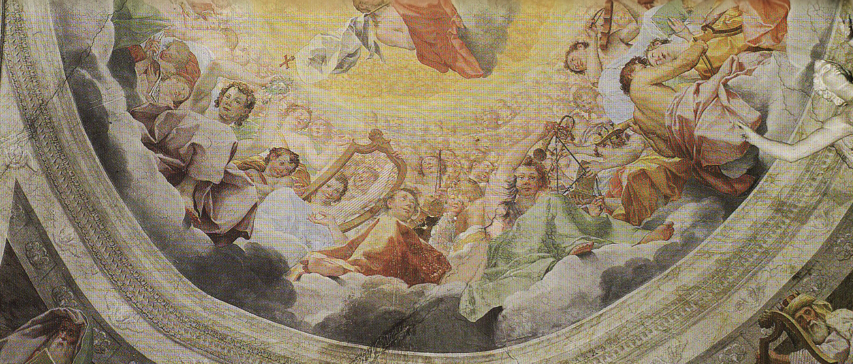
1594—Liverpool, England: The city buys an additional sackbut for their town waits (Woodfill 85).
1594—Padua, Italy: The instrumental ensemble of St. Anthony’s basilica consists of 2 trombonists, a cornettist, and a violinist (Kurtzman Monteverdi Vespers 380).
1594—Ferrara, Italy: According to Ercole Bottrigari, nuns at Santa Vito convent play “cornetts and trombones [cornetti & tromboni], which are the most difficult of musical instruments….with such grace, and with such a nice manner [con tanta gratia, & con si gentil maniera], and such sonorous and just intonation of the notes that even people who are esteemed most excellent in the profession confess that it is incredible to anyone who does not actually see and hear it. And their passagework is not of the kind that is chopped up, furious, and continuous, such that it spoils and distorts the principal air, which the skillful composer worked ingeniously to give to the cantilena; but at times and in certain places there are such light, vivacious embellishments that they enhance the music and give it the greatest spirit” (Bottrigari-MacClintock 59; Bottrigari 49). Musicologist Bruce Dickey also speculates that, because there were no male voices to sing lower parts, many convents featured excellent tenor and bass trombonists: “Despite the fact that church authorities continued to forbid the use of most musical instruments in the convents, many nuns were renowned for their ability not only on cornetts but also on tenor and bass trombones” (Dickey, Cornett and Sackbut 107).
1594—Rome: Although instrumental forces for Easter morning services are reduced compared to previous years, the core group of players still includes trombone (trompon) (O’Regan, Victoria).
1594—Antwerp, Belgium: At the triumphal entry of Archduke Ernest of Austria, a specially constructed “Theater of Peace” features the 9 Muses, 6 playing cornett, trombone (buisine), triangle, viola da braccio, flute, and gamba, and 3 singing from part books (Bowles, Musical Ensembles 129). Later, in the square facing the city hall, celebrations continue: “fires were lit, to the applause and delight of the city. The number of spectators was no smaller than on the previous day, nor was the combination of cornetts, trumpets, shawms and trombones any more unpleasant, as they caused sleeplessness through almost the entire night (Bowles, Musical Ensembles 130).
1594-5—England: 4 pounds is paid for a sackbut and the Cariage at Trinity (Payne 146).
c. 1595—Italy: An engraving by Antonio Tempesta entitled A Musical Gathering in the Company of Caged Birds, from Various Methods of Capturing Birds, features a trombone performing with a mixed consort of strings, winds, and keyboard; A wind consort performs in the background (see below image, click to expand; public domain) (Bibliotheca Hertziana, Rome; Graphische Sammlung Albertina, Vienna; Buffa 248).
c. 1595—Francesco Albani’s painting, Trinity with the Virgin Mary and Musician Angels, includes an angel playing trombone (see detail and full image below; public domain) (Puglisi 96; Finaldi 24; Fitzwilliam Museum).
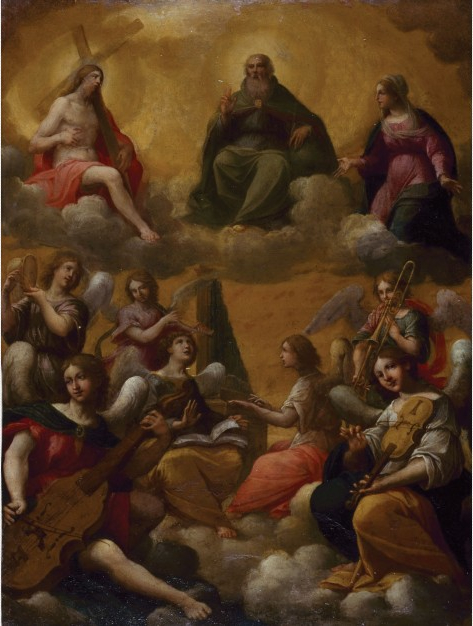
c. 1595—Poppi, Arezzo, Italy: A painting of the annunciation attributed to Francesco Morandini and located in Chiesa della Santissima Annunziata, Monastero delle Camaldolesi, includes a small angel-trombonist among the angels in the upper-left portion of the painting (see below image; public domain).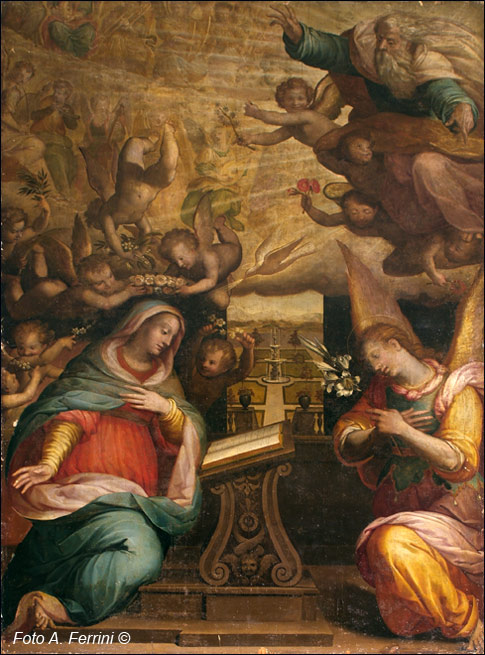
1595—Antwerp, Belgium: Philippe Galle’s copperplate engraving, after a work by Johannes Stradanus (Jan van der Straat), features trombone performing in a sacred setting, during the celebration of a Mass. One trombone is pictured in the immediate foreground, while another, possibly an alto trombone, is shown very near the music desk. What is possibly yet another trombone is pictured in the shadows in the upper right of the image with another music desk and a cornetto (click on image for an enlarged version). The text at the bottom of the engraving reads, “The people refine the heavenly worship with melodious arts and adorn the sacred rites with song. The horns fill the holiest portion of the temple with many sweet tones; the fistula [reed pipe] plays harmoniously with the Etruscan trumpet, and discord delights the souls, and the Muse lifts the earthly minds to the heavens” (see below image; click picture for larger version; public domain) (Salmen, Musikleben im 16 183; Naylor 10).
1595—Rome: A trombonist is employed at the confraternity SS. Crocefisso for services during Lent (O’Regan, Marenzio’s Sacred Music).
1595—Rome: A document details current instrumental practice: “On a feast, when a maestro brings together musicians for two Vespers and a Mass, he will invite members of the papal chapel, and instruments such as cornett, trombones, violins and lutes” (Dixon, The Performance of Palestrina).
1595—Nuremberg, Germany: Tenor trombone by Antoni Drewelwecz (Germanisches Nationalmuseum, Nüremberg) (Montagu 105).
1595—Antwerp, Belgium: The frontispiece for Andreas Pevernage’s motet, “Nata et grata,” features an engraving by A. Collaert that includes a depiction of a trombone (far left of below image; public domain) (Komma 112).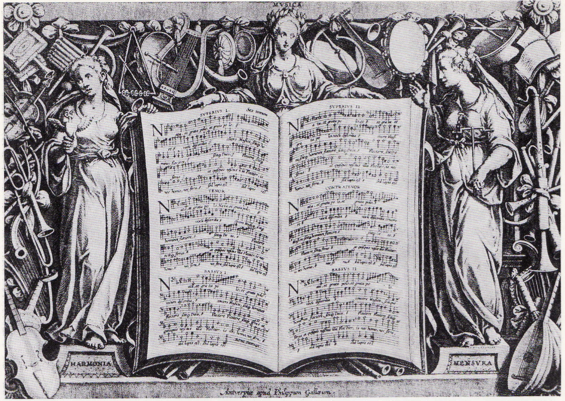
1595—Bologna, Italy: A record of salaries at San Petronio lists 6 instrumentalists: 4 trombones, 1 cornetto, and 1 violin (Schnoebelen, Performance Practices at San Petronio, 44).
1595—Spain: Bartolomé de Selma, trombonist at the Cuenca Cathedral, is paid to repair 2 of the cathedral trombones (De Pascual).
1596—Innsbruck, Austria: An inventory of the instrument collection of Archduke Ferdinand II lists 20 trombones (Whitwell, Renaissance 107).
1597—Italy: In Italian prints of sacred music from this date, and for some 35 years afterwards, the 3 instruments most commonly specified are violino, cornetto, and trombone (Bonta Sacred 524).
1597—Mantua, Italy: Vincenzo Gonzaga, Duke of Mantua, orders 8 trombones from Nuremberg for use at his court (Sanders, Gonzaga 100).
1597—Padua, Italy: Costanzo Porta requests that music for Lent at St. Anthony’s include 4 trombones, 2 more than were allowed in the 1594 reconstitution of musical forces. Later, for celebration of Compline, Porta is able to hire, in addition to the 2 regular trombonists, 2 cornettists who double as trombonists (Bettley, L’Ultima Hora).
1597—London, England: The city buys 2 additional sackbuts, including one double, for their town waits (Woodfill 248).
1597—In Venice, Giovanni Gabrieli writes his first volume of Sacrae symphoniae, which utilizes trombone extensively. Included in the volume is Sonata pian e forte, one of the earliest large-ensemble works to indicate specific instrumentation and dynamics. It is an 8-part canzona for two choirs; the first choir calls for 3 trombones and a cornett, the second for 3 trombones and a violin. Another work from the collection, Canzon quarti toni a 15, calls for 12 trombones, 2 cornettos, and 1 violin. Canzon in Ecco duodecimi toni a 10 and Canzon sudetta accomodate per concertar both call for 2 trombones (Collver 51). According to musicologist David Schulenberg, “the most important instruments in this music [Venetian polychoral works]—after the organ, which furnished the basso continuo—were the cornetto and the sackbut.” (Royal College of Music sackbut rep list).
1597—Siena, Italy: A musician by the name of Pietragnolo Maestri begins employment as cathedral trombonist. He continues service until 1601, then serves again from 1610 to 1613 (Reardon, Agostino Agazzari 53).
1598—Memmingen, Germany: An organ shutter painting in Stadtpfarrkirche St. Martin by H. Kuhl depicts King David surrounded by musicians, including a trombonist (see below image; public domain) (Die bemalten Orgelflügel 102).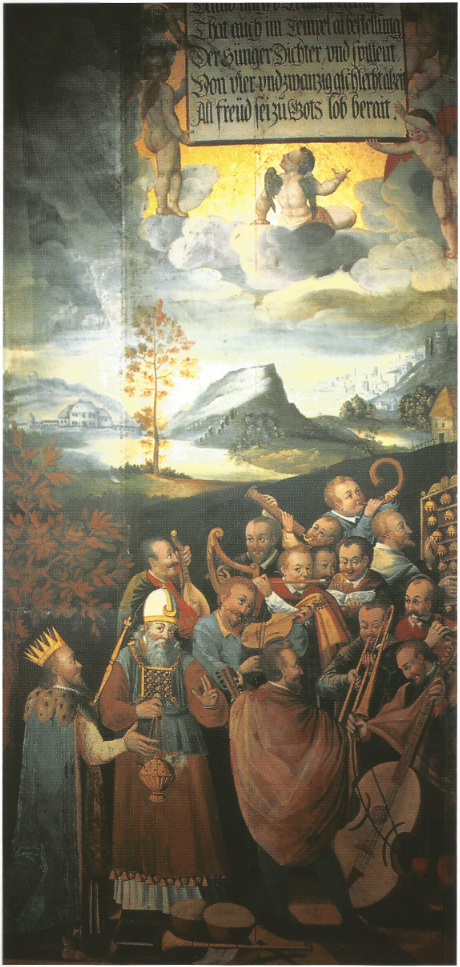
1598—Ferrara, Italy: In his Il Desiderio, Ercole Bottrigari lists trombones (tromboni) among the wind instruments of the Dukes of Ferrara (Boydell, Crumhorn 399).
1598—Hechingen, Germany: Celebrations for the wedding of Count Johann Georg von Hohenzollern and Franziska von Wild- und Rhein feature a lengthy procession that includes an ensemble of cornett, shawm, and trombone players (Bowles, Musical Ensembles 143).
1598—Kassel, Germany: Visual records by engraver Wilhelm Dilich of celebrations related to the christening of Princess Elizabeth von Hessen in 1596 include 3 different depictions of trombones (see below 3 images; public domain) (Bayerische StaatsBibliothek, Beschreibung der historischen und allegorischen Personen).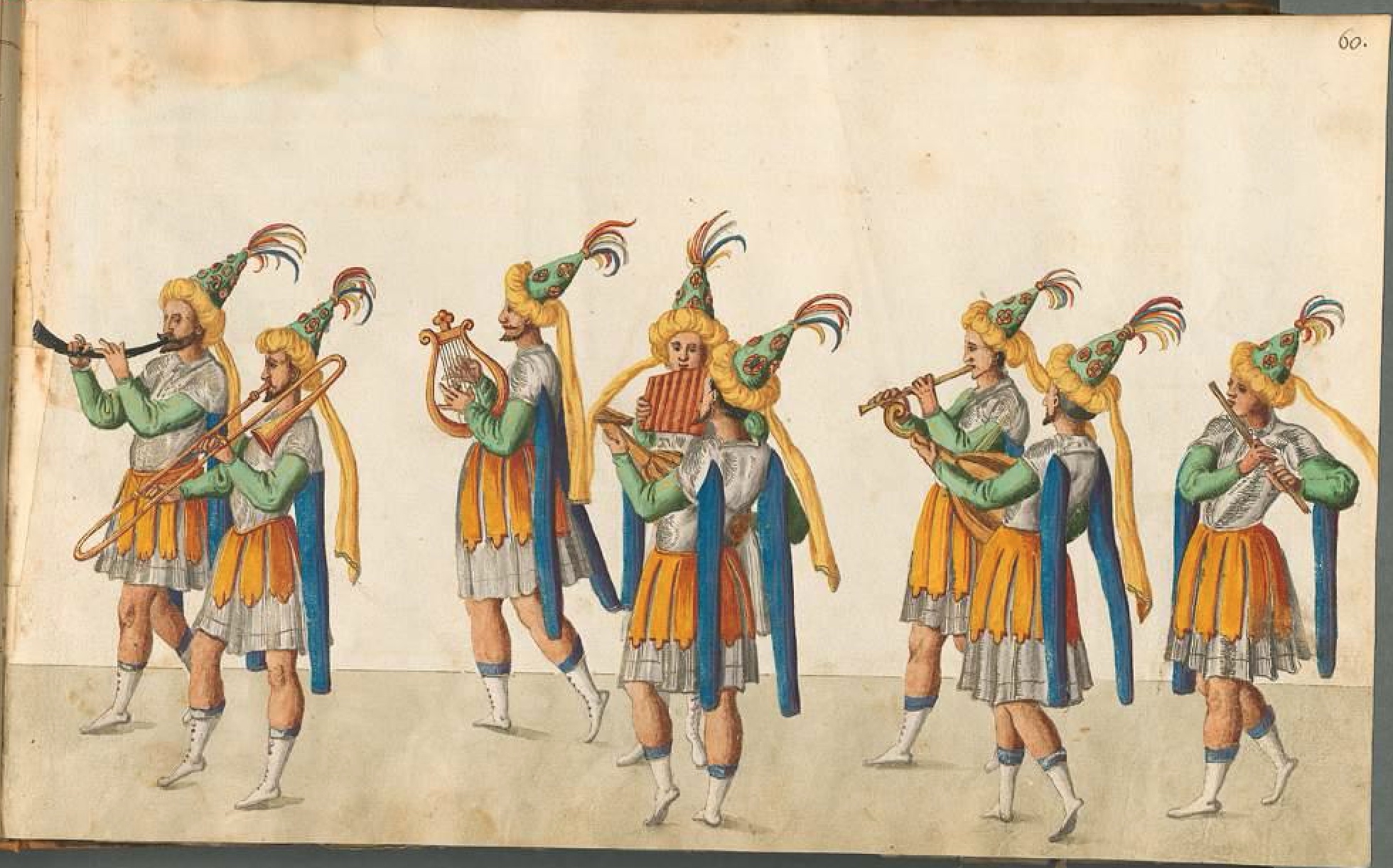


1598—England: Henslowe’s account book for the Lord Admiral’s Men (of the famous Rose playhouse in England) lists sackbut among the instruments in the company’s possession (Long Study 34).
1598—England: Records for Queen Elizabeth’s court show payment for liveries for one of the shackbuts (De Lafontaine 41).
1598—Rome, Italy: An organ is built for San Giovanni in Laterano (also known as Basilica of St. John Lateran) by Luca Blass and G. B. Mantano. Just below the left set of pipes and above the sculpture of David playing the harp is a decoration that includes a pair of trombones among several other instruments (see below image; photograph by Dennis F. Cramer).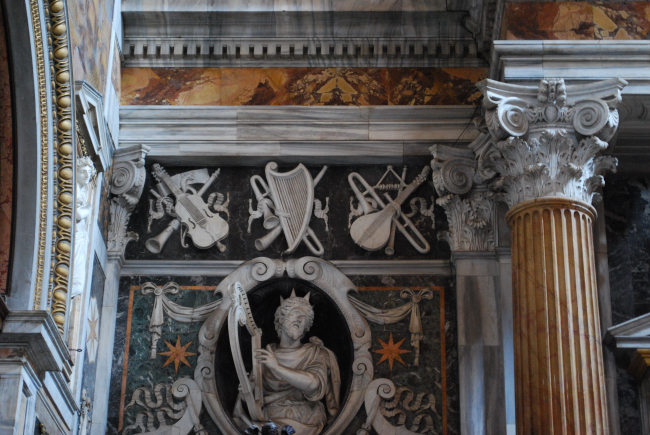
1598-1606—Valencia, Spain: Bartolomé Matarana paints a fresco of angel musicians in the the church of Real Colegio–Seminario de Corpus Christi that includes 2 trombones. Only the slide portions are obvious, although possible bell flares can be seen upon close inspection (see 2 details and full image below; public domain) (Olson, Angel Musicians).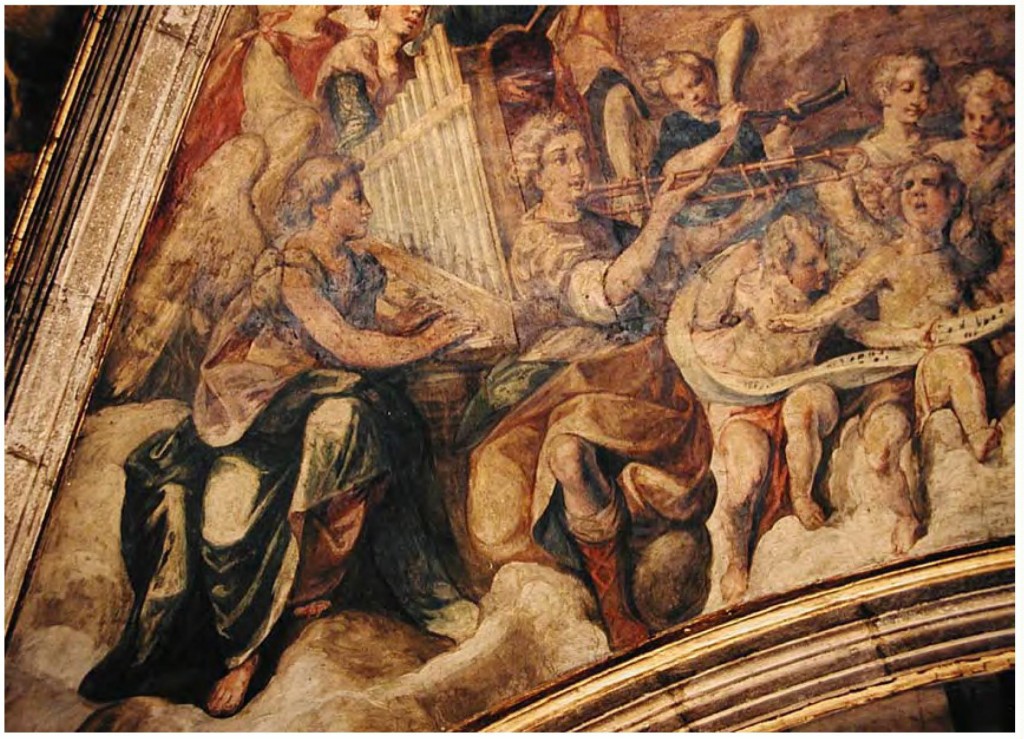
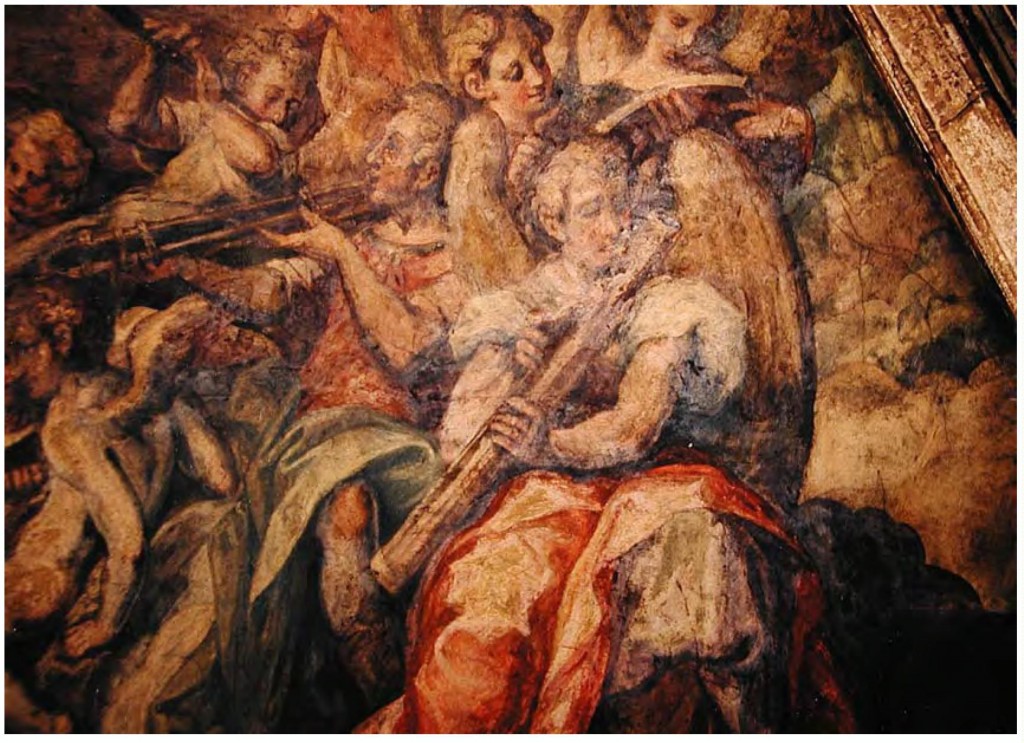

1599—London, England: A document signed by Queen Elizabeth approves the comparatively large salary, board, and livery of a sackbut player (Cooke, Queen Elizabeth and Her Court Musicians).
1599—London, England: Edmund Hooper, master of the children at Westminster Abbey, receives payment “for the cornets and sackbuts upon the queen’s day” (Parrott, Grett and Solompne Singing).
1599—London, England: Tailboys Dymoke includes the following in his poem, Caltha poetarum: or The bumble bee: “And now Diana doth present the man, with learned Lutes, & finest Virginals: With deepe Bandoras Diapasan, and with the cleare well sounding Clarigals, With subtle Sagbut, and the loud Cimbals…” (Dymoke 45).
1599—London, England: Antony Holborne composes Pavans, Galliards, Almains, and other short Airs both grave, and light, in five parts, for Viols, Violins, or other Musicall Winde Instruments. Based on the title, which specifies Musicall Winde Instruments, the pieces are presumably performed in various combinations that likely include trombone (Boyd 163).
1599—England: Ben Jonson’s play, Every Man out of His Humour, specifies a spoken prologue for the trombone player (Boyd 191).
1599—Poland: Records indicate trombonists among the instrumentalists of the Polish royal chapel (Przybyszewska-Jarminska, Baroque part I, 65).
1599—Leipzig, Germany: A new balcony is added to the tower of the city hall, and the town council subsequently orders the performance of a chorale or other “dignified” music from the tower every work day at 10:00 am. Later, during the second half of the 17th century, instrumentation for this music solidifies to an ensemble of 3 trombones and 2 cornetts (Whitwell, Baroque 157).
1599—Antwerp: An engraving from Graduale Romanum, published by Plantin and Moretus, depicts a group of singers accompanied by 4 instrumentalists, including one playing what may be a trombone (see below image; public domain). Special thanks to Aline Hopchet.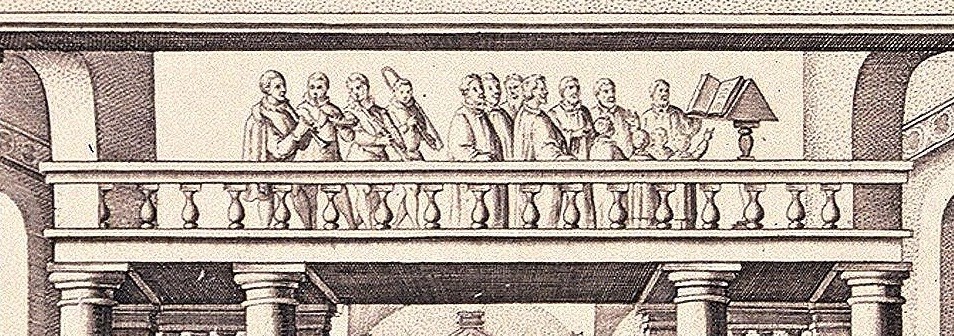
1600—Dutch artist Jan Harmensz Muller (or one of his followers) paints Das Fest des Belsazar (Belshazzar’s Feast), which includes an ensemble of what appears to be trombone, cornetto, and harp, performing from a balcony. The trombone is held awkwardly and the proportions of the cornetto are also unorthodox (see detail and full image, first two images below; public domain). A very similar image, a black and white print, is likewise attributed to Muller, sometimes at a slightly earlier date (1598) (see third image, below; public domain).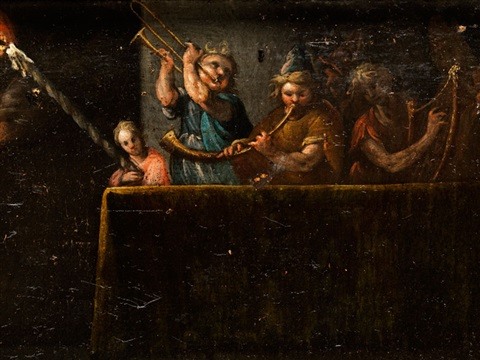
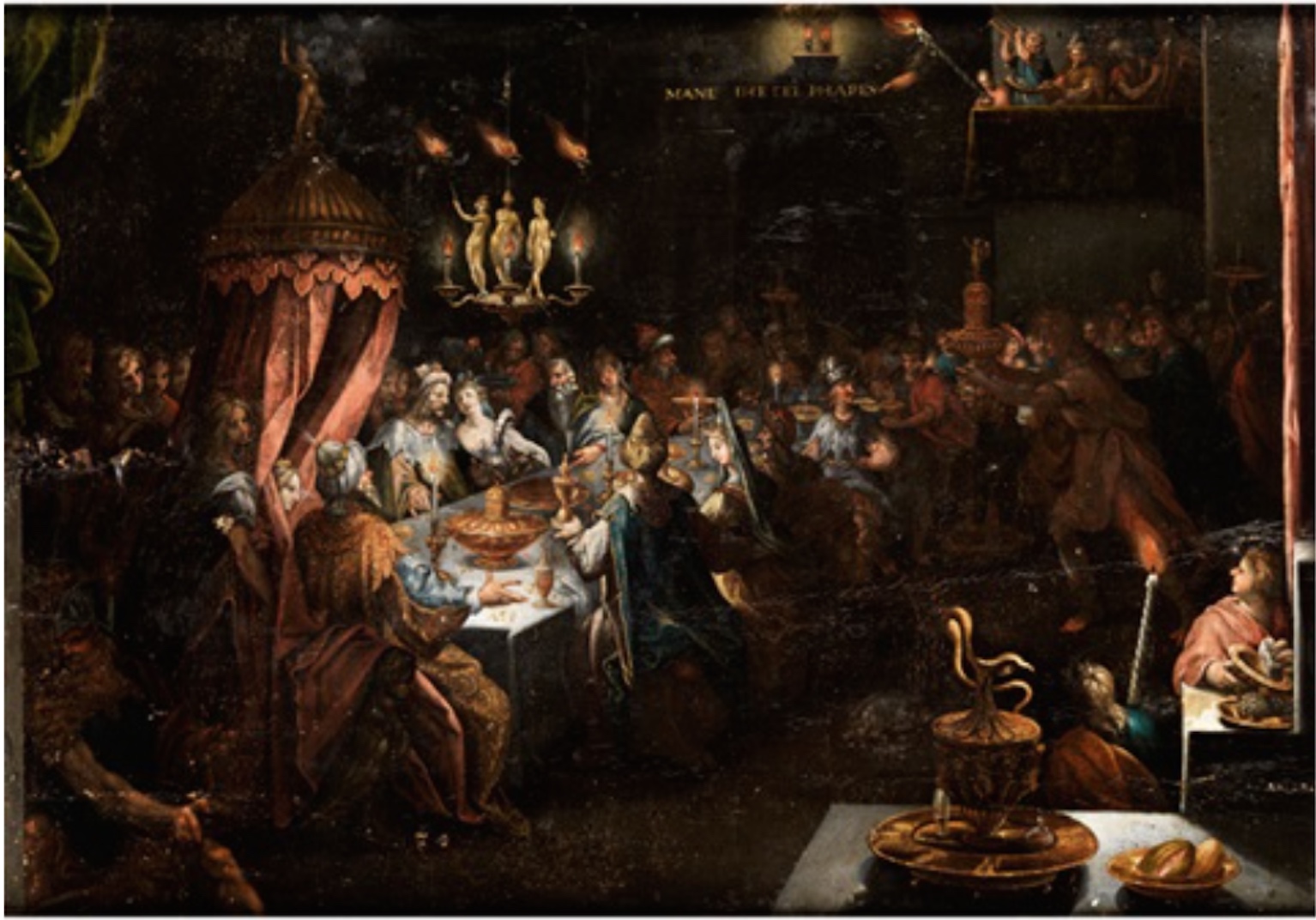
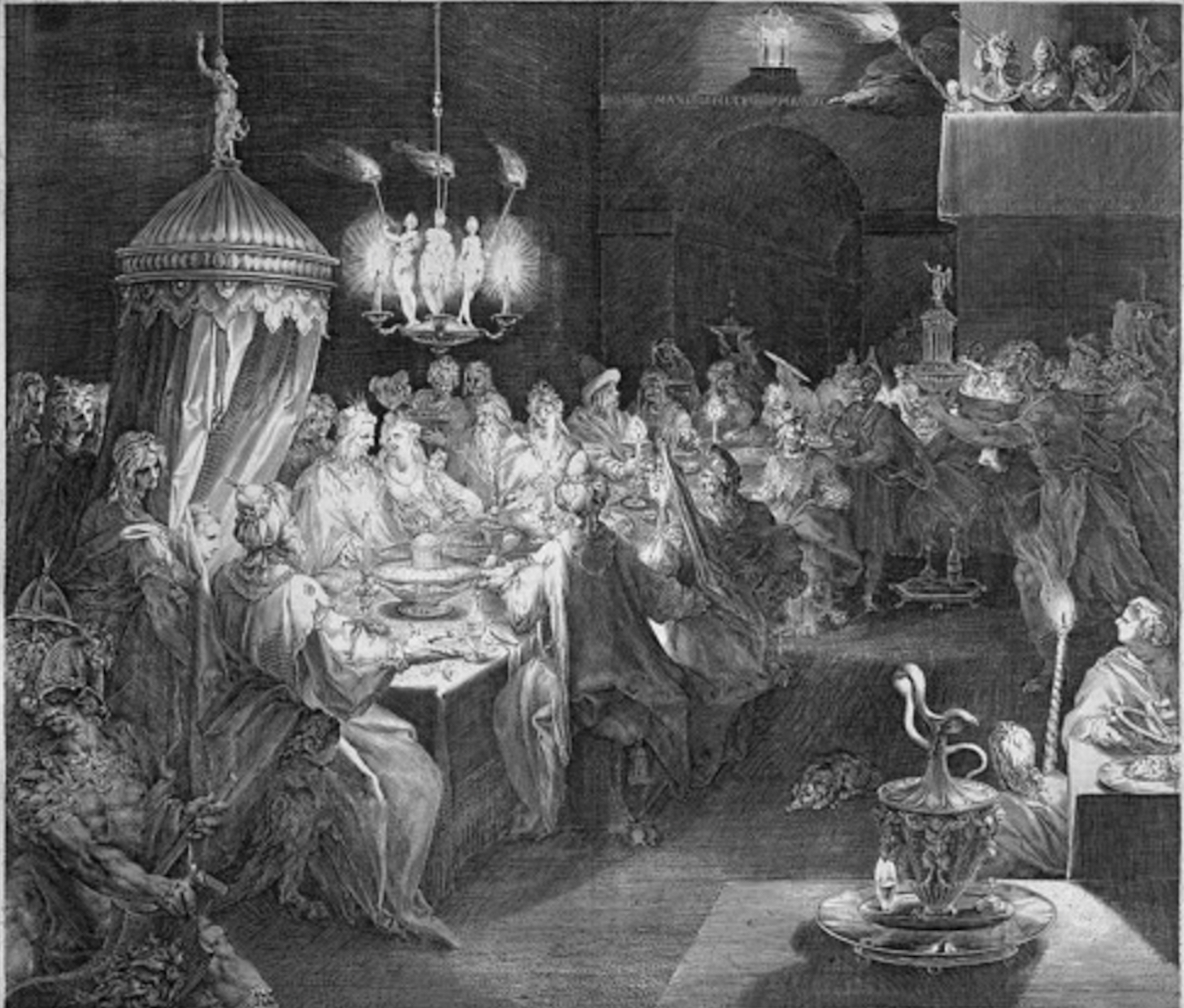
1600—Rome: A performance at St. Peter’s Basilica features the addition of several instruments to normal performing forces, including 2 cornettos and 2 trombones (Kurtzman, Monteverdi Vespers 116)
1600—Rome: San Luigi Cathedral includes in its permanent ensemble a trombone, a cornetto, and a violin (Kurtzman, Monteverdi Vespers 116).
1600—Rome: The pifferi, or civic wind band, consists of 4 trombones and 2 cornetts (Kurtzman, Trombe).
1600—Padua, Italy: Porta complains that, because the capella at St. Anthony’s is short by 10 musicians (including 1 trombonist), due to relocation or retirement, it is no longer possible to perform music for double choir (Bettley, L’Ultima Hora).
1600—Venice, Italy: Alvise Grani begins employment as trombonist with the cappella musicale (Baldauf-Berdes 188).
1600—Venice, Italy: Giovanni Artusi’s L’Artusi overo delle imperfettioni mentions trombones (tromboni) among instruments that can be played with variable tunings (Boydell, Crumhorn 399).
1600—Venice and Ferrara, Italy: Giovanni Artusi praises musical performances of the nuns at Ferrara’s San Vito in his L’Artusi overo delle imperfettioni. Among the instruments the nuns perform on are numerous wind instruments, including cornetts and trombones (tromboni). Regarding their musical proficiency, Artusi offers high praise for the nuns, specifically mentioning “their grace, the beautiful manner of phrasing, of giving life to the passagework” (Boydell, Crumhorn 298). Artusi also discusses numerous lessons that can be learned from the nuns’ performance, including which instrument a person should play: “Those who are experienced on the trombone know how to adapt themselves to other instruments. However, they do not merely forsake this part for that, but they use the instrument on which, through long practice and natural inclination, they are excellent. They do not neglect proper instinct and natural choice, for example, by choosing the lute or double harp when they know how to play on other instruments more skillfully. Instead they pay attention to those toward which nature has given them particular inclination, and on which they have practiced long and assiduously” (Artusi 135).
1600—Bologna, Italy: The nuns of San Giovanni Battista request license from the Congregation of Bishops for outside trombone lessons, adding that they have recently introduced the instrument into their ensembles (Monson, Disembodied 264).
c. 1600—Giuseppe Bonfiglio’s Trinita con la Vergine e Ognissanti includes an angel trombonist (see below detail; public domain) (Museo Civico, Castroreale, Sicily).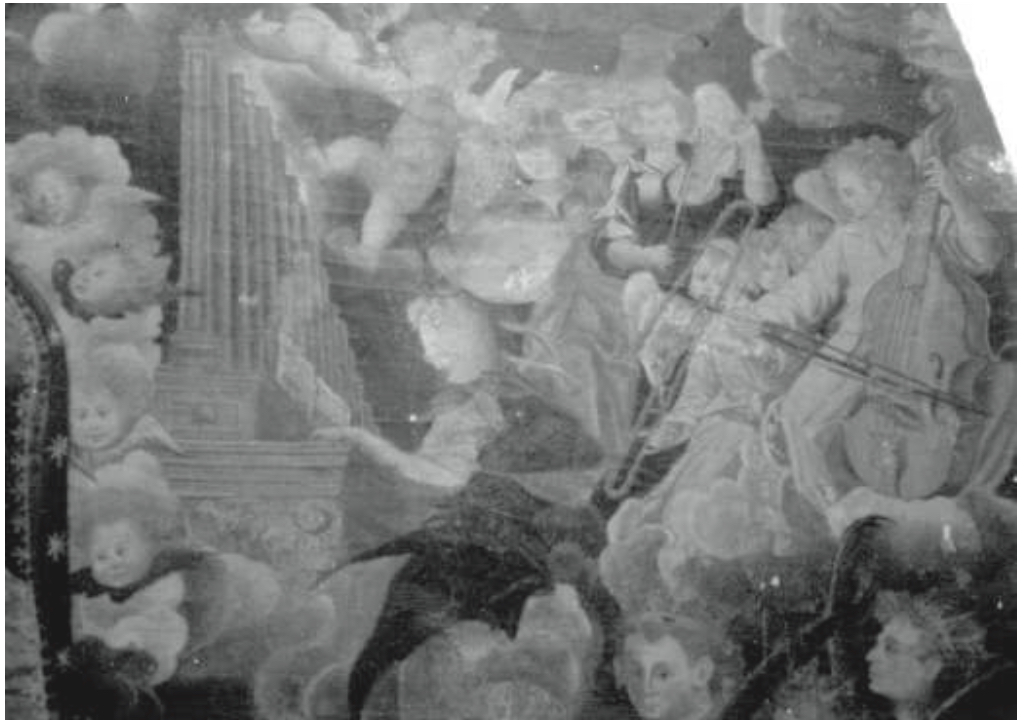
c. 1600—Aurelio Virgiliano offers the earliest diagrammatic representation of trombone slide positions in his treatise, Il dolcimelo (see below image; click on picture to expand; public domain) (Herbert, Sackbut 73; Virgiliano 51-52).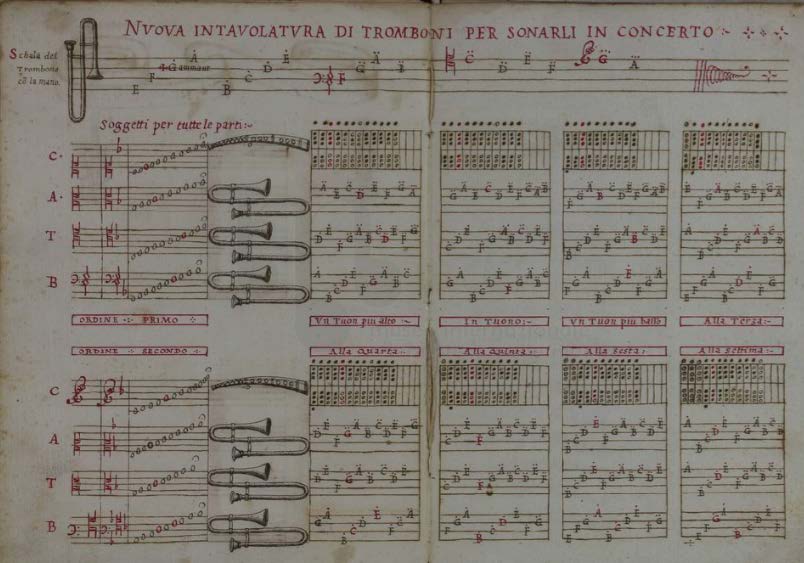
c. 1600—Italy: A musician by the name of Luigi Zenobi includes the following in a letter: “The players of the trombone are judged by their correct intonation, by their soft tone, by their avoiding a mooing sound, and by their imitation of the human voice in the bass range, like the cornett in the high range, by their ability to play semitones and in transposition when necessary…by their grace, by the imitation of a boy’s voice, in the choiceness and variety of diminutions, in the graceful manner of holding the instrument, in not contorting the body while playing, and in many other things” (Blackburn, Composition 61, 103).
c. 1600—John Coprario writes “Verse” for cornett, sackbut, and organ (cornett and sackbut parts now lost) (Whitwell, Catalog Before 1500 38).
c. 1600—Siena, Italy: Pietro Sorri’s painting, “Incoronazione delle Vergine” in the Chiesa di San Sebastiano in Vallepiatta includes an angel playing what appears to be a trombone with an oddly-angled bell (see detail below; public domain) (special thanks to Bruce Dickey).
c. 1600—Venice, Italy: Two trombones are included in trophies (decorative clusters) of instruments above the organ pipes at San Giorgio Maggiore (see below image; public domain).
c. 1600—Germany: Moritz von Hessen, Pavan for 5 trombones and continuo, from a collection of pavans, galliards, and intradas (Carter, Performance in 17C, 129; Whitwell, Catalog Baroque 136).
c. 1600—Le diner imperial, a print by an anonymous artist, includes 2 trombones among the group of musicians (see detail and full image below; public domain) (French National Library).
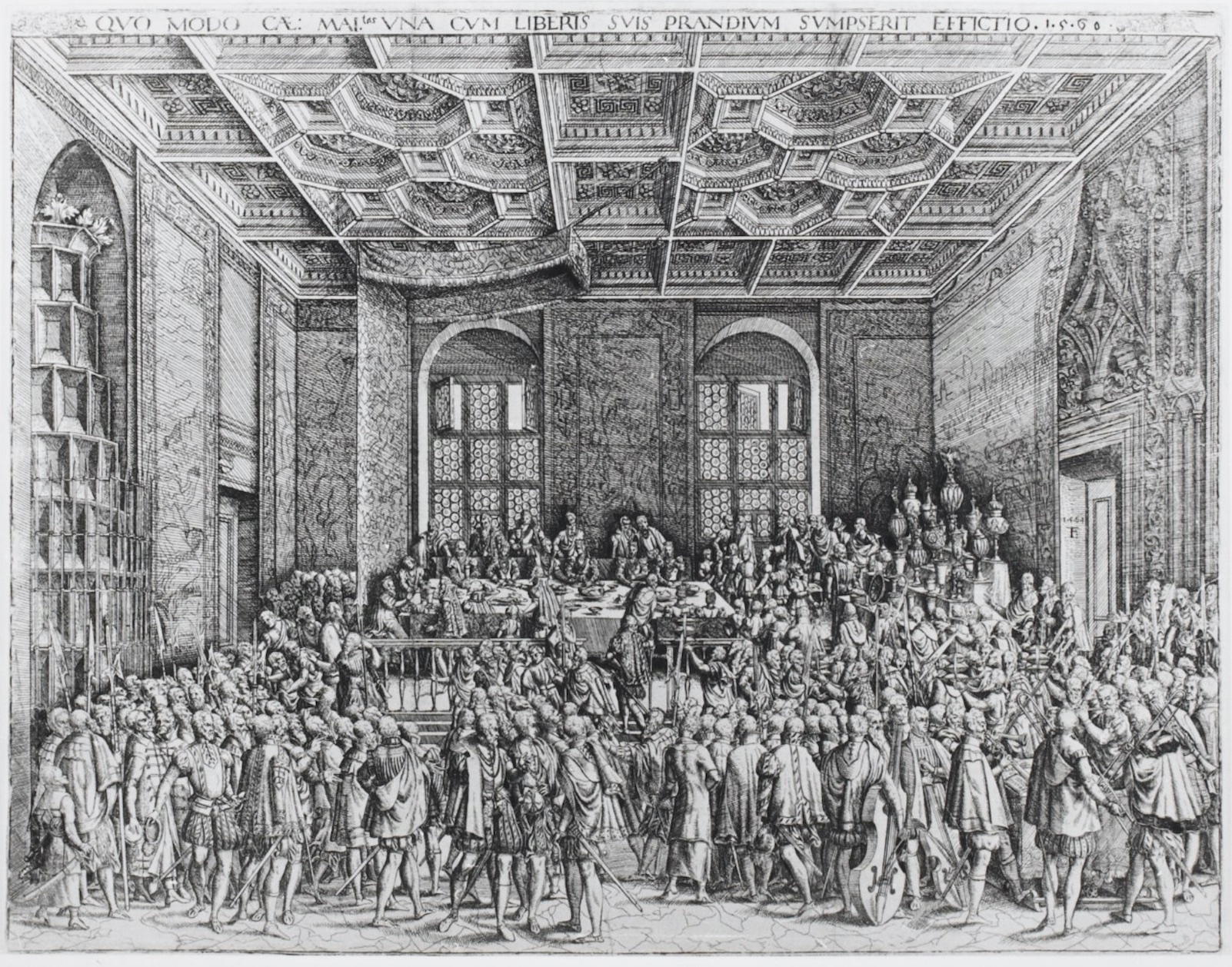
c. 1600—Fackeltanz bei Fürstenhochzeit, an anonymous image, possibly from Germany, depicts a torch dance at a prince’s wedding. Instrumentalists supplying the dance music from a balcony include a tombonist (see below image; click to expand; public domain) (Salmen, Tanz im 17 153).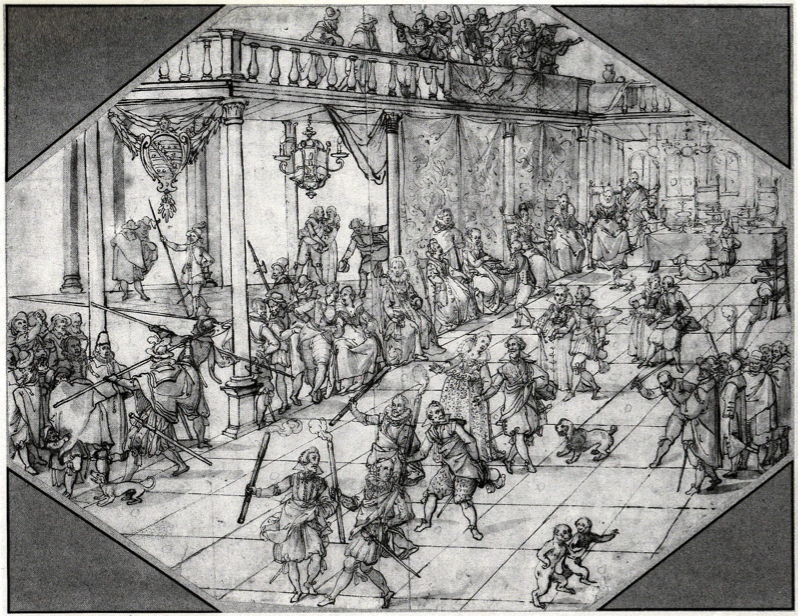
c. 1600—London, England: Records of St. George’s Day celebrations at Whitehall note, “There was short service, the clergy all being in their rich copes, with princely music of voices, organs, and cornets and sackbuts, with other ceremonies and music” (Parrott, Grett and Solompne Singing).
c. 1600—Milan, Italy: Camillo Procaccini’s fresco in Milan’s church, Sant’Angelo (officially Santa Maria degli Angeli) features an angel playing trombone (see below image; public domain) (source: wikimedia commons). For additional documentation, see Neilson, Camillo Procaccini: Paintings and Drawings, pl. 77.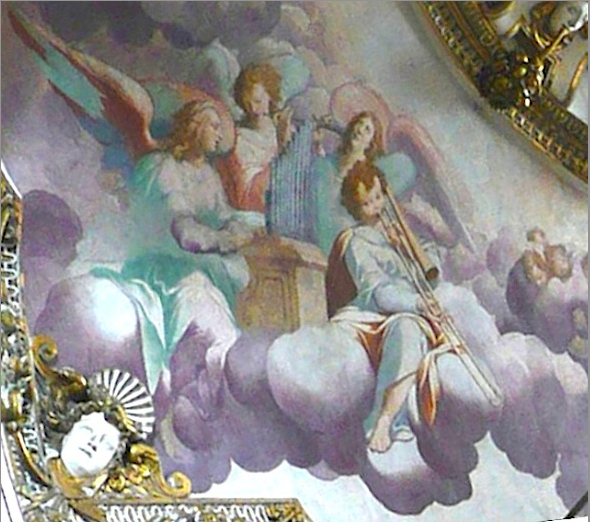
c. 1600—Legnano, Italy: A lunette painting by Giovan Pietro Luini in the Basilica of San Magno depicts an angel trombonist (see below image; public domain).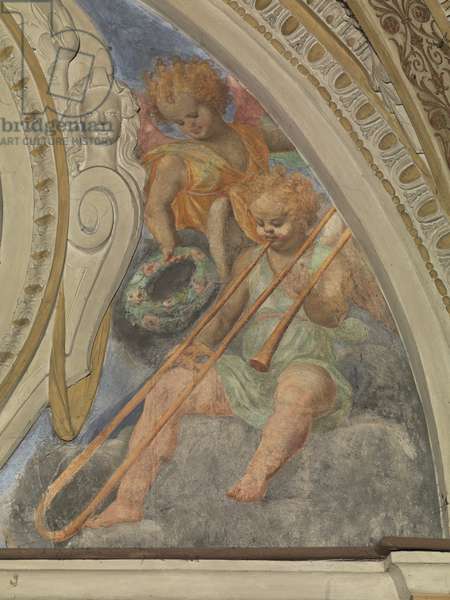
Late 16th century—Italy: A chalk drawing variously ascribed to Alessandro Allori, Agnolo Bronzino, the circle of Vasari, Baccio Bandinelli, Johannes Stradanus, and Bernardino Campi includes a man playing what appears to be a trombone among a group of musicians in a concert scene (see below image; public domain) (McCullagh 280; Art Institute of Chicago).
Late 16th century-1732—Venice: Trombonists appear on regular payroll at St. Mark’s (Guion, Trombone 4).
Late 16th century—Italy: Bolognese painter and engraver Francesco Brizio includes trombone among numerous angel-musicians in his study, Lunette with Musical Angels in the Clouds (see detail and full image, below; click picture for larger version; public domain) (Bohn 532).
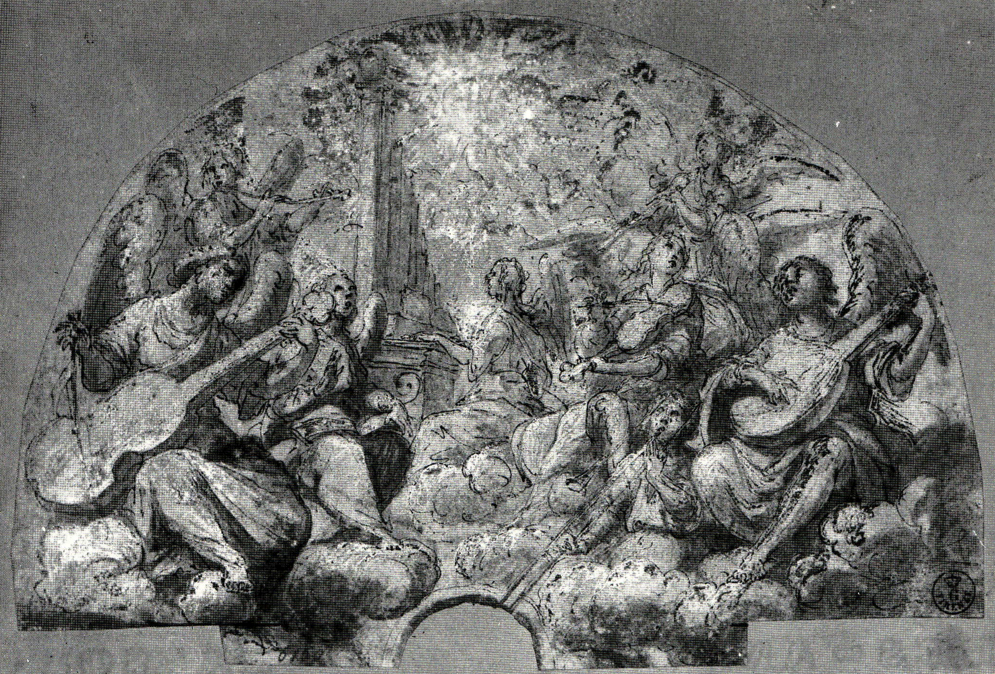
16th-17th century—Southern Germany: An inlaid panel with various fruit woods by an unknown artist depicts a richly-dressed woman playing trombone (see below image; public domain) (Cambi Auction House; cambiaste.com; accessed 10.10.23).

